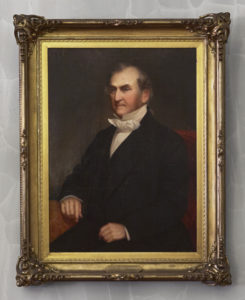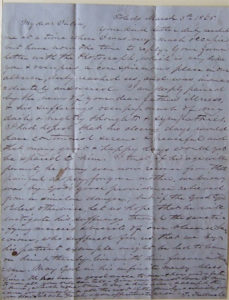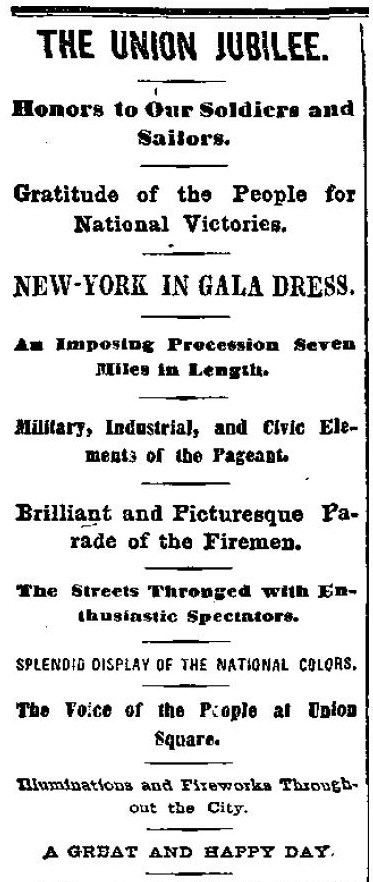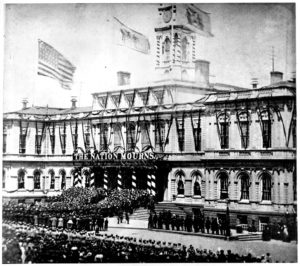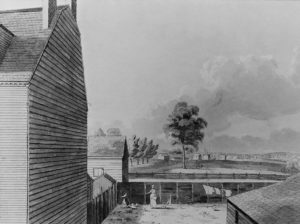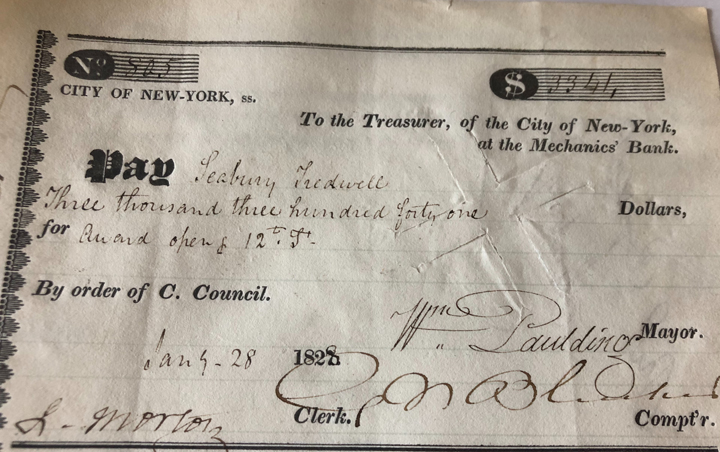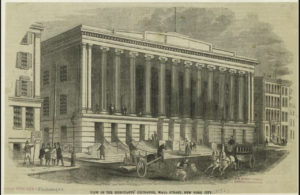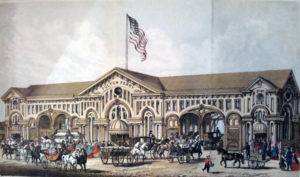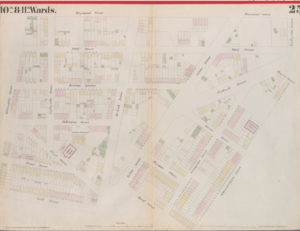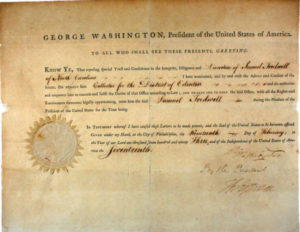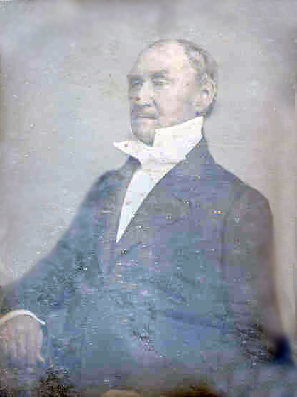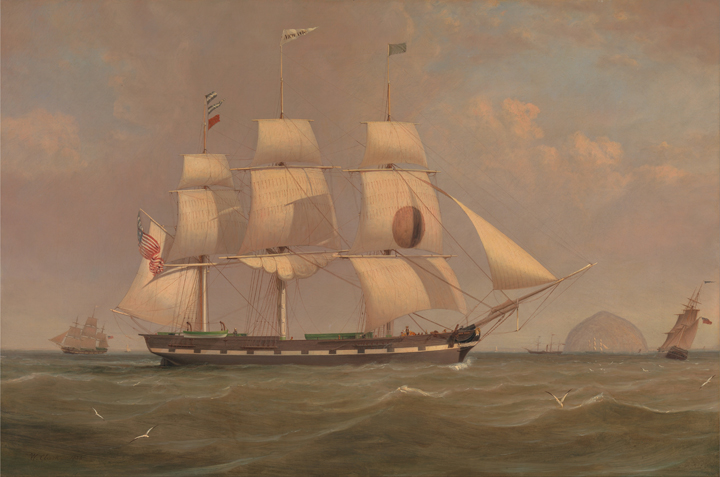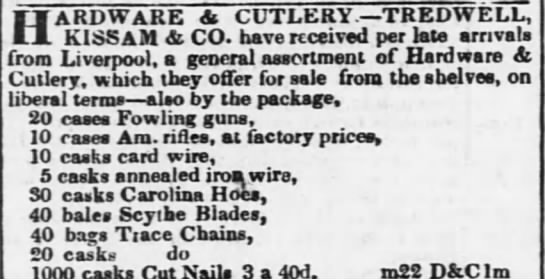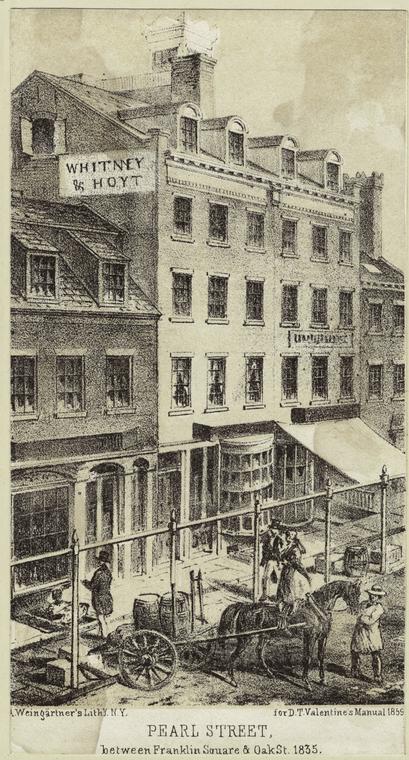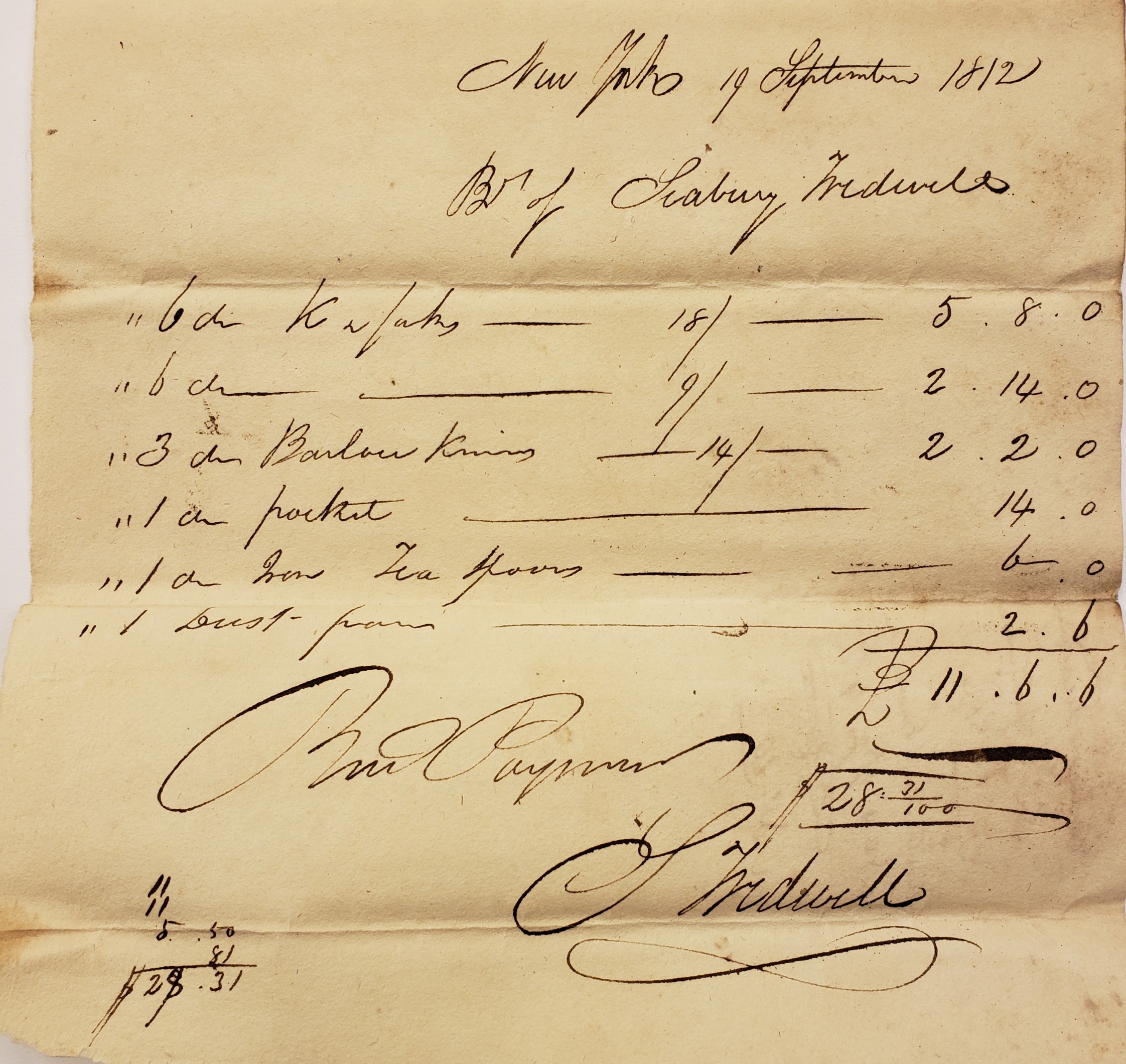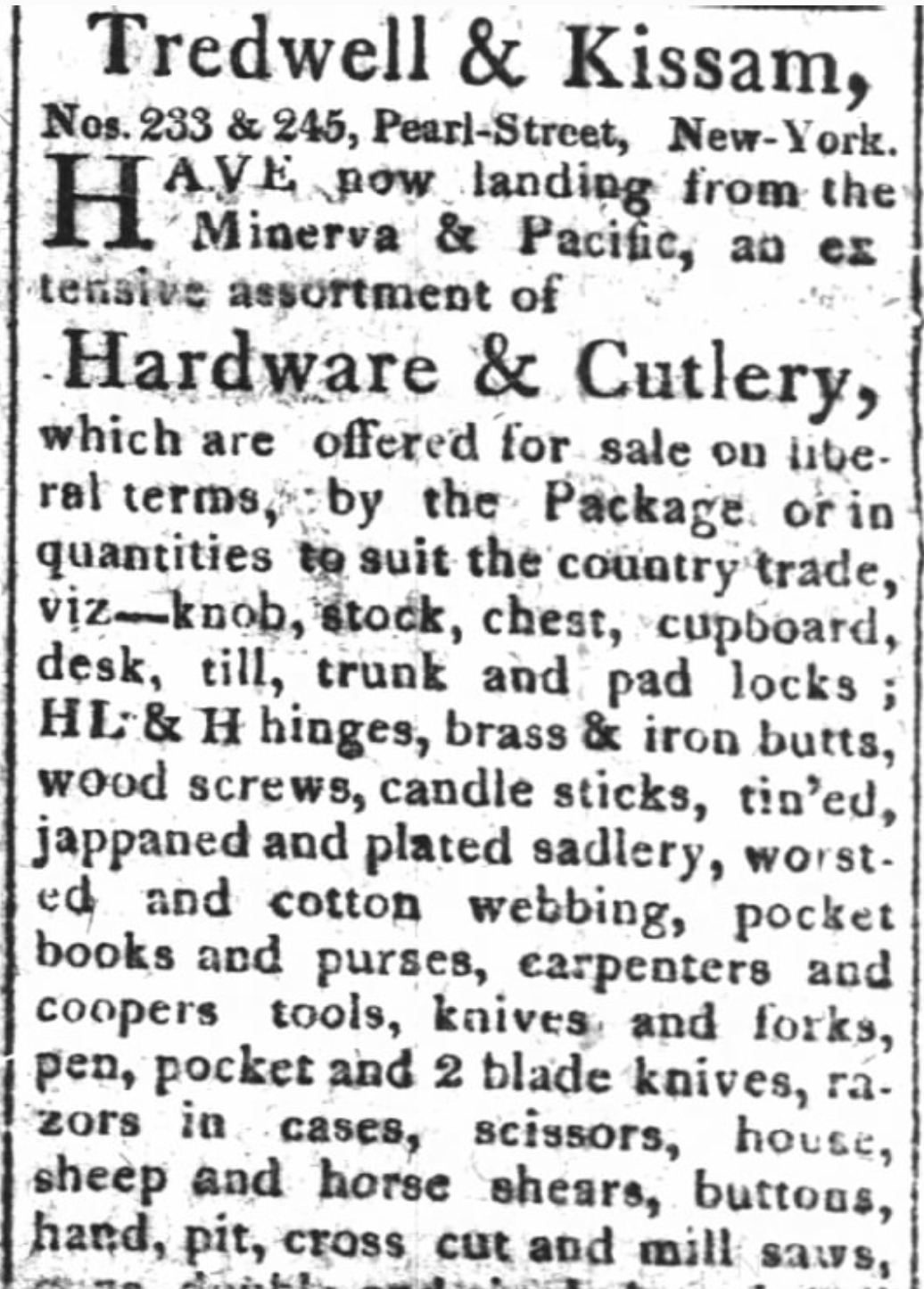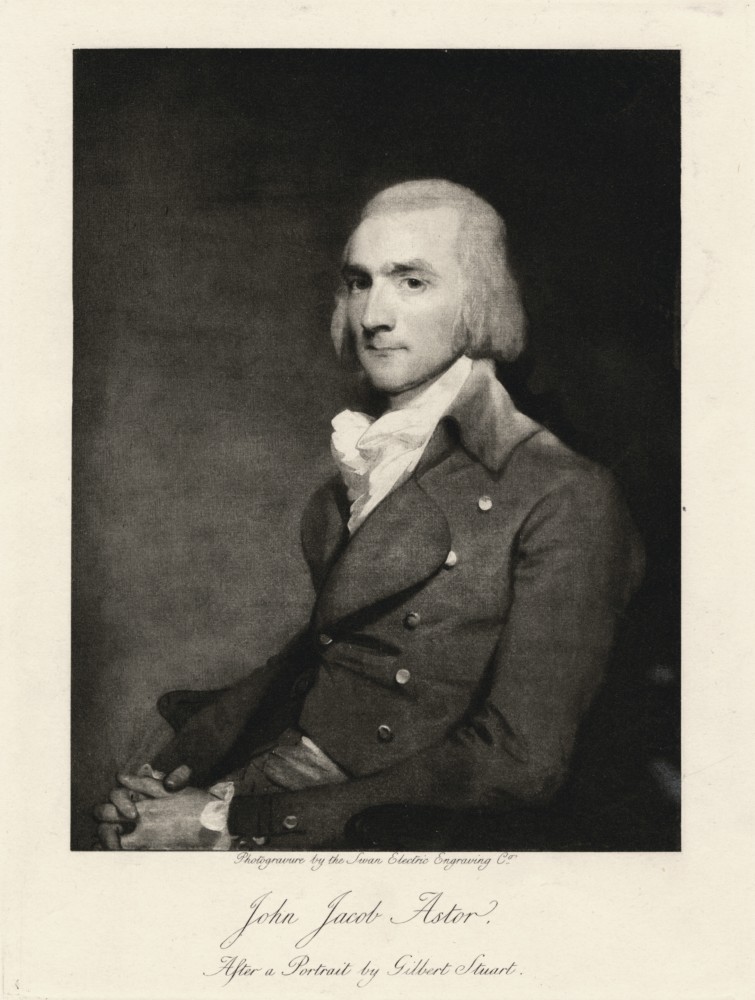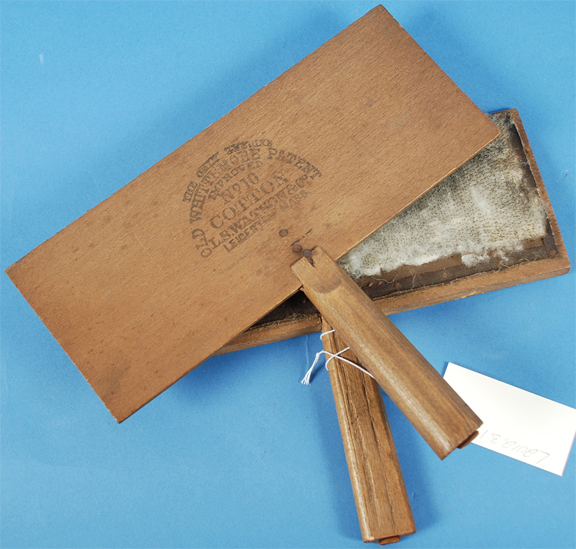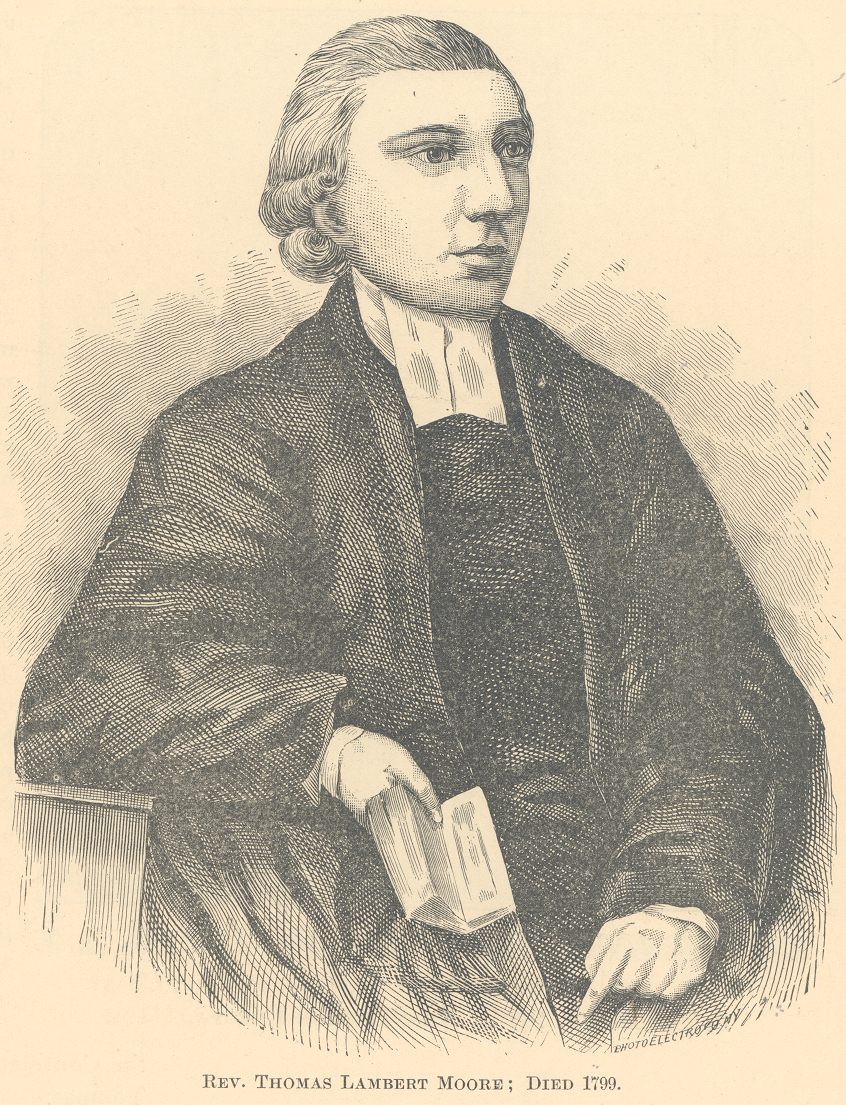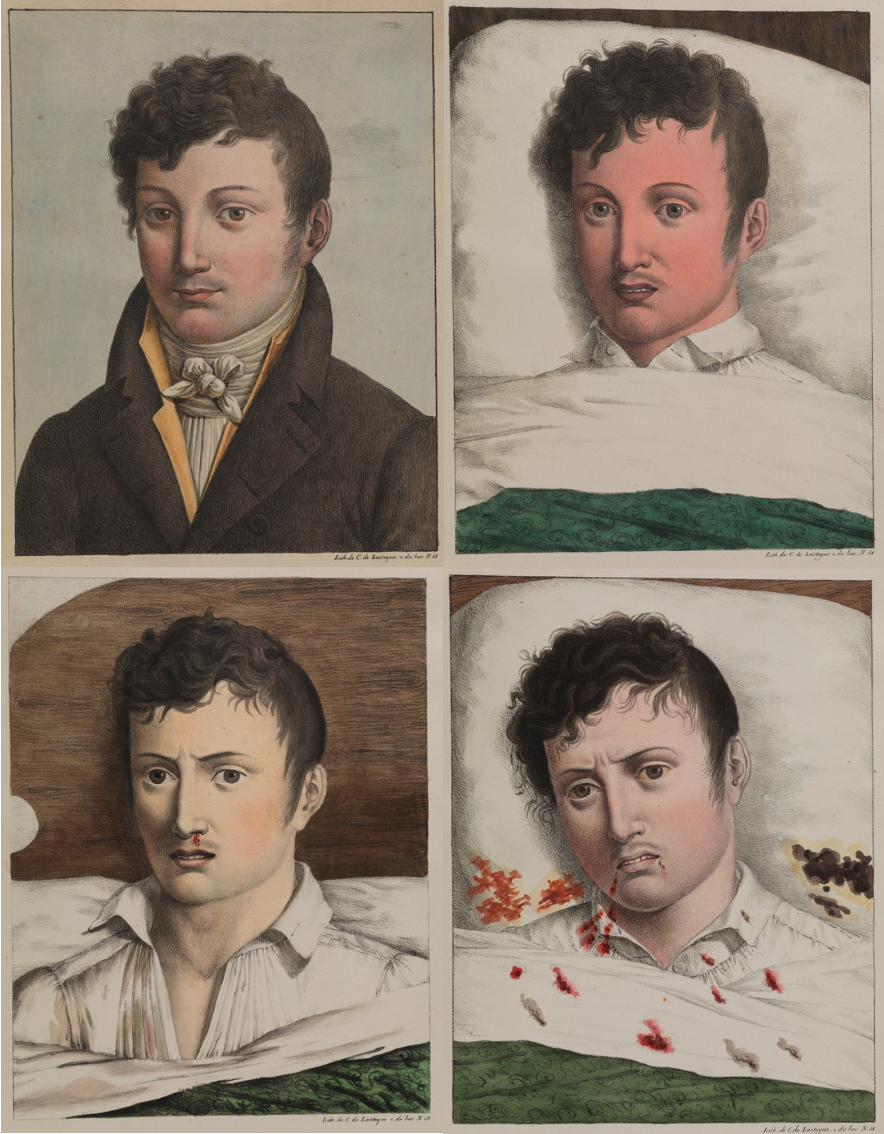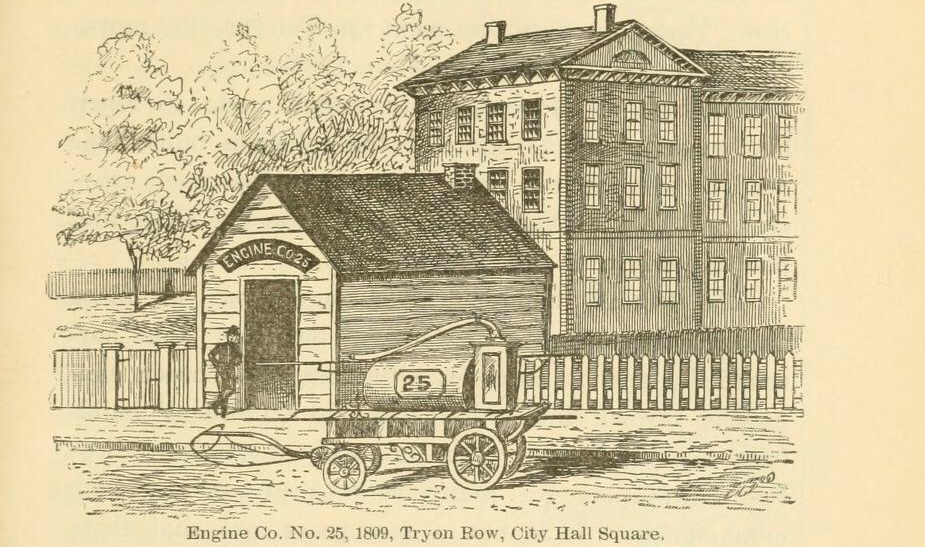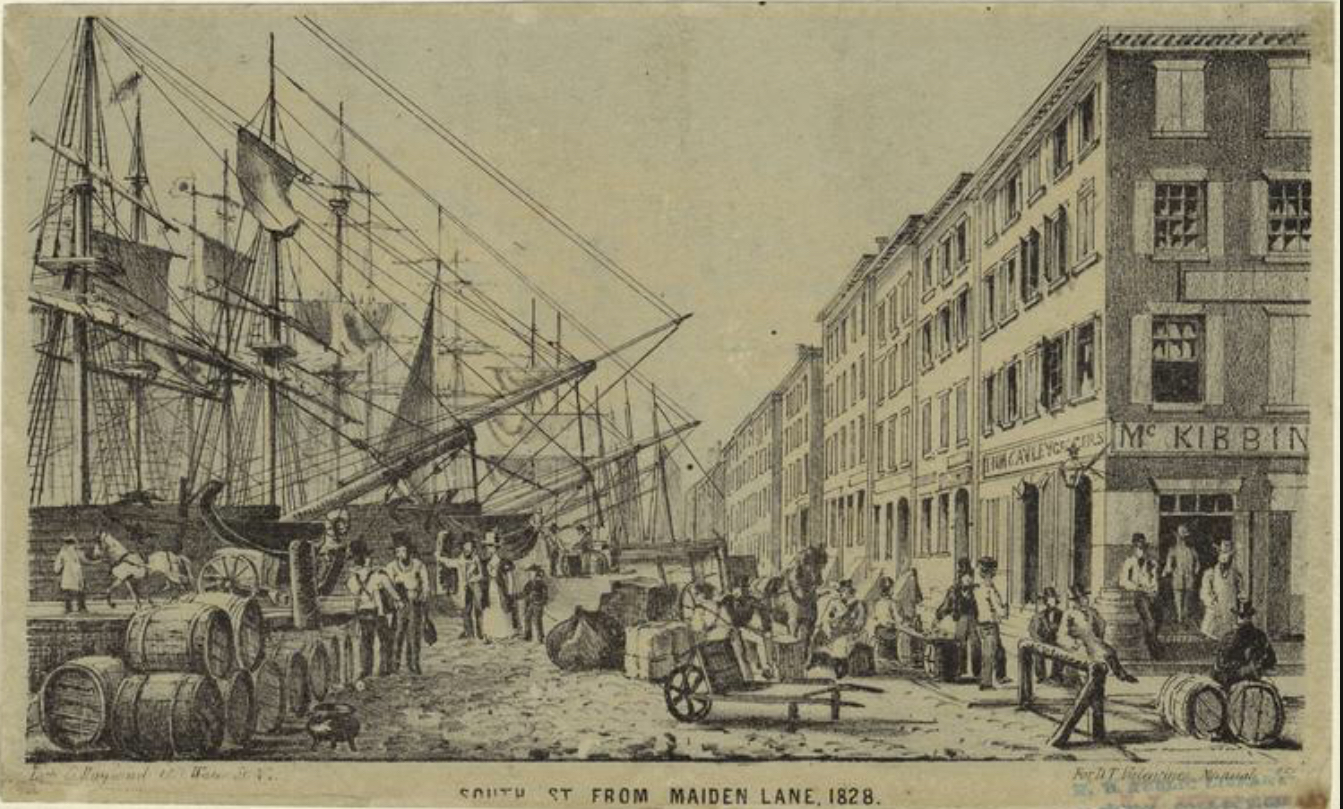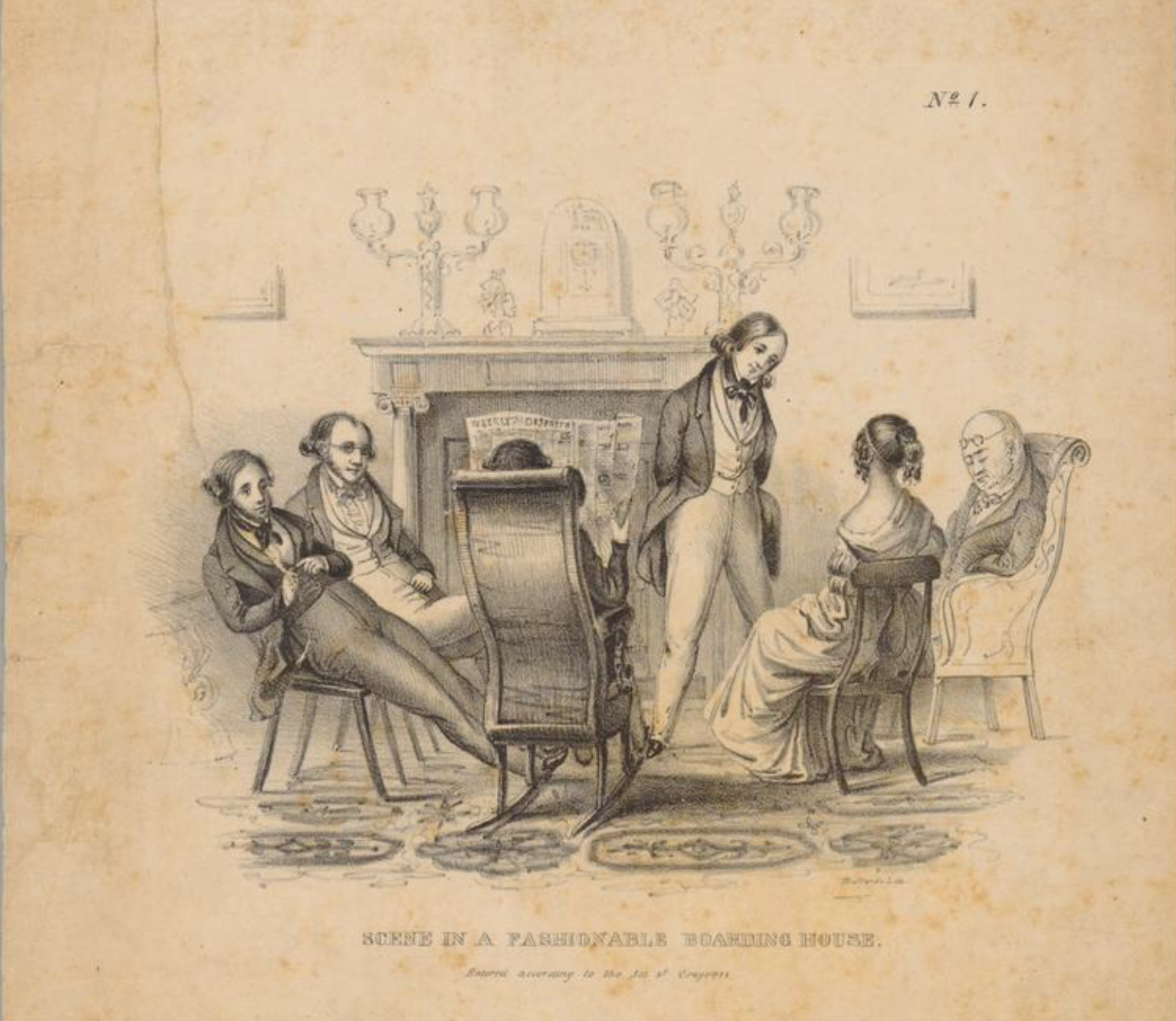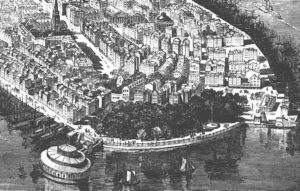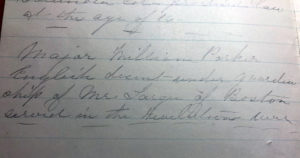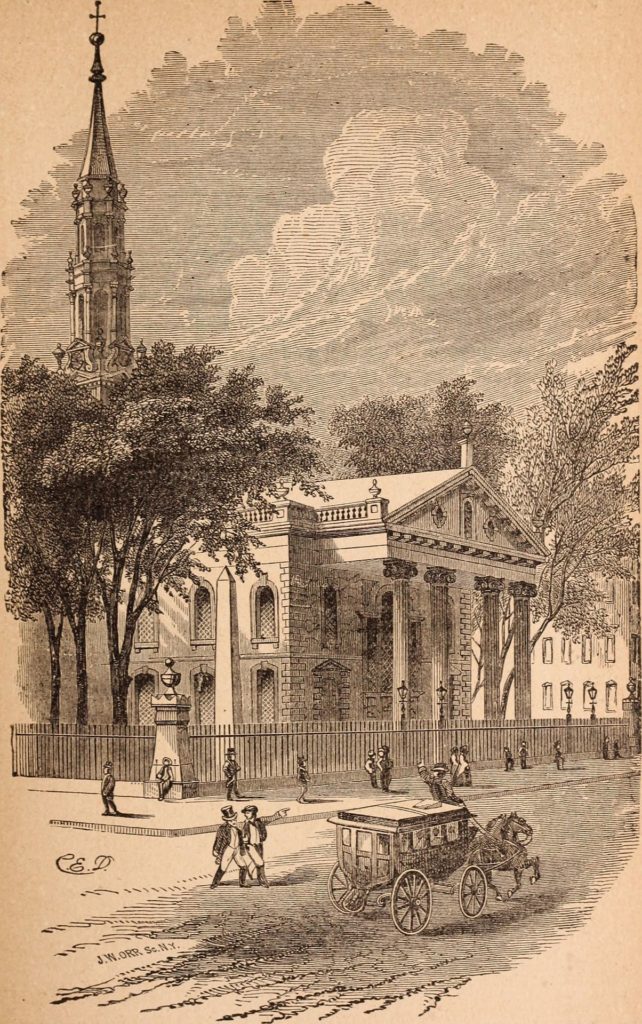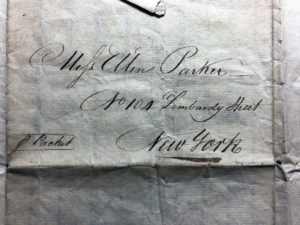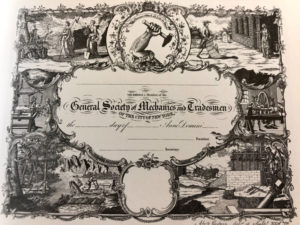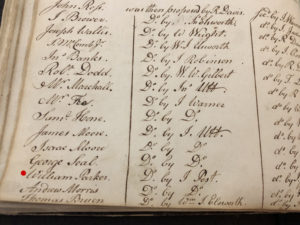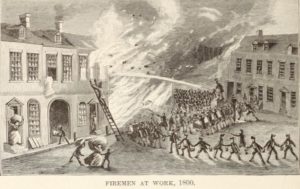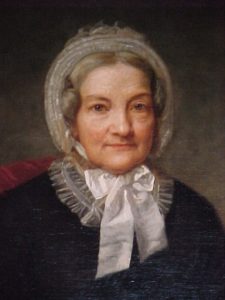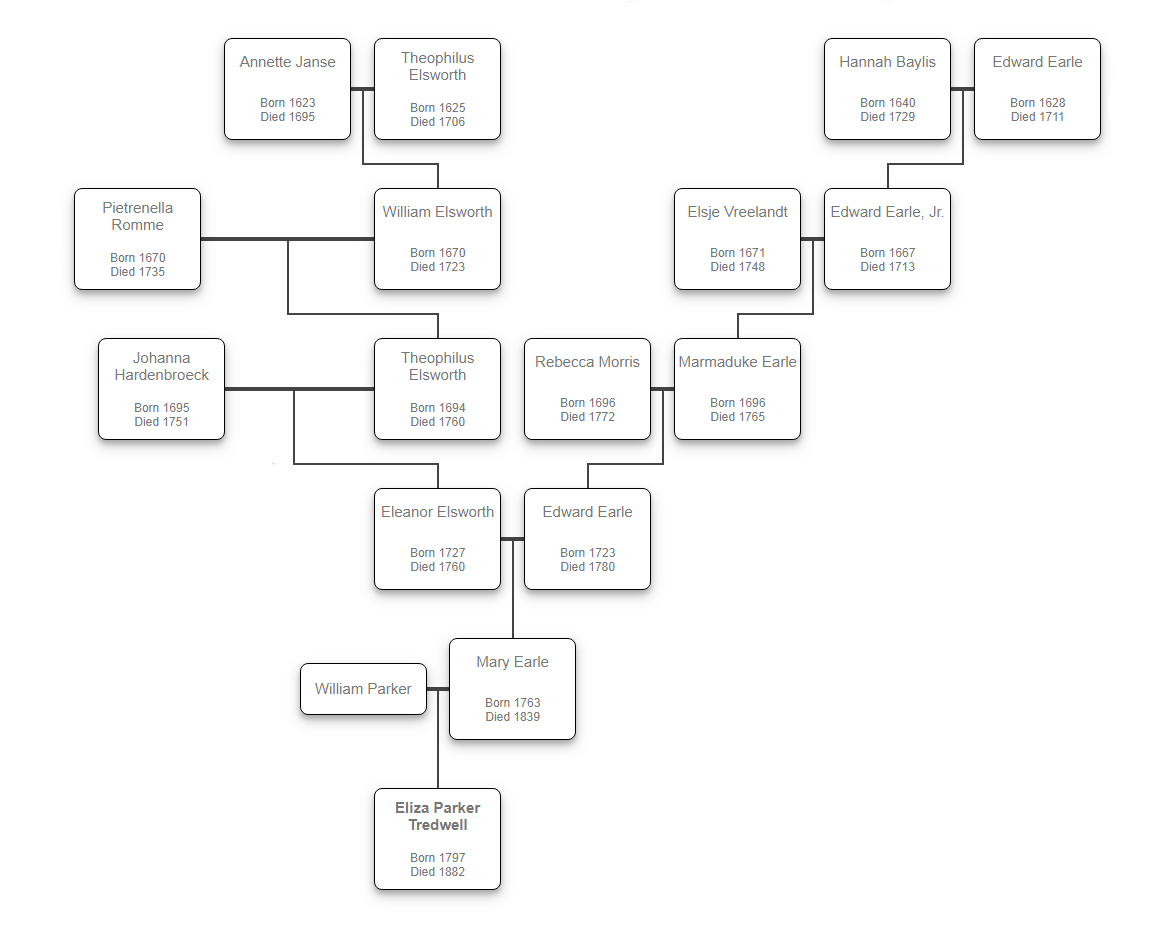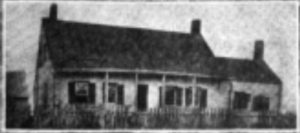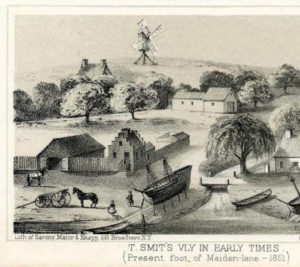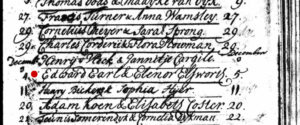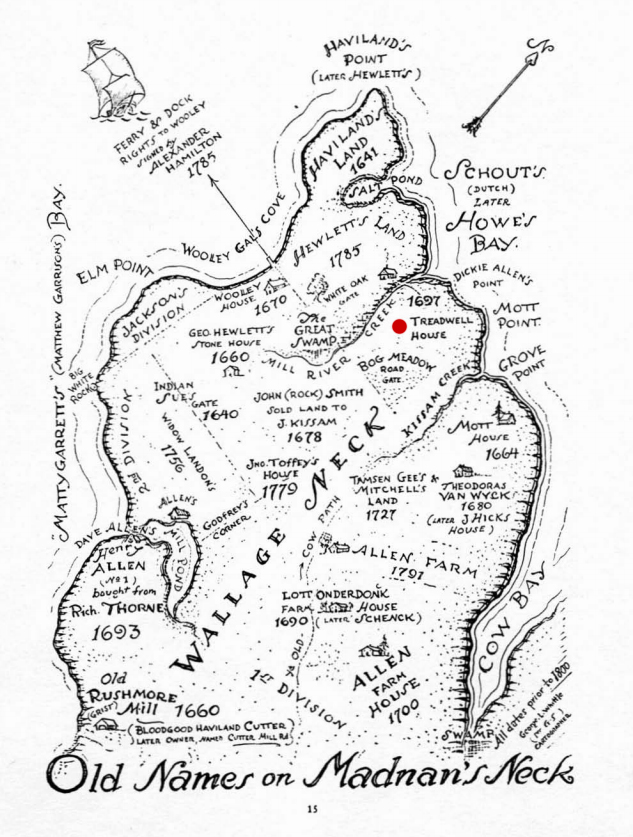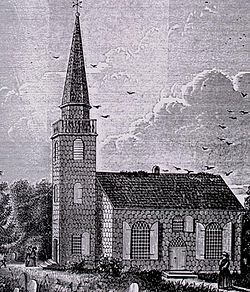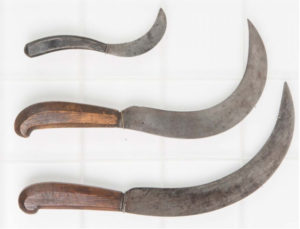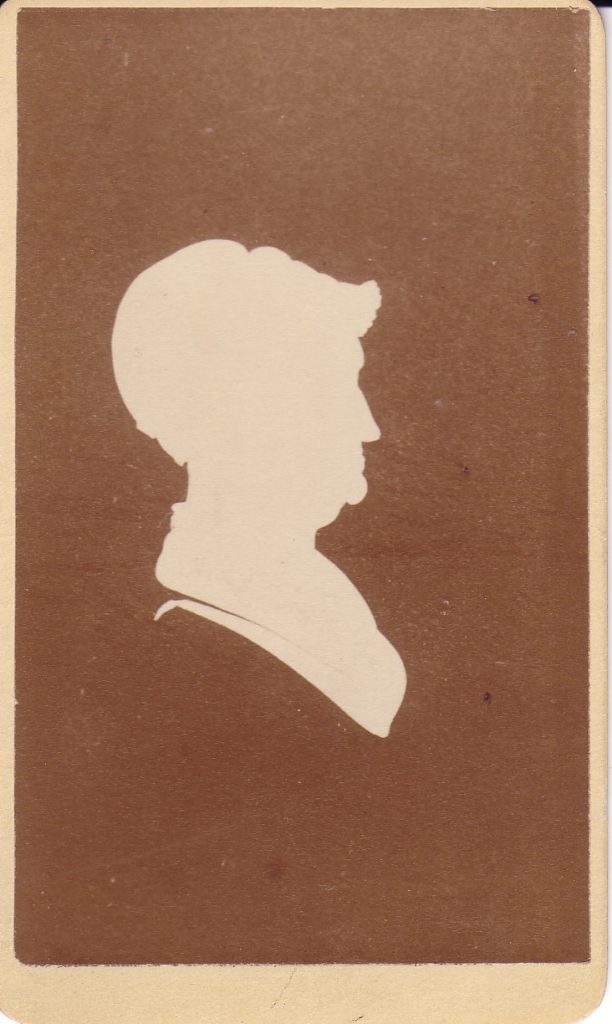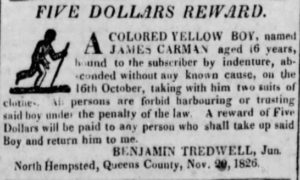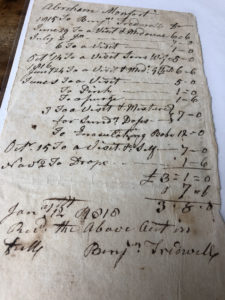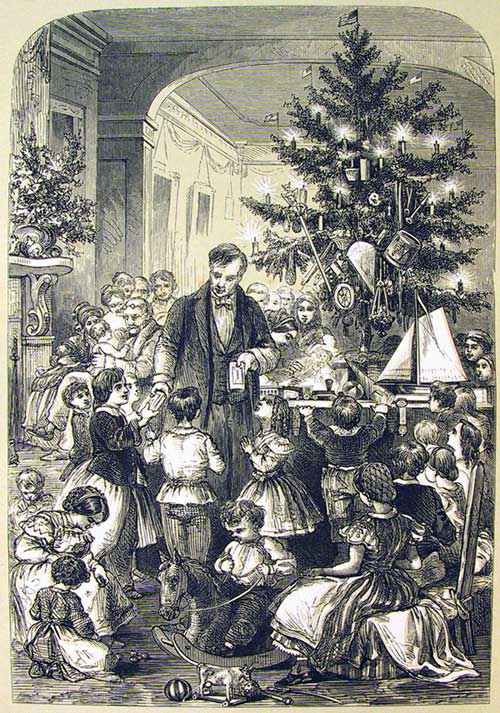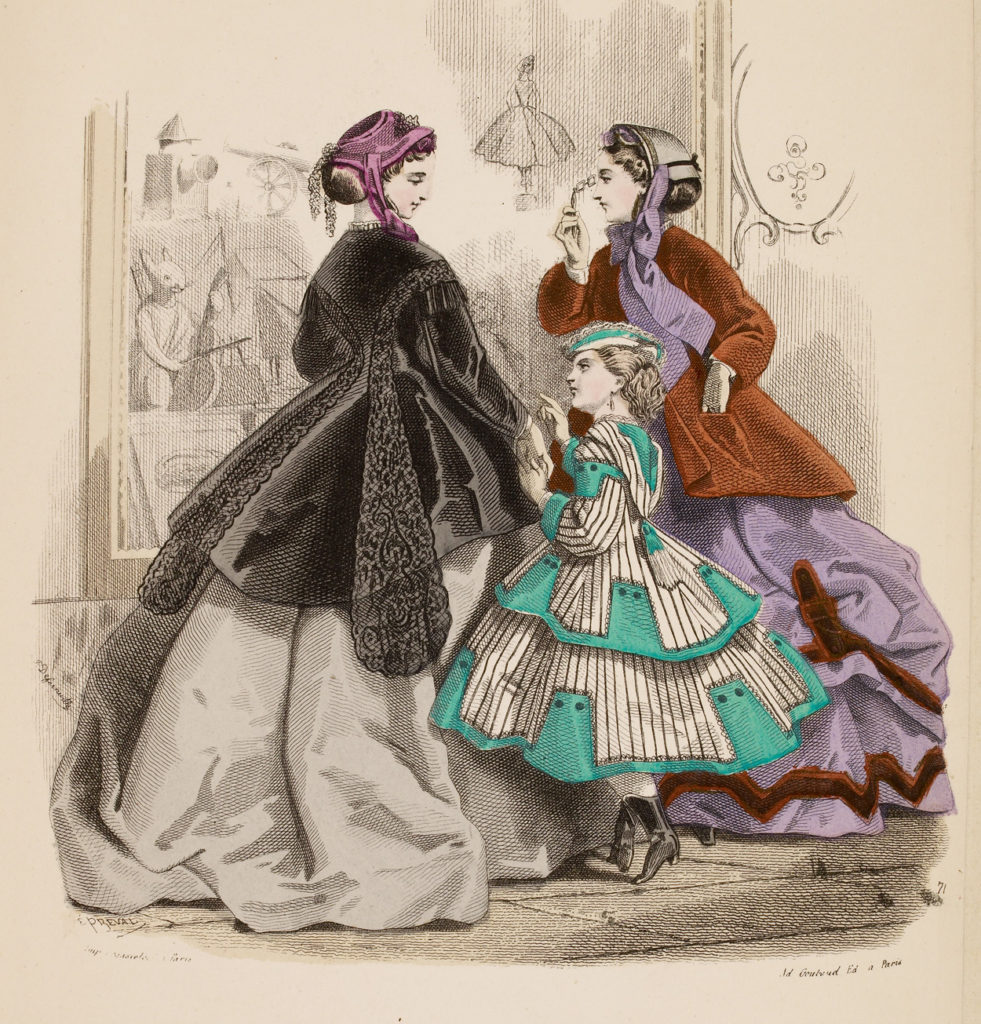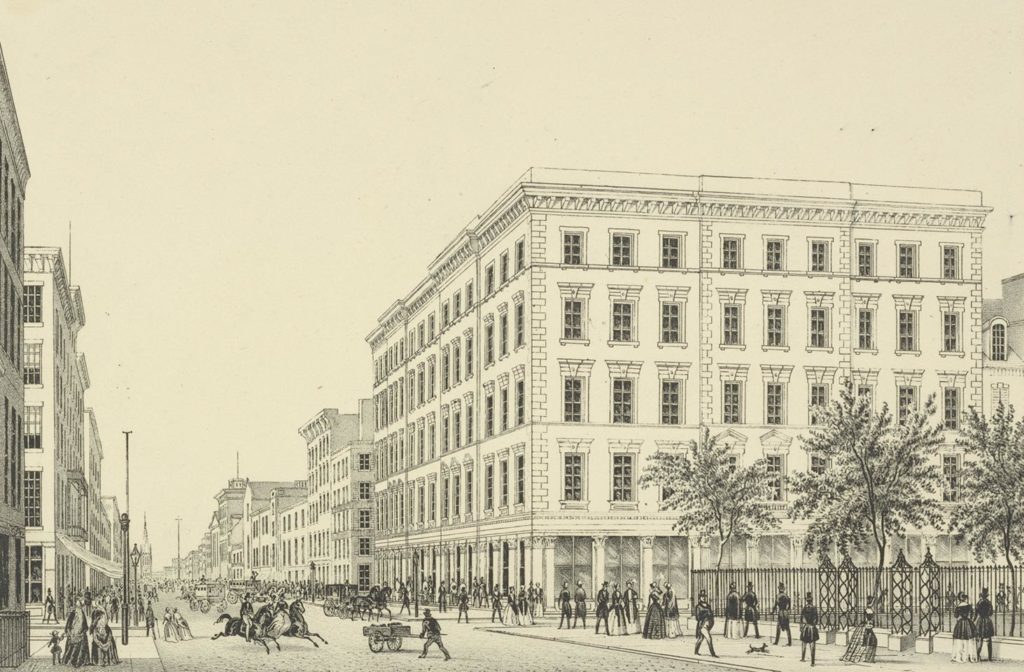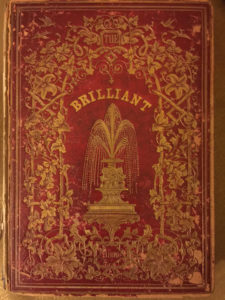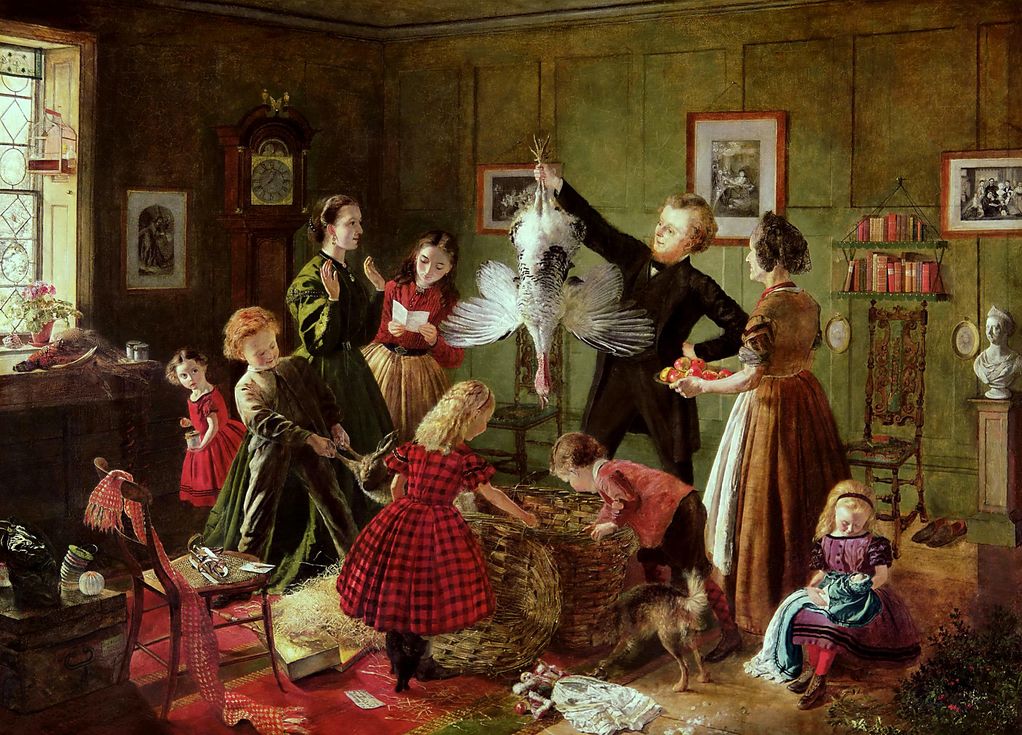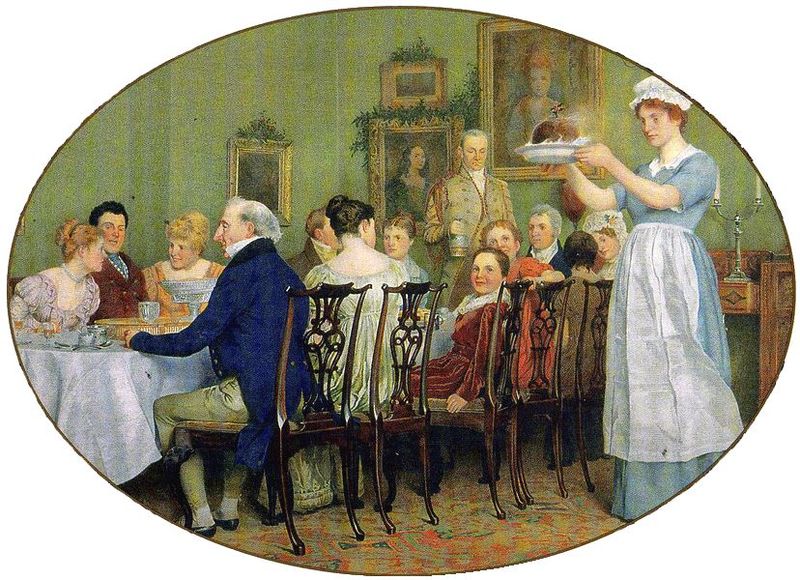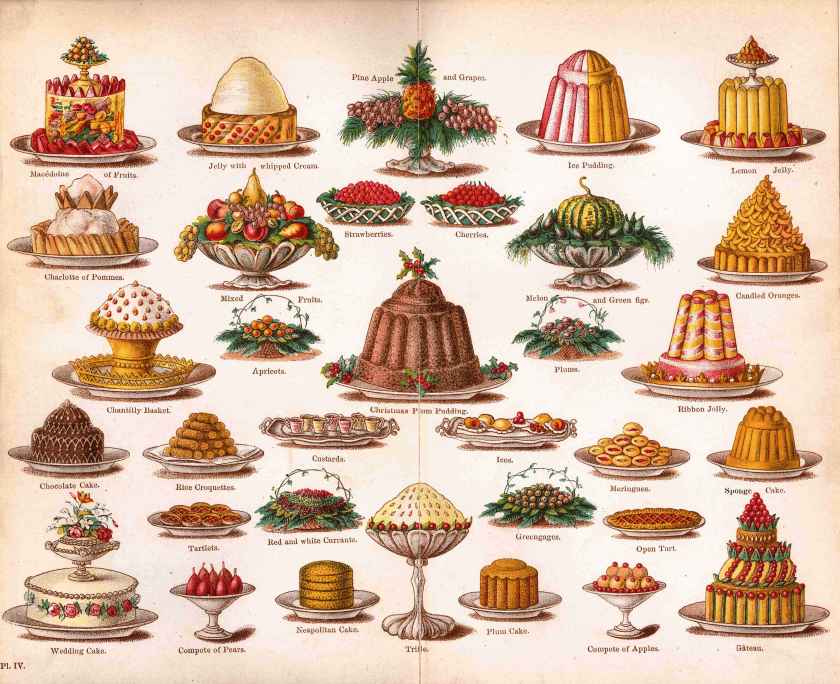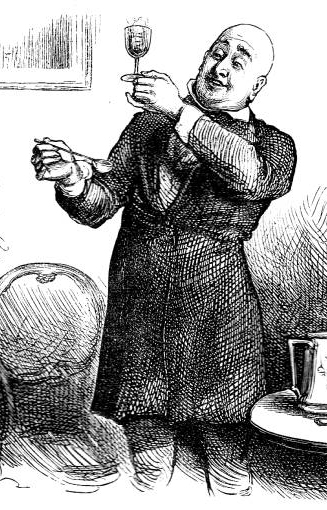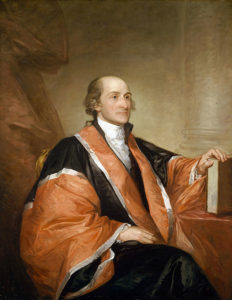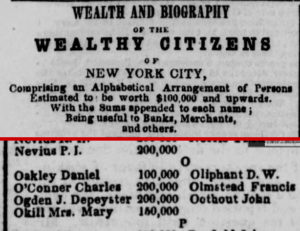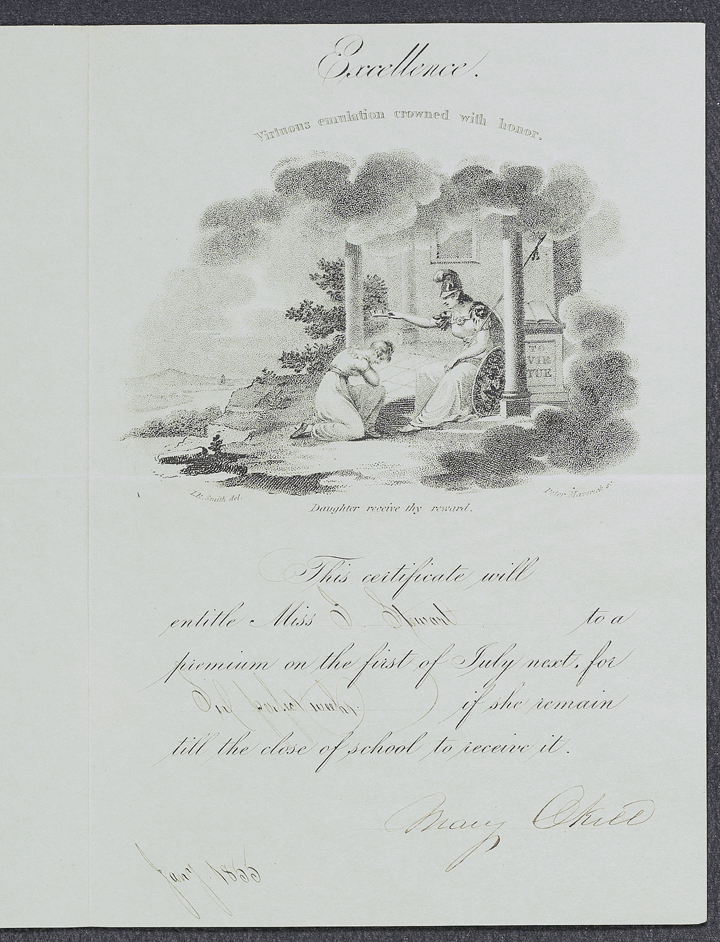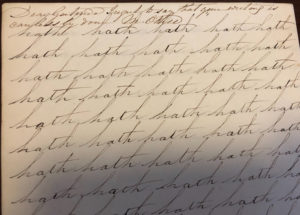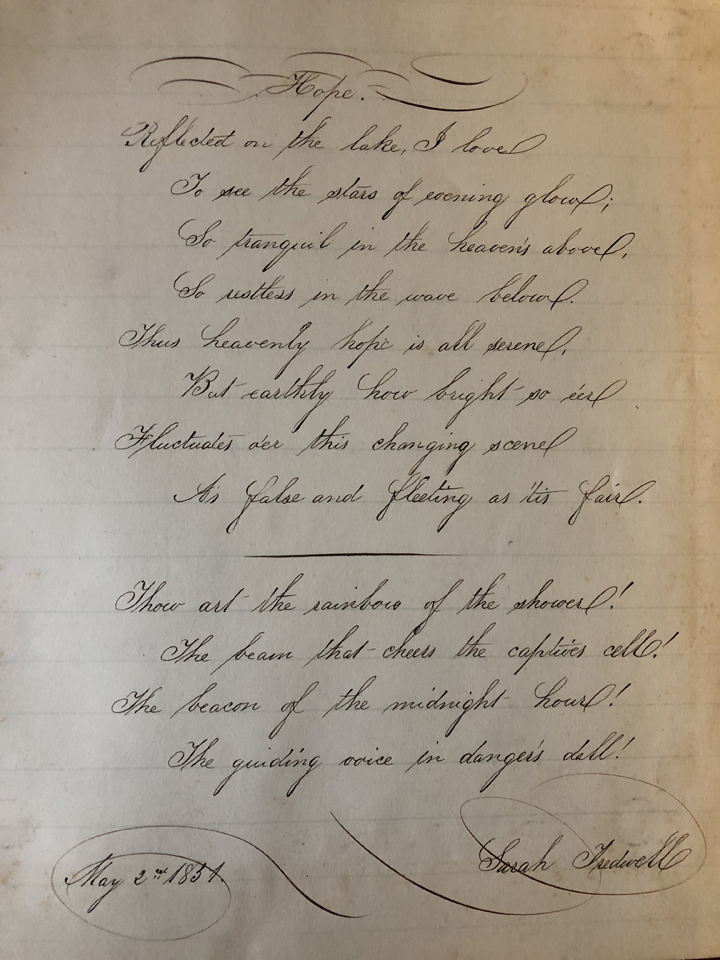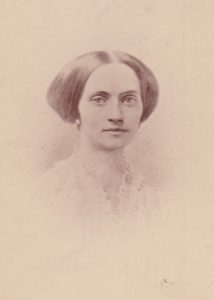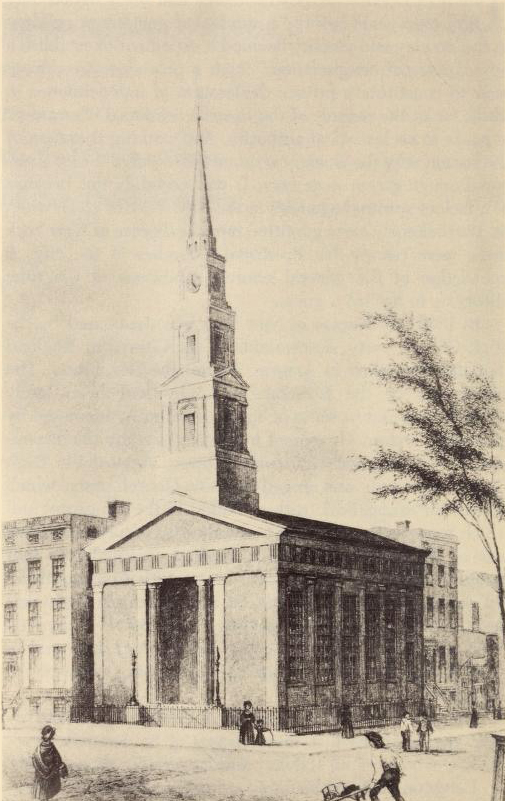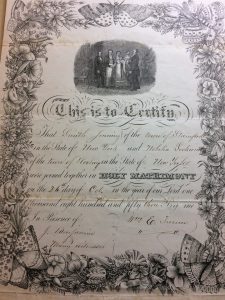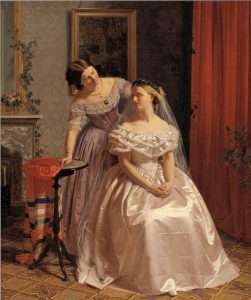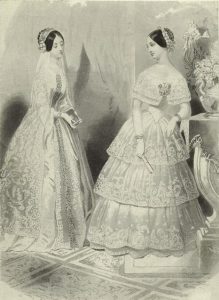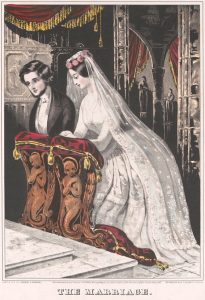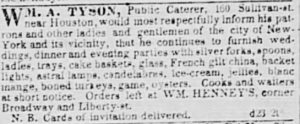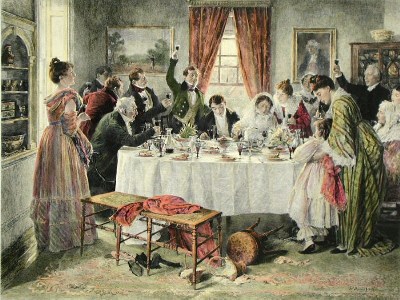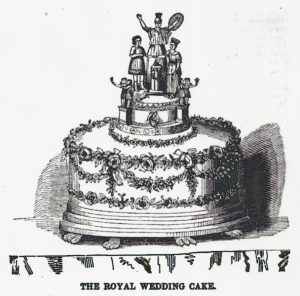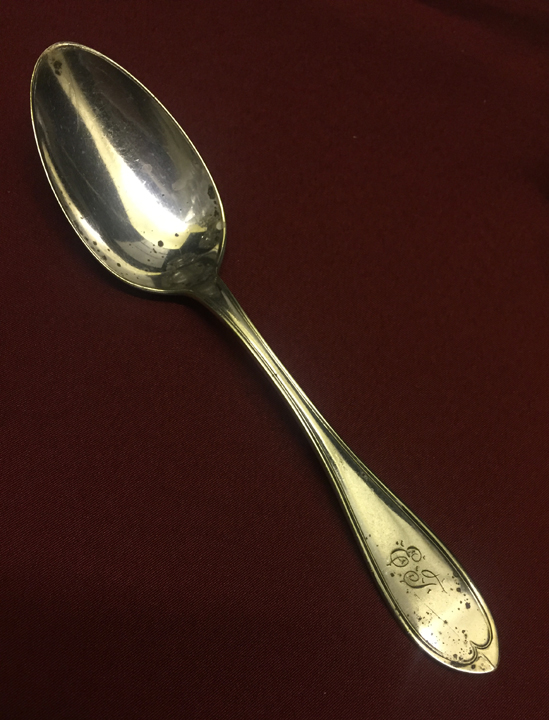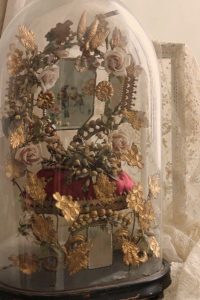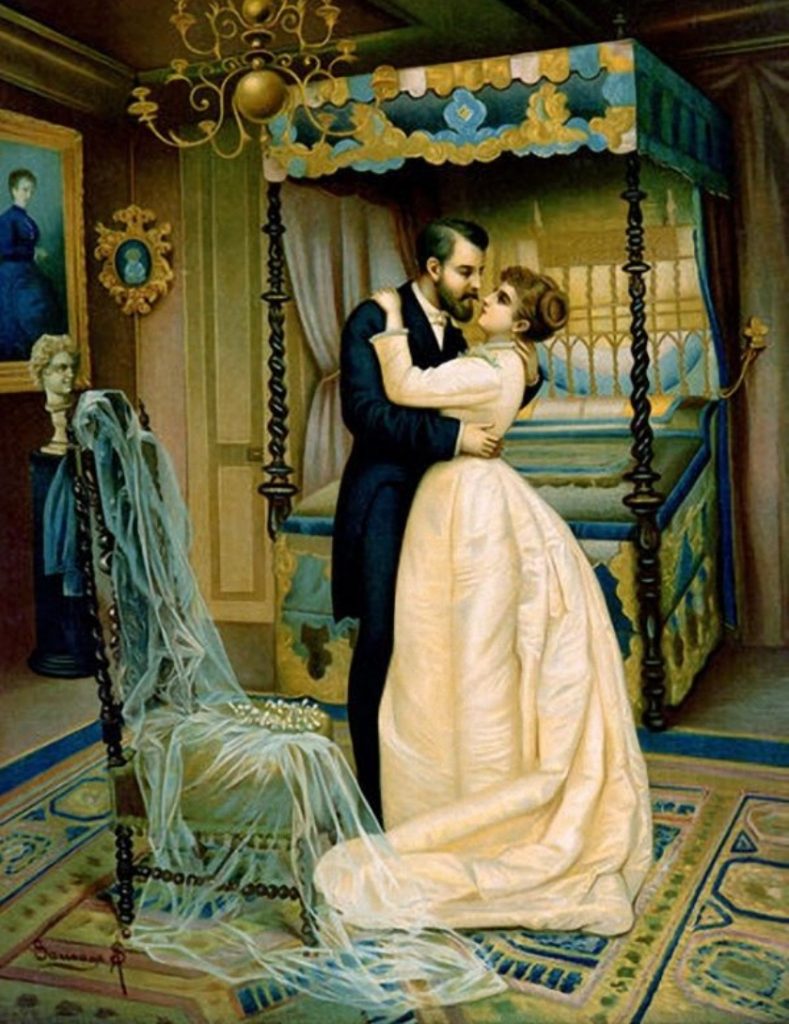Meet the Tredwells: Seabury Tredwell, Part 4 – The End of an Era
by Ann Haddad
..
On February 4, 1835, a notice appeared in the Shipping and Commercial List and New-York Price Current that the hardware firm of Tredwell, Kissam, and Company, which had flourished for over 20 years on Pearl Street, was “dissolved by mutual consent.”
That same year, Seabury Tredwell moved his family from their home on Dey Street, in lower Manhattan not far from the seaport, to a Late Federal/Greek Revival row house on Fourth Street, in the neighborhood then known as the elite “Bond Street area.” He was 55 years old, and not about to retire from the world. For 30 years until his death he maintained an active life, keeping pace with the enormous economic changes taking place in New York City and making shrewd investments in real estate, railroads, and natural gas. (For more information about Seabury Tredwell’s hardware business and investments, see Seabury Tredwell: The Merchant Years and Seabury Tredwell: Man of Opportunity). His years of hard work led to outstanding success and enormous wealth. Now we turn our attention to his final illness and death in March 1865.
..
..
..
Seabury’s Final Illness
For some years leading up to his death, Seabury’s attending physician was Dr. George E. Belcher (1818-1890), a practitioner of homeopathy, an alternative medical practice. Dr. Belcher had converted to homeopathy from conventional medical treatments in 1844. (For more information about homeopathy and the Tredwell family’s physicians, see my blog post of October 2016: The Doctor in the House is a Homeopath!). Seabury’s death certificate, signed by Dr. Belcher, states he died from acute kidney failure caused by Bright’s Disease, now known as acute or chronic nephritis (inflammation of the kidneys). The disease is characterized by a wide range of symptoms, including swelling, coma, stroke, convulsions, and blindness.
Seabury’s homeopathic treatment plan likely included the administration of herb and plant remedies, such as arsenicum, belladonna, burdock root, and juniper berry; dietary restrictions (no red meat, cheese, or alcohol); warm compresses and massage of the lower back for pain; and inhalation of lavender oil to reduce anxiety.
Although Dr. Belcher listed Bright’s Disease as the cause of death on Seabury’s death certificate, we do not know how long he suffered with the disease. According to a story related by his granddaughter Elizabeth Tredwell Stebbins (1885-1973), Seabury caught a cold after returning from his home in Rumson, New Jersey, by boat one winter’s day in 1865, which led to his death on March 7. On March 3, his nephew Timothy Tredwell, who lived in Toledo, Ohio, penned a letter to Seabury’s daughter Julia, after learning of his condition:
“I am deeply pained by the news of your dear father’s illness & his sufferings occupy much of my daily & nightly thoughts & sympathies… May god in his infinite mercy bless him. He has been a good uncle to me & how good a father to you all, you only can tell.”
The Civil War Draws to a Close
In early 1865, as Seabury’s life was coming to an end, the nation witnessed the collapse and death of the Confederacy. The Union Army, thanks to the brilliant military strategies of Generals Ulysses S. Grant and William T. Sherman, left the Confederate Army in tatters. Passage of the 13th Amendment at the end of January 1865 abolished slavery and on March 4, Abraham Lincoln was inaugurated as President for a second term in Washington, D.C. One month later, on April 9, the Civil War ended when General Robert E. Lee surrendered to General Ulysses S. Grant at Appomattox Court House, Virginia.
The Union Jubilee
On March 6, as Seabury lay on his deathbed, surrounded by his family, New York City joyously celebrated the anticipated end of the Civil War with a “Union Jubilee.” Over one million spectators lined the streets to see the grand parade, which included military troops; volunteer firemen; members of clubs, businesses, and community organizations; and even a menagerie of, among other animals, elephants and camels. John Ward, Jr., who was a National Guardsman and who lived near the Tredwells, on Thompson and Bleecker Streets, marched in the parade with his Company; the excitement of the event is palpable in his diary entry:
“Beautiful, perfect day. I put on my uniform and medal after breakfast & rigged the flag out of Mother’s window. …We formed in Washington Square….Tremendous crowd. Largest ever known. We wheeled well into Broadway, marched down to the Museum, up Park Row, etc., and Bowery to Union Square (where we saw the procession still passing down Broadway) up 4th Avenue, to 23rd Street, up Madison Ave. to 29th St…up to 33rd St. over to 8th Ave., down to Washington Square where we were dismissed. Flags & decorations were fine. …Dined. Then went to Union Square to see the fireworks. Great crowd. Splendid pieces. Change of rebel to loyal flag. “Sumter” “Bombardment of Fort Fisher,” “Monitor & Merrimack” etc. Rockets & balloons. Homes and clubs illuminated. Mother had gas all lighted.”
As the Tredwell family maintained their vigil at Seabury’s deathbed that day, they surely heard the commotion of the celebration, the pealing church bells, and the gun salute fired in Union Square to signal the start of the parade. It is hard to imagine them sharing in the immense relief and happiness of the citizens of New York City. And the no doubt unadorned Tredwell home on Fourth Street must have stood out sharply among its neighboring dwellings, for The New York Daily Herald reported on March 7:
“Looking at the houses, you beheld one, grand continuous exhibition of flags from windows, poles, awnings, and every point whereon to hang this badge of loyalty and nationality. All of the hotels and public buildings were covered with the Stars and Stripes, and many houses displayed mottoes and inscriptions of an appropriate character.”
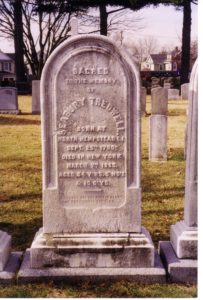 |
Death of the Patriarch
The day after the “Union Jubilee,” on March 7, Seabury died at the age of 84. His wife, Eliza, their eight children, and five grandchildren, survived him. After being waked in the front parlor for three days, on March 11 (a “beautiful, bright cold day,” according to John Ward, Jr.), Seabury’s funeral took place in the double parlor of his home, and he was interred in the New York City Marble Cemetery on East Second Street. On December 28, he was moved to his final resting place in the family plot in Christ Church Cemetery in Manhasset, Long Island.
A Family, and a Nation, Mourn
Eliza Tredwell and her family were approximately one month into their mourning period for Seabury when the American Civil War ended on April 9, 1865. Five days later, on April 14, President Lincoln was assassinated by John Wilkes Booth, and the glory of the Union victory was instantly forgotten, as the City plunged into mourning. Philip Hamilton Hill (1839-1915), a 27-year-old York City dry-goods clerk, noted the tragedy in his diary on April 15:
“Was horrified on waking this morning, to hear that President Lincoln was assassinated last night at Ford’s Theatre, Washington, by a man supposed to be J. Wilkes Booth the actor, and that an attempt had been made, upon the life of Sec’y Seward. Business was at a standstill all day, many of the Stores being closed, and most all draped in mourning, and a feeling of intense excitement existed throughout the City.”
On Tuesday, April 25, Hill recorded in his diary how he joined the crowd (over 150,000 mourners) which lined up outside City Hall, from which hung a banner reading “THE NATION MOURNS,” to view the late President’s body, and the somber mood as Lincoln’s funeral cortege passed through New York City:
“By dint of hard work, and a good deal of tight squeezing, I managed to get through. I wouldn’t go through the same crowd again for ten dollars…The remains lay at the door of the Governor’s room, surrounded by a guard of honor…He looked the same as in life, with the exception of his skin, which was of a much darker hue….At 1 P.M. all the stores were closed, and the funeral procession commenced to move up Broadway towards the train on the Hudson River road which was to convey the remains West. Had our room full of company to view the procession.”
One wonders if any of the Tredwell family joined Hill at City Hall to view the President’s remains. They most likely joined the half a million New Yorkers who viewed the funeral procession, as it made its way up Broadway past Fourth Street. Even in their mourning attire, they would not have stood out in the crowds, for on that day many women donned widow’s weeds, and the men wore black crepe armbands, as a sign of their grief over President Lincoln’s death.
A Long Mourning Period
Mourning, the personal expression of loss and grief, was considered women’s work in the 19th century. Men, as the breadwinners who had to return to the workforce, were not expected to remain at home and follow the societal restrictions required by mourning etiquette. They donned a black hatband or armband and resumed their regular life. It fell to the women of the house to conform to social norms, by donning black mourning attire, sharply curtailing their socialization, and following the other precise rules of mourning frequently found in popular household manuals. The ability to follow elaborate mourning rituals was also a subtle indication of the wealth, respectability, and social status of the family; mourning attire and its accoutrements were expensive.
For Eliza Tredwell, mourning and all its associated traditions became a daily part of her life, perhaps for the remainder of her life. Typically, a widow in “full” or “deep” mourning adhered to a strict dress code of dull black for a year and one day, then proceeded, in the ensuing nine months to one year, to “half-mourning,” in which some colors, such as gray, white, mauve, and lavender, were permitted.
For much more information about mid-19th century mourning customs, please visit our exhibition “Death, Mourning, and the Hereafter in Mid-19th Century New York,” on view from September 26 to November 4. As part of the exhibition, visitors may meet Mrs. Tredwell in the front parlor and offer their condolences every Saturday afternoon in October from 1:30-3:30 p.m.
The End of an Era
An obituary in the New York Post on March 11, 1865, noted Seabury’s death:
“Among the deaths noticed in our column today is that of one of our oldest and most respected merchants, Seabury Tredwell. He was a gentleman of the old school, dignified and accomplished in his manners and high-minded and honorable in all his transactions…“He now goes out from us, one of the last of his generation, honored, respected and beloved by all.”
Sources:
- Hill, Philip Hamilton. Diaries, 1855-1865. Manuscripts Division, New-York Historical Society.
- Knapp, Mary L. An Old Merchant’s House: Life at Home in New York City, 1835-65. New York: Girandole Books, 2012.
- New York Daily Herald. March 7, 1865, p. 1. www.newspapers.com. Accessed 9/17/19.
- New York Evening Post. March 11, 1865. www.newspapers.com. Accessed 9/9/19.
- New York, New York City Municipal Deaths, 1759-1949. www.familysearch.org.
- Merchant’s House Museum Archives. Tredwell, Timothy. Manuscript Letter, March 3, 1865. MHM 2002.4601.32.
- Shipping and Commercial List and New-York Price Current. February 4, 1835, p. 3. America’s Historical Newspapers, via ProQuest. Accessed 6/29/17.
- Spann, Edward K. Gotham at War: New York City, 1860-1865. Wilmington, DE: Scholarly Resources, Inc., 2002.
- Strausbaugh, John. City of Sedition: The History of New York City During the Civil War. New York: Twelve Hachette Book Group, 2016.
- Ward, John. Diaries, 1847-1888. Manuscripts Division, New-York Historical Society.
Meet the Tredwells: Seabury Tredwell, Part 3 – Man of Opportunity
by Ann Haddad
An Astute Businessman
George Chapman, who founded the Merchant’s House Museum in 1936, named it “The Old Merchant’s House” as a tribute to the early 19th century merchants who were known as the old merchants, among them Seabury Tredwell, who built New York City into the “commercial emporium of America” (as was said in the 19th century). However, Seabury Tredwell’s occupation certainly did not define him. Although he was a New York City hardware merchant (and a very successful one: see my post Seabury Tredwell, Part 2 – The Merchant Years), he did not confine his business interests to his Pearl Street warehouse and to life on the seaport. Rather, Seabury held a progressive view of the city and the nation’s capacity for growth; beginning in 1816, he began to invest in real estate, an interest that would continue until his death. As his career flourished, he purchased properties in Manhattan and Brooklyn, as well as further afield in North Carolina and Michigan. Seabury also kept abreast of the country’s industrial development, investing in the burgeoning railroad and coal gas companies.
New York on a Grid
Relatively early in his career (and just one year after taking on his nephew as a business partner), Seabury Tredwell started investing in the New York City real estate market. No doubt he was influenced and guided by two of his older brothers, Adam and John, who had moved to the city several years before Seabury, and who, by the first decade of the 19th century, owned extensive real estate in New York City and Brooklyn City. Seabury’s real estate investing involved him in one of the most important chapters of New York City history: the Commissioners’ Plan of 1811, which called for the reorganization of Manhattan’s haphazard landscape into streets and avenues in a rectilinear grid pattern. Seabury’s first real estate purchase indicates that he was very likely aware of the Commissioners’ Plan. Probably eager to profit from the city’s anticipated growth patterns, in May 1816, prior to his marriage and while living in a boarding house, Seabury purchased a substantial three-lot parcel on the northwest corner of what is now 12th Street and Broadway, for $1,860.
The City Pays
In 1826, ten years after Seabury purchased the property, New York City was preparing to open 12th Street; the first step of the process was to compensate all the property owners whose land would be claimed and used. According to the Minutes of the Common Council, on January 28, 1828, the city paid Seabury $3,341 for one lot of his property that was consumed by the grid. Nine other property owners also received payment.
Harlem Land
In December 1828, Seabury sold one of the remaining lots on 12th Street and Broadway to Michael Floy for $800, in exchange for 4 lots on 128th Street and 4th Avenue, in Central Harlem. Floy, a noted horticulturist, likely wanted the land to add to his already existing greenhouse south of what is now Union Square. The land in Harlem was a developing area, ideal for real estate speculation. Further research is required to determine if and how Seabury built on and profited from the Harlem investment.
A Wise Investment
Seabury sold the last lot on the property on 12th Street in February 1833 for $1,500. Seabury gained usable land in Harlem and realized a total profit of $5,641 from his original investment of $1,860.
The New York Merchant’s Exchange
In addition to his personal real estate dealings, Seabury bid at auction for some of his properties at the New York Merchant’s Exchange, located at 55 Wall Street. Built in 1836-42, it replaced the original Exchange, which was destroyed in the Great Fire of 1835. The Exchange housed a post office, banks, and the Chamber of Commerce, as well as rooms for auction sales of real estate and stocks, which was at a fever pitch as the city growth pushed northward, and housing was in great demand to accommodate the exploding population.
According to the records of New York Merchant’s Exchange of July 17, 1856, Seabury purchased at auction a lot on the southwest corner of 8th Avenue and 53rd Street, for $4,050.
Seabury Bets on Brooklyn
When Seabury ventured into the frenzied Brooklyn real estate market in the mid-19th century, Brooklyn was the third largest city in America (it didn’t merge with New York City until 1898), and soon to become one of America’s major industrial centers, due to its location on the East River, which allowed for convenient transportation of materials and manufactured goods. Beginning in 1814, regular steam ferry service between Fulton Street in Brooklyn and Beekman Slip (now Fulton Street) in Manhattan, made it easy for affluent families who had moved to Brooklyn, as well as workers with jobs in the city, to commute back and forth.
.
.
Before It Was DUMBO
Seabury no doubt was aware of Brooklyn’s changing character and landscape when he acquired his first piece of Brooklyn property in March 1852, when he purchased, from the estate of his brother John, four plots on Fulton and Pearl Streets in the Second Ward, for $12,875. This area, located along the East River waterfront, is now known as the DUMBO Historic District (an area now bounded roughly by the Brooklyn Bridge, the East River, York, and Navy Streets). Although this area was one of the first residential-use sections of Brooklyn, by 1852 it was well on its way to becoming a major manufacturing center, with factories, foundries, and warehouses vying for space with two and three-story residential houses. Two ferry lines, one right at the foot of Front Street, made regular trips to and from New York City.
In 1853, Seabury sold this property for $15,500. In one and a half years, he made a profit of $3,500.
… and Fort Greene
In 1858 and 1859, Seabury added to his Brooklyn holdings with the purchase of nine lots, some with buildings, on Fulton Avenue, Raymond Street, and Navy Street, in the 11th Ward (now the Downtown Brooklyn/Fort Greene area), for $12,000. The property was advertised in the Evening Post in 1850 as being “located in the most desirable part of Brooklyn, being in the immediate vicinity of Washington Park, which is now being regulated and graded.” He immediately sold two of the lots for $4,600. In 1863, he sold four of the lots for $15,500, making a profit on land he had owned for only four years.
With the growth of middle-class residential districts, including Fort Greene, house construction in Brooklyn skyrocketed. Row houses appeared almost overnight on the quiet streets, and became ideal homes for professionals who commuted to their New York City businesses. According to Seabury’s personal ledger, he spent a great deal of money building on his Brooklyn properties. Between July and October 1863, for example, he paid John P. Seeley (a “master builder,” according to the 1860 Federal Census) $9,370, most likely for house construction. Seabury also paid $102.31 to have a sidewalk laid on his property on Raymond Street.
The Good Son-in-Law
Effingham Nichols, an attorney and the husband of Seabury’s eldest daughter, Elizabeth, must have been influential in Seabury’s decision to invest in Brooklyn real estate. He lived in Fort Greene with his wife and daughter, Lillie, from 1859 to 1864, and had begun to buy property there in 1851; by 1859 he owned at least seven properties in the neighborhood. (See my post of April 2017, “Days of Sorrow, Days of Rejoicing”). In addition, one of his brothers, William B. Nichols, owned houses near Seabury’s property on Fulton Avenue and Raymond Street. Effingham may have collected rents for Seabury, and may even have acted as an agent for him, buying and selling properties at his discretion. Records in Seabury’s personal ledger indicate that Seabury provided Effingham with funds to repair the Fulton/Raymond Street property. In 1863, for example, he gave Effingham $63.84 for sewer work.
In 1863, Seabury made what may have been his last purchase of Brooklyn real estate, bidding at auction for another parcel of land in Fort Greene, paying $4,400. The Land Conveyance Records Index for Kings County indicate that Seabury purchased at least three other properties in Brooklyn; the details of these purchases could not be determined because the conveyance records are missing.
Seabury the Landlord
Seabury also collected rents on some of his properties. In 1862, he rented three buildings on Fulton Avenue to Mary Louise Tredwell (a distant cousin) for $1,200/year. Seabury’s personal ledger indicates that in 1852 he was collecting rent of $1,000/year on a factory on Front Street, and $212.50/year for a Pearl Street property.
Seabury also engaged in seller financing, wherein he financed purchases of his property to individuals, rather than have them obtain a bank mortgage. In his personal ledger, he listed several individuals to whom he sold property, such as John and William Healy, John Rupp, and John David, and the amounts of the mortgages he granted.
Ventures Further Afield
Records show that Seabury also invested in commercial property with his partners for their business. Seabury and his nephews likely decided to invest in real estate in North Carolina due to their business dealings there and their familiarity with the state. Seabury’s eldest brother, Samuel Tredwell (1763-1827), had been a prestigious figure in North Carolina after the Revolutionary War. In 1785, Samuel moved to Edenton, North Carolina, whose vital port was the second largest in the state. In 1793, he was appointed Collector of the Port of Edenton by President Washington, a position he held until his death. He also served as State Commissioner of North Carolina in 1818.
In 1835, Tredwell, Kissam & Company purchased 13,000 acres of North Carolina swampland from Charles Johnson for the purpose of harvesting lumber to make shingles. A North Carolina Supreme Court case in June 1840 involved a lawsuit brought against a trespasser who was using the land illegally. At this time it is unknown when and to whom Seabury sold the land.
In the Transactions of the Supreme Court of the Territory of Michigan, 1825-1836, there is a record of a court case involving Tredwell, Kissam & Company in a lawsuit against three men, Isaac Otis, George Walker, and John Hale. The nature of the suit is unknown.
The Children Benefit
A portion of the original property on Fulton Avenue and Raymond Street in Brooklyn was still under Seabury’s name upon his death in 1865, and became part of his estate. His children benefited from Seabury’s real estate savvy. In 1902, Samuel Lennox, his younger son, who had purchased the Fulton Avenue property from his father’s estate some years earlier, sold it for $40,200. The property was described in a February 1902 advertisement in the Brooklyn Eagle as “being a very valuable plot with three two story and cellar brick buildings thereon, with 5 stores therein.”
Seabury’s Investment Portfolio
It is unclear when Seabury set about building an investment portfolio, but by his death in 1865 he had amassed enough stock to significantly cushion his family’s inheritance. Getting in on the ground floor of both the steam engine and lighting revolutions taking place in New York City and elsewhere, he invested heavily in various railroad stock (including the New York and Erie Line, the Hudson Line, Chicago and Rock Island lines, and Hartford and New Haven lines) and in gas lighting. Seabury may have consulted his friends and former colleagues in the business world for advice; he also may have looked to his sons-in-law Effingham Nichols and Charles Richards for guidance in choosing his investments.
The New York and Erie Railroad Line
Seabury Tredwell was an early investor – and possibly one of the original investors – in the New York and Erie Line, a railroad that linked Erie Canal towns directly to New York City, allowing for faster transportation of lumber and agricultural goods. Leading merchants of the day, as well as land investors and bankers, were granted the charter in 1832, creating a railroad line that ran west from the Hudson River in Piermont, New York, to Dunkirk on Lake Erie. This proved to be a risky investment through the years, however; the railroad went bankrupt several times, and became known as “the scarlet woman of Wall Street,” due to the financial shenanigans of men like Jay Gould and Cornelius Vanderbilt, who vied for control of the railroad and manipulated the company holdings to their own advantage.
Take the Hudson River Line
The Hudson River Line was another of Seabury’s investments. In 1846, 11 years after Seabury sold his business, the Hudson River Line was chartered. This commuter line initially ran from Chambers and Hudson Streets in lower Manhattan up the West Side via horse cars (steam trains were not permitted below 30th Street) to a depot at 32nd Street, where the horses were exchanged for steam engines, then along the east side of the Hudson River, to Peekskill. By 1851 it had been extended to Poughkeepsie, which remains its terminus. Through a connection with the Troy and Greenbush Railroad, it provided a link between Albany and lower Manhattan, a trip of less than four hours. A similar journey by steamboat took over seven hours! One imagines that the growth of the railroad industry (with its speed, efficiency, and convenience) and its revolutionary impact on 19th century life was not lost on Seabury, who, like everyone else, had previously relied on the comparatively snail-paced omnibuses, ferries, and coaches.
New York Gas Light Company
Seabury’s personal ledger indicates that he owned 133 shares of stock in the New York Gas Light Company, the first coal gas company in New York, founded in 1823. One wonders if he was one of the original investors in the company, which first focused on street lighting, servicing Manhattan south of Canal Street. Ultimately six gas companies supplied gas for illumination and later, for heating and cooking. The competition for customers was so fierce in the growing city, that workers from different companies would do battle in the streets over the installation of gas mains; known as “gas house gangs.” In 1884, the companies merged to form Consolidated Gas Company (now known as Con-Edison).
More than a Merchant
Now that Seabury’s varied business interests have come to light, and we see the extent to which he ventured into unchartered investments, it is clear the title “merchant” doesn’t embrace all that Seabury was in the business world of the 19th century. Seabury Tredwell, along with many of his peers in the merchant class, were men of opportunity who shaped the economic future of New York City. Perhaps we should consider renaming the Merchant’s House — the “Investor’s House”? The “Risk-Taker’s House”? What do you think?
Sources:
- Blume, William Wirt, ed. Transactions of the Supreme Court of the Territory of Michigan 1825-1836, Volume II. Ann Arbor: The University of Michigan Press, 1940. www.babel.hathitrust.org. Accessed 5/29/19.
- Bristed, Charles A. The Upper Ten Thousand: Sketches of American Society. New York: Stringer and Townsend, 1852. www.babel.hathitrust.org. Accessed 6/5/19.
- Brooklyn Citizen. April 2, 1902, p. 9. www.newspapers.com. Accessed 5/3/19.
- Brooklyn Daily Eagle. February 22, 1902, p. 15. www.newspapers.com. Accessed 5/3/19.
- Burrows, Edwin G. and Mike Wallace. Gotham: A History of New York City to 1898. New York: Oxford University Press, 1999.
- Conveyances, 1724-. New York Land Records, 1630-1975. Images. familysearch.org.
- “Erie Railroad Company.” Encyclopedia Britannica. www.britannica.com. Accessed 6/3/19.
- Evening Post. October 5, 1850, pg. 3. www.newspapers.com. Accessed 5/22/19.
- “History of Con Edison.” American Oil & Gas Historical Society. www.aoghs.org. Accessed 6/3/19.
- Koeppel, Gerard. City on a Grid: How New York Became New York. Boston: Da Capo Press, 2015.
- Lockwood, Charles. Manhattan Moves Uptown: An Illustrated History. Boston: Houghton Mifflin Company, 1976.
- New York City Landmarks Preservation Commission. DUMBO Historic District Designation Report. December 18, 2007. www.neighborhoodpreservation.org. Accessed 5/21/19.
- New York City Landmarks Preservation Commission. Fort Greene Historic District Designation Report. September 26, 1978. www.home2.nyc.gov. Accessed 5/22/19.
- New York Daily Herald, March 11, 1865, p. 2. www.newspapers.com. Accessed 6/9/19.
- North Carolina. Supreme Court. North Carolina Reports: Cases Argued and Determined in the Supreme Court of North Carolina, [v 023, June Term 1840-June Term 1841]. State Library of North Carolina. www.digital.ncdcr.gov. Accessed 5/29/19.
- Notes from Seabury Tredwell’s Personal Ledger Book. Merchant’s House Museum Archives.
Meet the Tredwells: Seabury Tredwell, Part 2 – The Merchant Years
by Ann Haddad
A Knack for Success
Throughout his life, Seabury Tredwell had a remarkable knack for being in the right place at the right time. Or perhaps he had wise advisors who guided him carefully. However he made his decisions, they seemed to always be the right ones. He arrived in New York City to make his fortune as its wealth and reputation as a great commercial center was about to explode; thirty-five years later, he ended his mercantile career and moved uptown, narrowly escaping the Great Fire of 1835 and the economic Panic of 1837. He knew the chic neighborhood to move to and the finest country property to buy. The story of his trajectory from country farm boy to elite New York merchant is a classic success story.
Enter Seabury
Seabury arrived in New York City sometime around 1800, when the city’s population was approximately 60,500. Probably working initially as an entry-level clerk, he became one of approximately 1,100 merchants who aspired to achieve success in the growing city. He either lived with his boss (clerks often slept on the store premises), or took lodging in a boarding house. He most likely packed all of his possessions into one trunk; its contents may have been similar to that brought by a young clerk in “The Perils of Pearl Street,” : “Two pair of stockings, one vest, one pair of pantaloons, one dress-coat, two nightcaps, three cravats, one pair of boots, and one pair of slippers.” No doubt Seabury was given a sum of money by his father or another relative to tide him over financially until he was self-sufficient. For more information about Seabury’s arrival in New York City, see Meet the Tredwells: Seabury Tredwell, Part I – The Early Years.
“The Commercial Emporium of America”
With the end of the War of 1812, the lifting of British blockades, and the subsequent restoration of trade, the Port of New York began the steady economic growth that eventually led it to become the world’s busiest seaport. According to The Rise of New York Port (1939), the years from 1815-1865 saw the seaport’s greatest development into “the commercial emporium of America.” Several factors contributed to this intense and rapid growth.
The Black Ball Line
The launching of the Black Ball Line in 1818, whose four ships made regularly scheduled voyages to and from Liverpool, allowed New York to ramp up its importing of foreign goods, beating out the competitive port cities of Boston and Philadelphia. On average the packets travelled from New York to Liverpool in 23 days; the reverse trip west could take anywhere from 45 to 90 days, depending on weather and wind conditions. Due to the success of the Black Ball, other lines soon followed suit and, according to Gotham (1999) by Burrows and Wallace, by 1838 52 packet ships were shuttling from New York to Liverpool. The development of inland steamboat service by 1817 also contributed to traffic between the city and Long Island Sound and the North (now Hudson) River. Imagine the East and North River wharves lined daily with nearly 1,000 steamboats and packets!
An Ideal Harbor
The joining of the East and North Rivers created a large harbor that was ideal for foreign and domestic commercial trade. Owing to its location and tides, the harbor was well sheltered and free of the treacherous ice that could damage ships, and therefore its ports were accessible in all seasons. The depth of the water allowed large ships to come close to the wharves to load and unload cargo.
The Erie Canal – “Clinton’s Ditch”
The opening of the 363-mile Erie Canal in 1825, which connected the Atlantic Ocean to the Great Lakes via the Hudson River, galvanized commerce and enabled New York to become the gateway to the rich agricultural resources of the Midwest. Those who opposed the plan to build the canal referred to it as “Clinton’s Ditch,” to ridicule Governor DeWitt Clinton, who was one of the major supporters of the project. Its route from New York City to Buffalo allowed midwestern markets to receive highly desirable imported manufactured goods; in return, domestic produce grown in the nation’s interior could be shipped (at a dramatically lower cost) to the New York markets. This exchange of more and more goods took significantly less time, increasing the velocity of trade in New York dramatically.
As a result of the surge and speed of trade, a new way of doing business developed in New York. Merchants sought ways to store the wealth of goods coming in and going out, while also selling them directly to consumers. The brick warehouses constructed for this purpose, which forever altered the landscape of Lower Manhattan, typically held a store/living space on the ground floor with storage areas above. The ubiquitous cart man transported the goods from the teeming wharves to the shops, where they would be hauled up by ropes to the second and third floor.
The Merchant Class
As New York’s commercial activity accelerated with each passing year, the wealth of the city and its merchants grew to unprecedented heights. According to the Commercial Directory (1823), in 1820 the value of goods imported into New York City was $26 million, and the value of exported foreign merchandise and domestic goods was nearly $12 million. The men who controlled the mercantile business became powerful and wealthy in the process and were known as the elite “Merchant Class.” Individually, those who could claim membership in this group were later referred to as “Merchant Princes.” Seabury Tredwell was indeed deserving of this distinction.
The Hardware Trade: Seabury’s Niche
We do not know if Seabury was set on becoming a hardware merchant from the start, or if he clerked for a merchant in the hardware trade, during which time he learned the details of the business. According to John C. Tucker, a New York City hardware merchant whose career overlapped with Seabury’s for several years, in the first half of the 19th century, “American Hardware was almost unknown.” Seabury purchased his goods from importers and wholesaled them from his warehouse. During his years in the hardware trade, more than 85 percent of the goods Seabury sold were imported. According to Tucker, the only American-made hardware was cut nails, and even those Seabury’s company also imported (see advertisement at right). Hence Seabury and other businessmen relied heavily on the merchant ships to deliver their goods in a timely fashion. Severe weather or a shipwreck could be a major setback to business.
It should be noted, however, that some percentage of the goods Seabury sold were American-made. At the bottom of an Evening Post advertisement (September 6, 1816), he added, “ALSO, Many articles of American Manufacture in the Hardware line.”
Trade Embargo
From his shop and warehouse on Pearl Street (see previous post for shop locations), Seabury set to work building his business and reputation as a hardware merchant. His career may have been derailed for several years during the trade embargo imposed by President Thomas Jefferson from December 1807 to March 1809, which prohibited American ships from trading in foreign ports. As a result of this effort to protect American shipping rights and to maintain neutrality amidst the raging Anglo-French conflict, activity at the seaport came to a standstill. The export trade declined by nearly 80 percent; imports by 60 percent. Many mercantile firms went out of business and unemployment among seaport workers skyrocketed. The embargo may explain the absence of Seabury’s name from the city Directory in 1808; like many other merchants, he may have had to close his business. Once the Embargo Act was repealed by Congress, in March 1809, Seabury’s name once again appeared in the Directory.
All in the Family
According to hardware merchant John C. Tucker, a “large business” was one that sold between $150,000-$200,000 worth of goods per year. Although the size of Seabury’s business is unknown, by 1815 his wealth had grown to such an extent that he took on his nephew, Joseph Kissam, as a partner, naming the firm Tredwell & Kissam. Joseph’s brother, Samuel, would join them three years later; the firm then became known as Tredwell, Kissam, and Company, and remained so until Seabury’s retirement in 1835. The partners typically shared equally in the responsibilities and profits of the company.
In The Old Merchants of New York (1863-66), author Joseph A. Scoville notes that bringing family members into the business was almost de rigueur. A merchant on the road to success “does not rest until one by one he has procured situations for all of his brothers” (or in Seabury’s case, nephews). Joseph (1790-1863) and Samuel (1796-1856), were the sons of Seabury’s sister, Elizabeth (1767-1803), and her husband Dr. Daniel Whitehead Kissam (1763-1829), of Hempstead, Long Island.
Newspapers: The Way to Advertise
Although they did some some retail business in the stores attached to their warehouses, (Seabury’s advertisements occasionally indicated that items may be purchased “from the shelves”), companies like Tredwell, Kissam and Company worked largely in wholesale. To keep his customers apprised of the goods arriving from England, Seabury advertised in the newspapers, paying a subscription of $40 per year to advertise at will, but typically three or four times a year, based on the packet schedule. (According to The Old Merchants of New York, “no respectable house would overdue the thing. [over-advertise]”). Country merchants, who would come into town several times a year to make their purchases (typically in the spring and fall), consulted the advertisements to determine which houses to visit. With these personal interactions, merchants would establish relationships with their clients, and come to understand their financial situations; this usually ensured customer loyalty, especially if the merchant extended credit to the customer when necessary.
Seabury Tredwell’s first newspaper advertisement appeared on September 7, 1812. He advertised 30,000 musket flints (a form of quartz used to ignite firearms), and pistols. Tredwell & Kissam’s first advertisement appeared on August 16, 1816. As this was one year after Seabury took on a partner, it may indicate a deliberate decision on Seabury and Joseph’s part to expand the scope of their business. The ad boasts of the company’s “extensive assortment” of goods, and stress that they offer “liberal terms” for both retail and wholesale “by the package, or in quantities to suit the country trade.” In addition to hardware such as cutlery, waffle irons, tools, and cookware, the company also sold looking glasses, buttons, and ladies’ pocket books.
Newspapers like the Evening Post also regularly printed notices of ships’ arrivals in New York Port. On November 2, 1815, the ship Zodiac arrived after a 70-day voyage from Liverpool, England, bearing cargo for Tredwell & Kissam. These notices would then typically be followed by advertisements from the company announcing the goods they now had in stock.
A Pearl of A Street
Prior to the Civil War, the mile-long stretch of the East River from the Battery to Corlear’s Hook (now at Cherry Street and the East River Drive), was home to the busiest wharves. Because of their proximity to the waterfront, where ships loaded and unloaded their cargo, streets such as Pearl, (especially the blocks north of Wall Street and south of Fulton), Front, South, Wall, Pine, and lower Broadway comprised the epicenter of commercial activity. Hundreds of merchants had their shops and warehouses on these streets. According to the Commercial Directory (1823), on Pearl Street alone, 90 mercantile firms vied for customers, selling everything from dry goods and cotton to china and fine jewelry. Auction houses were plentiful as well. Tredwell, Kissam and Company was one of eight hardware merchants on Pearl Street that year.
Seabury’s Daily Routine
Whether he ventured to his warehouse on Pearl Street from his boardinghouse a short distance away, or later from his home on Dey Street, when he had to walk a few blocks further, Seabury’s daily routine probably resembled the one described in The Old Merchants of New York:
“To rise early, to get breakfast, to go down to the counting house of the firm, to open and read letters – to go out and do some business…until twelve, then to take a lunch and a glass of wine at Delmonico’s; or a few raw oysters at Downing’s; to sign checks and to attend to the finances until half past one; to go on change [the Merchant’s Exchange]; to return to the counting house, and remain until time to go to dinner, and in the old time, when such things as packet nights existed [when the packet ships would arrive at port], to stay down until ten or eleven at night, and then go home and go to bed.”
Rising Stars
Tredwell, Kissam, and Company achieved great success in the hardware business. From their early days, they cast a wide net to acquire customers. Records indicate that, in addition to New York, they did business in Connecticut, Philadelphia, Massachusetts, and Michigan.
On September 19, 1812, a storekeeper in New Milford, Connecticut, named Elijah Boardman paid $28.31 to Seabury Tredwell for goods, including “three dozen barber knives, 1 dozen teaspoons, and 1 dozen dustpans.”
Another undated bill of $3.56 to Elihu Harrison of Morris, Connecticut, from Tredwell, Kissam, and Company, was for “steel knitting pins and thimbles.”
On November 22, 1827, the shop of William & Fairchild in Stockbridge, Massachusetts, ordered “brushes, spoons, thimbles, violin strings, steel traps, curry combs, sad irons, trace chains, etc.” from the firm.
As his business grew, Seabury and his partners continued the tradition of hiring clerks to do the daily work of the company while learning the trade. William Floyd-Jones, from Oyster Bay, Long Island, started out in 1831 as a clerk for “the highly respected wholesale hardware house of Tredwell, Kissam and Co.” and became a member of the firm in 1837, retiring in 1855.
Trade Tokens
Trade tokens were often used by businesses either to provide sufficient currency during times of coin shortages (especially when stores were in remote locations away from banks), to extend credit, or as a form of advertising, to let potential customers know their location and the services and goods available. In 1823, and again in 1825-26, Tredwell, Kissam and Company issued trade tokens, struck by Kettle & Sons of England, to commemorate the opening of the Erie Canal, referred to on the coin as the “Grand Canal.” According to Robert D. Leonard, a collector of trade tokens, most of the pieces made for commemoration saw limited circulation as money.
.
.
.
The South Beckons
Seabury did not limit his business to the New England or Mid-Atlantic states. Like many other merchants who realized the huge market for goods in the South, he did business with and extended credit to storekeepers in Alabama and the Carolinas. As early as 1816, Tredwell & Kissam was advertising in Southern newspapers. In an advertisement placed in The American (Fayetteville, North Carolina) on October 17, 1816, they advertised hardware and cutlery “to suit the country trade.”
Typically, a traveling salesman, or “drummer,” would venture to faraway cities to provide catalogs, collect orders, and in many cases, settle overdue accounts. In a letter to Tredwell, Kissam & Company dated January 11, 1831, from a Montgomery, Alabama, storeowner named William Shute, he references a “Mr. Smith,” who was apparently a drummer for Tredwell, Kissam, and Company: “…your Mr. Smith left here a few days ago. He said you have a fine stock of guns and Memo to order. Below we hand you an order for such goods as we are in immediate want of which you will please ship by 1st vessel for Mobile.” Shute goes on to list the desired goods, including guns, corn mills, and padlocks.
Tredwell, Kissam and Company must have had strong commercial ties to North Carolina, for in 1831 they donated $100 towards the relief of citizens of the city of Fayetteville, after a disastrous fire that took place there on May 29.
.
A Famous Client
Undoubtedly the most famous client of Tredwell, Kissam, and Company was John Jacob Astor (1763-1848), the German-born fur trader and real estate investor who at his death was the wealthiest man in America, with a fortune worth approximately $20 million. Records of Astor’s American Fur Company indicate that he purchased guns from Tredwell, Kissam, and Company in 1832 and 1833, for use in trade with Native Americans in exchange for furs. In a “Memorandum of Guns to be Furnished,” dated October 31, 1832, Astor gives very specific instructions as to the quality of the guns, indicating that a previous shipment had been of less than desirable quality:
“The stocks of many of the guns you gave us last spring were made of two pieces of wood united at the gap … This must not on any account be the case with the present order…Our Indians consider them not new, but old arms patched up, and in numbers instances have returned them to our traders, [illegible] them with having practiced an imposition, by selling them a mended article for one that was new and perfect in every respect. The pernicious effect of such an impression is of too much importance to our interest to be overlooked.”
The Memorandum stipulates that the specific order of 410 guns must be “ready for delivery” by April 10, 1833, which gave Tredwell, Kissam and Company six months to import the guns from England, then pack and deliver them. This order indicates the long turnaround time from ordering to acquisition and delivery of goods.
Guns and Cotton Trade
The above-mentioned orders from Shute and Astor point to a shift from hardware to guns on the part of Tredwell, Kissam, and Company. Although America was beginning to manufacture guns in small amounts (Derringer in 1810, Remington in 1816, and Colt in 1836), by 1815 the British were mass-producing millions of guns per year; Seabury’s company relied on overseas production to readily fill their large orders. The English fowling gun, used to hunt birds and fowl, was made in Birmingham, England, and was primarily sold to Native Americans.
Although Seabury’s company did not engage in the rapidly growing cotton industry on a large scale (by the mid-1840s, cotton accounted for almost 45 percent of the gross national product), they did sell items that supported the trade, and, in at least one instance, sold cotton. In an advertisement in the Evening Post (December 23, 1819), the company offered “7 bales Cotton (new crop), landing from sloop Cashier.” This appears to be a one-time venture, however. What Seabury did sell in considerable quantities were cotton cards, tools used to process raw cotton in small amounts for lower-scale production. The cards disentangled and cleaned the raw cotton fibers after the cotton was picked. He also occasionally sold hemp cotton bagging, which was used to pack bales of cotton.
A Rich Man
In 1822, Lanier’s A Century of Banking in New York, 1822-1922 (1922), included Seabury in a list of “The Rich Men of 1822,” wherein the value of his personal property, from 1815 to that date, was listed as $17,500. This was quite a significant amount of money for that time, especially considering that it references only Seabury’s personal property. Seabury was living in the boardinghouse during those years, so this amount represents the value of his business and whatever chattel he owned. The real property he owned at that time (Seabury’s real estate ventures will be discussed in the next post) was not included in this estimate.
A Prince among Princes
On January 11, 1834, one year before his retirement, Seabury was a pallbearer at the funeral Thomas Seaman Townsend (1771-1834), held at St. George’s Episcopal Church (then located on Chapel Street, now Beekman), where Townsend was a vestryman. Townsend was a wealthy merchant who was a neighbor of Seabury’s on Dey Street. The names of pallbearers who joined Seabury that day reads like a list of merchant elite of New York, including such highly regarded men as Benjamin Strong, Anthony Underhill, and Stephen Van Wyck.
The End of an Era
On February 4, 1835 the following notice appeared in a New York newspaper, indicating the end of a 20 year partnership:
“The firm of Tredwell, Kissam & Co. is dissolved by mutual consent. Seabury Tredwell and Samuel Kissam retire. Either of the Partners will attend to the settlement of the business, at 228 Pearl-street.” [Signed] Seabury Tredwell, Joseph Kissam, Samuel Kissam New-York, January 31, 1835.”
The same day, Joseph Kissam announced that he had formed a new partnership with James A. Smith and William Bryce, and would continue the hardware business under the name Kissam & Co.
Although Seabury was only 55 years old when he retired, he had been in the hardware business for many years, roughly from 1800 to 1835. That is a long career by any standard. After such an extended, successful run, it is no wonder Seabury decided to retire. And no doubt he trusted that his nephew Joseph would continue the business he had worked so hard to establish.
A New Life Uptown
On October 31, 1835, Seabury sold his home on Dey Street to his former partner Joseph Kissam for $10,000. Two days later, he purchased a new home at 361 Fourth Street, for the hefty sum of $18,000. The seller was Joseph Brewster, a hatter and real estate speculator, who had built the late-Federal and Greek Revival row house three years earlier. Seabury, with his wife, Eliza, and seven children, bid farewell to the hustle and bustle of lower Manhattan, and moved to the elite Bond Street neighborhood. Thus began Seabury’s retirement, and another chapter in the life of this wealthy New York merchant.
Sources:
- Account of William & Fairchild. William B. Pennebacker Watermark Collection, 1710- ca. 1936. The Joseph Downs Collection of Manuscripts and Printed Ephemera. Winterthur Museum. findingaid.winterthur.org: Box 3, Folder 15.
- Alabama State Archives. Record Book of William Shute, of Shute and Hackett, 1834-1837.
- Albion, Robert Greenhalgh. The Rise of New York Port [1815-1860]. New York: Charles Scribner’s Sons, 1939.
- The American. October 17, 1816, p. 1. www.newspapers.com. Accessed 4/16/19.
- Atherton, Lewis E. “The Problem of Credit Rating in the Ante-bellum South.” The Journal of Southern History. Vol. 12, No. 4 (Nov., 1946), pp. 534-556). www.jstor.org. Accessed 3/17/19.
- Atherton, Lewis E. “Predecessors of the Commercial Drummer in the Old South.” Bulletin of the Business Historical Society. Vol. 21., No. 1 (Feb., 1947), pp. 17-24. www.jstor.org. Accessed 3/18/19.
- Barrett, Walter [pseud.] [Scoville, Joseph A.]. The Old Merchants of New York City. New York: [various publishers]: 1863-1866. www.archive.org. Accessed 4/28/19.
- Black, Samuel W. “Tools of Oppression: Cotton Cards.” Collection Spotlight at the Heinz History Center Blog. www.heinzhistorycenter.org. Accessed 3/17/19.
- Burrows, Edwin G. And Mike Wallace. Gotham: A History of New York City to 1898. New York: Oxford University Press, 1999.
- Calendar of the American Fur Company Papers. Orders Outward, Volume 2, 1827-1833. Manuscript Collections, New-York Historical Society.
- Commercial Directory, Containing a Topographical Description…” Philadelphia: J.C. Kayser & Co., 1823.
- Davenport, Linda Haas. Haas/Davenport Homepage. www.lhaasdav.com. Accessed 3/18/19.
- Elihu Harrison Papers, 1812-1836. Litchfield Historical Society.
- Elijah Boardman Papers, 1782-1853, Litchfield Historical Society.
- Evening Post. September 11, 1812, p. 3. www.newspapers.com. Accessed 5/6/19.
- Evening Post. November 2, 1815, p. 2. www.newspapers.com. Accessed 7/23/15.
- Evening Post. August 16, 1816, p. 4. www.newspapers.com. Accessed 7/23/15.
- Evening Post. December 23, 1819, p. 3. www.newspapers.com. Accessed 4/28/19.
- Evening Post. March 3, 1824, p. 3. www.newspapers.com. Accessed 7/23/15.
- Evening Post. April 4, 1832, p. 1. www.newspapers.com. Accessed 7/23/15.
- Fayetteville Weekly Observer. November 16, 1831, p. 2. www.newspapers.com. Accessed May 25, 2017.
- [Green, Asa}. The Perils of Pearl Street, Including a Taste of the Dangers of Wall Street. New York: Betts & Anstice, 1834.
- “John C. Tucker.” The Iron Age: A Review of the Hardware, Iron, and Metal Trades. Volume 49, February 18, 1892, pp. 321-22. New York: David Williams. www.babel.hathitrust.org. Accessed 4/23/19.
- Lanier, Henry W. A Century of Banking In New York, 1822-1922. New York: G.H. Doran Co., 1922.
- Leonard Jr., Robert D. “Collecting U.S. Tokens: Challenges and Rewards.” Chicago Coin Clu, 1986. wwwchicagocoinclub.org. Accessed 4/26/19.
- Minutes of the Common Council of the City of New York, 1784-1831.New York: The City of New York, 1917. www.archive.org. Accessed 3/1/19.
- Newtown Register, Thursday, February 13, 1896: www.fultonhistory.com. Accessed 3/12/19.
- New York Land Records, Conveyances, 1835-36 vol. 343-345. www.familysearch.org.
- Public Documents Printed by Order of the Senate of the United States, Volume II. United States Congressional Serial Set, Volume 239. Washington, D.C.: December 1, 1834. www.books.google.com. Accessed 3/18/19.
- Sells, Steve. Traditional Muzzleloader. www.traditionalmuzzleloader.com. Accessed 5/4/19.
- Shipping and Commercial List and New-York Price Current. February 4, 1835, p. 3. America’s Historical Newspapers. www.newsbank.com. NYPL. Accessed 6/29/17.
- Townsend, Margaret. Townsend-Townshend, 1066-1909. New York: [Press of the Broadway Publishing Company], p. 107. www.babel.hathitrust.org. Accessed 4/23/19.
Meet the Tredwells: Seabury Tredwell, Part 1 – The Early Years
by Ann Haddad
A Revolutionary Birth
When Seabury Tredwell was born in the village of Hempstead, Long Island, on September 25, 1780, his family and other members of his farming community were in the midst of the suffering and havoc caused by the ordeal of seven long years of British occupation during the American Revolution. The countryside had become one large British military camp, and residents (both Patriot and Loyalist) saw their property confiscated, their rights disregarded, and their families divided. No doubt an air of disillusionment and disorder pervaded the village; this continued for a time after the war ended in 1783 and the unimaginable had occurred: the Patriots had defeated the fearsome British Army. As Hempstead began to rebuild and restore its land and shattered village, as the new order of government was formed, and as the animosity that had severed family ties abated, Seabury Tredwell, a future “merchant prince” of New York City, was growing up.
A Classical Education
Seabury’s parents, Dr. Benjamin Tredwell and Elizabeth Seabury Tredwell, most likely decided to send their son to the school in Hempstead begun by Elizabeth’s father, Reverend Samuel Seabury (1706-1764). Reverend Seabury became rector of St. George’s Church in Hempstead in 1743; to compensate for the inadequate salary the position provided, he opened the school sometime around 1762. According to an advertisement on March 27, 1762, in the New York Mercury, the annual tuition of 30 pounds sterling included room and board, as well as “washing and wood for school-fire.” Housed in the rear of the parsonage, the school acquired an excellent reputation over the years, while providing a classical education to the children of notable New York families and Tredwell relatives, including the Onderdonks and the Kissams. During Seabury’s school years, the rector of St. George’s (and likely Seabury’s teacher) was Reverend Thomas Lambert Moore (1758-1799).
Move to the Big City
It is uncertain when Seabury moved to New York City to begin his adult life and start a business. Most likely, he arrived in New York City sometime between 1798 and 1801, when he was between 18 and 21 years old, and had “come of age.” An obituary (source unknown), published at his death in 1865, notes that, “He came to this city in 1798 [he would have been 18 years old] and after serving as a clerk for three years started the hardware business on his own account.”
Two of Seabury’s older brothers had preceded him and were established as merchants by the time he arrived on the scene. Adam Tredwell (1772-1852), who became a hugely successful fur merchant, first appeared in the Directory 1795 as a partner in Tredwell & Thorne, on 21 Burling Slip, when he was 23 years old. John Tredwell (1775-1851) appeared in 1796 as a china and glassware merchant on 197 Water Street. He was 21 years old. Both men may have arrived earlier and clerked for others before becoming merchants in their own right.
Merchants and their families often shared living quarters with their employees “above the store.” As a clerk, Seabury may have lived in the shop of his employer; it is unclear if he would have been listed in the Directory as such. His two older brothers married in 1801, and it is doubtful that Seabury lived with them for any length of time. He is not listed in the 1800 Federal Census (the Census only listed the head-of-household and number of residents at each address); his name does not appear in the Directory until 1803, where he is listed as a merchant at 260 Pearl Street. He was 23 years old at that time.
Yellow Fever Strikes
Seabury’s arrival in New York City may have been delayed by the appearance of the worst yellow fever epidemic in New York City history, in August 1798. It continued through late October, claiming 2,086 victims. Residents fled the city in hope of escaping the scourge. Seabury did not turn 18 until September 25 of that year; he surely waited for the epidemic to subside before moving to the city. The death of his first cousin, James Tredwell, on October 8, 1798, likely caused great consternation among Seabury’s family, discouraging him from leaving Hempstead. James was a physician who died at the age of 30 while treating yellow fever victims.
Seabury Tredwell, Volunteer Fireman
In 1805, two years after his first listing in the Directory, Seabury’s name again appeared in the public record. In the Minutes of the Common Council of the City of New York, May 20, 1805, it is noted:
“Gurdon Manwaring, Seabury Tredwell and John L. Embree were appointed firemen of Company No. 18, instead of Alsop Hunt, Sands Ferris and Edmund Fanning resigned.”
Seabury became a fireman during the volunteer era of firefighting; firefighting in New York City did not become a salaried position until 1865. New York City had established the voluntary New York Fire Department in 1786. The method of fighting fires involved mobilizing the volunteer company (each with 18 “able-bodied, sober men”), to participate in a bucket brigade, in which buckets of water were taken from a well and passed hand to hand to fill the cisterns of the hand fire engine pumps. In 1791, the Common Council passed an ordinance stipulating that each city ward have a designated Fire Warden. The Warden’s role was to examine the houses and buildings in his ward to ascertain that each possessed the required number of leather buckets (one per fireplace). The buckets, with a capacity of at least 2.5 gallons of water, were to be marked with the initials of the landlord (who purchased them at his own expense), and were to be hung by the front door.
| … |
The ordinance also required firemen to:
“at least once a month to exercise with their engines, etc., and to wash, clean, and examine them, under a penalty of six shillings; and for every failure to attend at a fire, and for leaving his engine while at a fire, and for failure to do his duty at a fire, a fine of 12 shillings is imposed, and to be removed from office as a fireman.”
According to Our Firemen: The History of the New York Fire Departments… (1887), Seabury’s Company, Engine Company 18, or the “Union,” was organized in April 1792, and was originally located on John Street, near Pearl Street. In 1813, its location was moved to 228 Water Street, and later to Fulton Street. The company was disbanded in 1828.
By 1805, the year Seabury was appointed Fireman, there were approximately 700 firemen in the ranks. We have no further record of Seabury’s involvement with the New York City Fire Department.
The Seaport Air Turns Sour
As a result of rapid urban growth and increasing commercial and mercantile development by the early 19th century, the lower Manhattan waterfront became an overcrowded, disease-prone, shanty-filled neighborhood that drew residents from all walks of life. The usual custom of living and working in a common space therefore became untenable to affluent gentlemen with families. Living “above the store” was no longer genteel. Adverse to socializing with the lower classes, these men of means sought to separate their homes from their businesses, and sought dwellings in cleaner and safer, i.e., more upscale, residential neighborhoods. Lower Broadway, and the neighborhood to its west, including streets that ran to the North (now Hudson) River, such as White, Barclay, Dey, Warren, and Vesey, became a popular haven for the wealthy. According to Burrows and Wallace in Gotham (1999),by 1810 more than half the merchants or professionals in the Directory listed separate work and living addresses. And, once they left the seaport area, the elite no longer wanted to provide living quarters for their workers.
A City of Boarding Houses
This presented a dilemma for single young men newly arrived in the city. They could neither afford to live in nor did they need an entire house for themselves in more expensive neighborhoods. As a result, the humble boarding house became the solution to their housing needs. These were public establishments (often converted from the former homes of the wealthy who had moved on to more appealing surroundings) that provided room and board for a price; they became a popular living option for men like Seabury Tredwell. Wendy Gamber, in The Boarding House in Nineteenth-Century America (2007), estimates that “between a third and a half of nineteenth century city dwellers either took in boarders or were boarders themselves,” and of the latter, the majority were single young men.
Many boarding houses were located in the center of town, that is, the congested, dirty, mercantile area, near the bustling wharves of the East River. Here the warehouses that could provide employment were nearby, and housing was affordable. Living in a boarding house often brought together men of similar interests; newcomers sat side by side at the dinner table with more experienced residents, who could educate them in the social and work habits of city people, and provide companionship.
We don’t know what Seabury’s rent was during his boarding house years. Gamber states that in the mid-nineteenth century the standard weekly rate for lodging and meals was between $3 and $4, equivalent to approximately $125 today. Seabury, who boarded from approximately 1800 to 1820, most likely paid less.
Widow Williams
The two boarding house owners who figured prominently in Seabury’s story were widows. Widow Susannah Williams, who ran the boarding house where Seabury eventually lived, first appeared in the New York City Directory in 1799, when her establishment was on 31 Lumber Street (now Trinity Place). She subsequently moved to Harmon Street (now East Broadway), then to 263 Pearl Street, in 1805. Seabury’s first location of his hardware business (from 1803 to 1809), was 260 Pearl Street; Mrs. Williams’ boarding house was across the street. Their proximity may be what led them to meet. In 1810, Mrs. Williams relocated to 282 Pearl Street, and two years later, in 1812, Seabury Tredwell was listed at this address in the Directory.
It is noteworthy that in the 1812 Directory, the occupants of Mrs. William’s boarding house are actually listed. Seabury’s name appears, as does his younger brother George Tredwell (1784-1848), who first appears in the Directory in 1805, at the age of 22, at Seabury’s business address of 260 Pearl Street. Perhaps George apprenticed under Seabury; he would eventually join his brother John in the china business.
Due to space and financial constraints, boarders frequently shared rooms with one another. Seabury and his brother George, two of four boarders at Mrs. Williams’ in 1812, probably shared a room (and a bed) when they lived there.
Widow Parker
In 1814, approximately one year after the death of her husband, Seabury’s future mother-in-law, widow Mary Earle Parker, took over Mrs. Williams’ boarding house at 282 Pearl Street. Despite the conveniences of boarding house living, it was nothing like the domestic ideal so beloved in America at this time. In The Physiology of the New York Boarding-Houses (1857), the author states, “A Boarding-House is emphatically, NOT a home.” Having grown up in a large family, Seabury perhaps welcomed the arrival of Mrs. Parker and her four children, including 17 year-old Eliza. He was 34 years old, and had been living as a boarder for approximately 15 years, which was much longer than the average length of stay for single men. According to Kenneth Scherzer in “The Unbounded Community” (1992), “A few people boarded into their late twenties and even into their thirties, but for most, boarding was simply a passing stage of the life cycle.”
Love at 282 Pearl Street
In 1814, when Seabury met Eliza Parker, he was 34 years old, well-established in his lucrative hardware business, and most likely eager to marry. And despite the assertion by the author of Boarders and Boarding House Keepers (1847) that”Landladies are … inevitably cognizant of most of the little meannesses, jealousy, and faults of their boarders – for in no place does an individual exhibit himself more completely in his true colors than in a Boarding-House,” Seabury and Eliza must have found much to admire in one another, for love soon blossomed.
| … |
The Battery: The “Lover’s Lane” of Its Day
We can only imagine how Seabury’s courtship of Eliza played out. It must not have been easy, living under the same roof and the watchful eye of Mrs. Parker. No doubt the couple sought ways to escape the confines of the boarding house for some private moments. Most likely they walked to the Battery, a popular trysting place for lovers, where the paved walkway, the stately trees that lined the waterside, and the fresh air made it seem like an oasis from the congestion of their neighborhood. Perhaps Seabury and Eliza, from this vantage point, admired the handsome private homes that lined State Street, and talked about their future.
Another romantic spot for young couples in search of privacy was the genteel Vauxhall Garden, located between Bowery and Broadway on what is now Lafayette Street. Seabury and Eliza perhaps hired a hackney coach (for 25¢ per person), up to this bucolic garden, where they could enjoy ice cream, and music or theatrical performances. (See my post of January 2018, Vauxhall Garden: The Coney Island of Its Day).
A Wedding and a New Home
Seabury and Eliza were married on June 13, 1820, at St. George’s Episcopal Church on Chapel (now Beekman) Street. Seabury was 40 years old; his young bride was 23. (See post of June 2016, “Seabury Tredwell to Eliza Parker:” A New York City Wedding) After their wedding, Seabury, by that time a successful merchant and real estate investor, no doubt was eager to find a home for himself and his new bride; one that would provide the privacy he had long been without, and which would be large enough for a family. Most likely Seabury knew of the attractive house for sale on fashionable Dey Street through the advertisement that ran in the Evening Post from January 12 to February 3, 1820, which offered:
“The very neat two story house, No. 12 Dey street, brick front and iron railings. The house is replete with every convenience and is in excellent order.”
Seabury must have rented the house after his marriage, for the 1821 Directory lists his home address as 12 Dey Street. In the 1822 Directory, however, Seabury is listed at 34 Cedar Street, which was another boarding house, located east of Broadway near Pearl Street. It was surprising to discover that in May of 1822, an advertisement ran in the Evening Post, offering boarding to to “a few gentlemen” with “a small respectable private family” at 12 Dey Street. The ad asked that inquiries be directed to“Rev. M’Vickar, Columbia College” This no doubt was Reverend John McVickar (1787-1868), Professor of Moral Philosophy and Rhetoric at Columbia College. It is unclear why Seabury moved out, and Rev. McVickar moved in.
By 1823, Seabury and Eliza, along with their two-year-old daughter, Elizabeth, were back in the house on Dey Street. According to New York City Land Records, on April 1, 1823, Seabury purchased the house from Elizabeth Gillespie, widow of dry goods merchant George Gillespie, for $6,000. Seabury and Eliza made their home and raised their family at 12 Dey Street for 12 years, until 1835, when Seabury retired and bought the house on Fourth Street.
Moving Up in the World
Today, Dey Street today runs only two blocks, from Broadway to Church Street, but in Seabury’s day it was much longer, running all the way to West Street. Homes built on this street were brick rowhouses, typically 75-80 feet long by 25 feet wide, and therefore were large enough to accommodate a growing family. The house at 12 Dey, which was close to Broadway, had a new cistern and two grapevines in the garden. And Dey Street was on the fashionable, respectable west side of Broadway. Being the lady of the house on Dey Street was quite a social climb for Eliza, who spent her childhood in the poor Fourth Ward. In 1823, settled in their new home in the respectable, genteel part of town, Seabury and Eliza had arrived in elite society.
Sources:
- Albion, Robert Greenhalgh. The Rise of New York Port [1815-1860]. New York: Charles Scribner’s Sons, 1939.
- Bayles, William Harrison. Old Taverns of New York. New York: Frank Allaben Genealogical Company, 1915. www.gutenberg.org. Accessed 4/2/19.
- Burrows, Edwin G. And Mike Wallace. Gotham: A History of New York City to 1898. New York: Oxford University Press, 1999.
- City of New York. Minutes of the Common Council, May 1805. www.archive.org. Accessed 4/1/19.
- Costello, Augustine E. Our Firemen: A History of the New York Fire Departments, Volunteer and Paid. New York: Augustine E. Costello, 1887. www.archive.org. Accessed 3/15/19.
- Evening Post. July 12, 1805, p. 3. www.newspapers.com. Accessed 4/1/19.
- Evening Post. May 13, 1812, p. 3. www.newspapers.com. Accessed 4/2/19.
- Evening Post. January 12, 1820, p. 3. www.nespapers.com. Accessed 1/29/19.
- Evening Post. June 14, 1820, p. 2. www.newspapers.com. Accessed 7/23/15.
- Evening Post. May 22, 1822, p. 3. www.newspapers.com. Accessed 4/3/19.
- Gamber, Wendy. The Boardinghouse in Nineteenth Century America. Baltimore, MD: Johns Hopkins University Press, 2007.
- Gunn, Thomas Butler. The Physiology of the New York Boarding-Houses. New York: Mason Brothers, 1857. www.archive.org. Accessed 3/26/19.
- Hardie, James. An Account of the Malignant Fever, Lately Prevalent in the City of New-York. New York: Hurtin and M’Farlane. 1799. U.S. National Library of Medicine. www.collections.nlm.nih.gov. Accessed 3/30/19.
- Landmarks Preservation Commission. Treadwell Farm Historic District, Borough of Manhattan. December 13, 1967, Calendar No. 3 LP-0536. www.s-media.nyc.gov.
- Longworth’s American Almanac, New-York Register, and City Directory. New York: David Longworth, 1796-1835. www.digitalcollections.nypl.org.
- McAtamney, Hugh Entwistle. Cradle Days of New York (1609-1825). New York: Drew & Lewis, 1909. www.books.google.com. Accessed 4/5/19.
- Moore, William H. History of St. George’s Church, Hempstead, Long Island, N.Y. New York: E.P. Dutton, 1881. www.archive.org. Accessed 2/8/19.
- Moss, Frank. The American Metropolis: from Knickerbocker Days to the Present Time. New York: P.F. Collier, 1897. www.archive.org. Accessed 4/4/19.
- New York Land Records. Conveyances 1823 vol. 164-167. www.familysearch.org. Accessed 3/30/19.
- Scherzer, Kenneth A. The Unbounded Community: Neighborhood Life and Social Structure in New York City, 1830-1875. Durham, NC: Duke University Press, 1992.
Meet the Tredwells: The Ancestry of Eliza Tredwell, Part 2
by Ann Haddad
Click here to read Part One of this post, on Eliza Tredwell’s maternal ancestry.
Discovering Eliza’s paternal ancestry was, and remains, a challenge, because very little was known about her father, William Parker. Aside from his name, family lore related only that he was born in England, and was a soldier in the American Revolution. Research is ongoing, but has revealed enough information about this elusive family member that we can devote an entire post to his story.
Searching for William Parker
One suspects that Eliza Parker Tredwell (1797-1882) knew very little about her father, and passed little information on to her children, for in the Nichols Family Papers at the New-York Historical Society, there are records that reveal that Gertrude herself searched for her maternal grandfather’s ancestry. In 1926, her niece Lillie Nichols paid $6 on Gertrude’s behalf to have research done at the Bureau of Vital Statistics, New Jersey Department of Health. We don’t know if Gertrude found any information on William Parker or any other relatives.
In handwritten notes in the Nichols Family Papers, Gertrude referred to William Parker as “Major,” and noted that he was “of English descent under guardianship of Mr. Larger of Boston, served in the Revolutionary War.” Other documents in the Museum archives refer to him as “Colonel” and “Captain.” There are quite a few inaccuracies in Gertrude’s notes on her ancestry (she was 86 years old at the time!), so we cannot be sure of the veracity of the information she provided on William Parker. We have not yet uncovered information on where William Parker was born, or how and when he arrived in New York City.
.
.
Loyalists in New York City
During the American Revolutionary War, New York City was under British occupation from September 1776 until November 25, 1783. Although initially a ghost town in the first year of occupation, by 1777 nearly 11,000 Loyalists (those who remained loyal to King George III) had returned from surrounding states as well as the New York hinterlands, where they had sought shelter. If William Parker was indeed of English descent, as was noted in several documents in the Museum archives, he would most likely have supported the British by either enlisting as a soldier in a Loyalist militia (as over 7,000 did in 1777 alone), or by joining a provincial unit which supplied provisions and services to the British troops.
A Double Wedding in a Garrison Town
Eliza Tredwell’s parents, William Parker and Mary Earle, married on September 19, 1779. The only way a couple could marry in the city during the occupation was if the groom was in the British Army, or if the bride and groom were Loyalists. Even the clergy were required to be Loyalists. According to “New York City During the War for Independence” (1931),
“In spite of the unsettled conditions, weddings were frequent, especially between officers of the British army and town belles. Not all who were married obtained the Governor’s license, however, because it was not uncommon, for soldiers to be married by their chaplains without such license.”
We don’t know if Mary Earle (1763-1839), Eliza Tredwell’s mother, was a “town belle” (in fact, we know nothing about her early life), but she and William Parker did obtain a marriage license from the Secretary of the Province of New York on September 14, 1779, and they were married on September 19, 1779, when Mary was 17 years of age. The ceremony most likely took place at St. Paul’s Chapel (on Broadway between Fulton and Vesey Streets), for although recorded as “Trinity Church Parish,” Trinity Church was destroyed in the Great Fire of 1776, and St. Paul’s became the primary location for worship. (Trinity Church was rebuilt in 1790.) Joining Mary and William at the altar that day was Mary’s older sister Eleanor (1753-1837), who married Thomas Laurence.
On the Road Again
| … |
Despite their allegiance to King George III, those who declared themselves Loyalists during the Revolution were treated poorly by the British. Every aspect of their lives was regulated by the ruling forces, from the food made available to them and its cost, to their living quarters. Residents were moved about town at the will of the British, as they sought to accommodate soldiers and the never ending flow of refugees. We have no knowledge as to the whereabouts of William Parker and his wife from after their marriage in 1779, to 1783. According to the Various Accounts of the British Administration of N.Y.C. During the Occupation Period, 1778-1783, from April through August 1783, William Parker, presumably with his wife and children, lived at three different addresses, all in what is now Lower Manhattan: Chatham Street (now Park Row), Fair Street (now Fulton), and Cherry Street. He must have endured financial hardship during the occupation, for his residence at Cherry Street is included in a list of “Houses Rented for Use of the Poor for 1783.”
So what exactly did William Parker do after the War? Research uncovered several clues that helped us arrive at an answer to that question.
The Post-Revolution Loyalist Exodus
Although the Revolutionary War did not formally end until the Treaty of Paris was signed on September 4, 1783, the Colonists’ victory at Yorktown, Virginia, in October 1781, led to an end to battle. Loyalist regiments in New York and elsewhere were gradually disbanded. New York City was reopened to Patriots, who began pouring in and demanding the restoration of their property. Loyalists had the option of remaining in the colonies and facing the ire of the Patriots, or seeking refuge in Nova Scotia, New Brunswick, and other Canadian provinces that were part of the British Empire. To that end, hundreds of Loyalists appealed to the Crown, in the form of petitions and memorials, in which they appealed for financial assistance, relief from hardship, and free land in Canada. It is estimated that about 42,000 Loyalists fled to Canada.
The First Clue: the Memorial of the Royal Artillery Regiment
In one such memorial, Memorial of Artificers and Laborers of the Civil Branch of the Ordnance [1783], a William Parker is listed as being a member of the Royal Artillery Regiment’s group of Officers, Artificers, and Laborers, who petitioned for asylum in Nova Scotia at the War’s end. It includes the following appeal:
“That they mean only to inform His Excellency that a Sett of men who have zealously done their duty thro’ the whole course of the War, and many of them thro’ the former War, are determined to continue to do it while their services are required, and only wish an Asylum for themselves and their families, when their personal exertions are no longer necessary.”
In this document, William Parker is listed as having a wife and two children, and gives his occupation as “painter.” This concurs with what we subsequently learned about him.
![The Memorial of the Officers, Artificers, & Laborers of the Civil Branch of the Ordnance [1783]. National Archives of Great Britain, Kew. (William Parker marked in red.)](https://merchantshouse.org/wp-content/uploads/2019/03/The-Memorial.jpg)
The Memorial of the Officers, Artificers, & Laborers of the Civil Branch of the Ordnance [1783]. National Archives of Great Britain, Kew. (William Parker marked in red.)
To Nova Scotia?
It is possible that William Parker did move to Nova Scotia in 1783, and that he was back in New York City by 1785.
Mary and William Parker’s first two children, William and John, were born in 1780 and 1782, respectively. The Parker family must have been living in New York from 1780 until 1782, because William and John’s baptismal records are in the Trinity Church Register. In 1785, Mary’s sister Eleanor and her husband, Thomas Laurence, had a son, also named Thomas. Mary and William Parker must have been in New York in 1785; they served as godparents to their nephew, who was born and baptized in New York.
While we know that the Parkers were in New York from 1780 to 1782, and again in 1785, it is possible that in the intervening years the family was in Nova Scotia. Further research is required to confirm this. From his name on the Memorial, we know that William Parker wanted to go; perhaps he made the journey and returned due to hardship or family ties. Many Loyalists who left after the War trickled back in as the years went on, once the hostility ceased and the threat of retaliation dissipated.
William Parker, Jr., (1780-1812) and John Parker (1782-1827) were Eliza’s two oldest brothers; they both died relatively young. Another brother, Edward Parker (1784-1825), may have been born in Nova Scotia, as there is no record of his baptism in the Trinity Church Register, as there is with his two older brothers.
No records can be found at this time of any other Parker children born between 1784 and 1790, when Thomas Laurence Parker (1790-1881) was born. Thomas was followed by Eleanor (Ellen) Parker (1794-1855); Eliza Earle Parker (1797-1882), the future Mrs. Seabury Tredwell; and Julia Ann Parker (1802-1869).
Two Letters Provide Another Clue
In the New York City Directory, a William Parker is listed as living at 104 Lombardy Street (now Monroe Street) from 1810 through 1812. His occupation is given as “painter and glazier.” In fact, William Parker, “painter and glazier,” is listed in the Directory from 1786 through 1812. In the Nichols Family Papers at the New-York Historical Society, there are two letters, dated 1810 and 1812, written to Miss Eleanor Parker, Eliza’s sister, at that same address. So we can conclude that this William Parker is indeed the father of Eliza Parker Tredwell, and, based on his occupation, that he is the same William Parker who signed the Memorial. It is interesting to note that at least three of William’s sons, John, Edward, and Thomas, became painters, likely apprenticing with their father.
.
.
.
The Wrong William Parker
Gertrude Tredwell was correct when she wrote of her grandfather William Parker as having “served in the Revolutionary War.” But she was far off the mark when she referred to him as “Major.” William Parker was not a British officer. He no doubt was a Loyalist “laborer,” who worked as a painter for the Royal Artillery. There was, however, a Major William Parker of the Royal Corps of Engineers in New York City at the same time; he had a wife and children in England, and died there after the War. Perhaps the Tredwell descendants confused this person with “our” William Parker. It is noteworthy that Mary Parker’s obituary (1839) referred to her as the wife of the “late William Parker,” with no mention of him having an official military rank.
The General Society of Mechanics and Tradesmen
Further research has revealed that William Parker was initiated into the General Society of Mechanics and Tradesmen in 1792. This mutual aid society, founded by a group of skilled craftsmen in 1785 in New York City, served to unite mechanics and tradesmen as they sought to improve their economic situation and recover from the devastation wrought by the Revolution. A “mechanic” during this time denoted a highly skilled craftsman who either worked for himself or was employed by a merchant. William, by virtue of his occupation (painter, gilder, and glazier), clearly qualified for membership.William had been proposed for membership by Jotham Post, a butcher, member of the Common Council, and Cherry Street neighbor (William Parker lived on Cherry Street from 1792 through 1796), who, like William, was a Loyalist during the War; and Joseph Jadwin, a cooper, and one of the General Society’s founding members. Both men, in recommending William for membership, were obliged to attest to his “industry, honesty, and sobriety.”
Polly Guerin, in her 2015 history of the General Society, paints a colorful picture of the stylish attire worn by merchants and tradesmen in the late 18th century:
“In those early years the merchant class and tradesmen were stylishly dressed, sporting a cutaway tailored coat, a waist length waistcoat and knee length breeches. The adornment of wigs was de rigeur, and a tricorne hat was proper.”
Although William Parker paid his initiation fee of $5, he was struck from the register of the society in June 1793, for being in arrears of his monthly dues of 12¢.
.
.
.
William Parker, Black Friars Club Member?
It is also possible that “our” William Parker was a member of the Black Friars Club, one of the popular fraternal orders formed in New York City after the Revolution. In the New York City Register and Directory, William is listed as a Cardinal in the organization from 1793 to 1799. No further information could be found about the club, except that, according to the New York Directory and Register for 1794, it was founded in 1784 for “local, charitable and humane purposes.” It must have been of some import in the City during its heyday, for the young, rising politician DeWitt Clinton (1769-1828) gave an address at one of their meetings in November of 1794, in which he stressed the importance of benevolence.
William Parker, Fireman?
William Parker may have been involved with the New York City Fire Department for several years. In 1789 and 1790 (when there was only one William Parker listed in the New York Directory), he is listed in the New York City Register as an “affiliant” under the List of Officers Belonging to the Fire Department. In 1792, a William Parker is listed as “Fireman of Number 16” (“in Liberty Street, near the new Dutch Church”). By 1792, there were two other men by that name in the New York Directory, but it is likely that that this is “our” William Parker. William may have been recruited by his friend Jotham Post, who was a fireman of Engine Co. 2 in 1786, or perhaps by his wife Mary’s relatives (several Elsworth and Earle names are listed in the rosters).
When Did William Parker Die?
William Parker’s last entry as a “painter” in the New York City Directory appears in 1812. There is no entry for either William or Mary in the 1813 Directory. In 1814, the entry “Mary Parker, widow, boardinghouse, 282 Pearl Street” appears for the first time. This indicates that William Parker most likely died in 1812-1813, and financial necessity compelled Mary Parker to go into business for herself. Further research located a burial record in the Trinity Church Register, which indicates that a William Parker, age 55, was buried at St. Paul’s Chapel Churchyard on March 3, 1813. New York City Municipal Death Records for 1813 indicate that a William Parker died on March 4 (either of these dates could have been written in error). He lived on Greenwich Street, and the cause of death was listed as “pleurisy” (lung inflammation). If William Parker was 55 years old in 1813, he would have been born in 1758, and was 21 years of age when he wed Mary Earle. It is very likely that these records refer to our William Parker, as he and Mary were married at St. Paul’s; and both his son William Parker, who died in 1812, and his brother-in-law Thomas Laurence, who died in 1804, are buried there, as would later be his son John, who died in 1827.
Love in Mrs. Parker’s Boardinghouse
In 1814, Mrs. Parker took over the management of the boardinghouse and its occupants previously run by a Mrs. Williams at 282 Pearl Street. Seabury Tredwell was a boarder at that time; hence, that is the year he met Mrs. Parker’s 17-year-old daughter, Eliza Earle Parker. Love clearly blossomed under Mrs. Parker’s roof, for Seabury and Eliza fell in love and were married in 1820. (Click here to read “Seabury Tredwell to Eliza Parker:” A New York City Wedding.)
Mamma Moves In
Mary Parker continued to run her boardinghouse through 1822, two years after Eliza wed Seabury. In 1823, the year her son Thomas Parker married and left home, Mary Parker’s name disappears from the City Directory. It is possible that she, along with her daughter Ellen, who never married, moved in with one of her other children at that time. She died in 1839, at the home of her daughter Eliza and son-in-law Seabury Tredwell, on East 4th Street. We do not know how many years she lived with the family. Her death notice in the New York Evening Post (July 6, 1839), reads: “Friday, July 5th, Mary, relict [widow] of late William Parker, in 77th y, son Thomas L., sons in law Henry S. Thorp and Seabury Tredwell, 361-4th St.” Mary is buried in St. Mark’s Church-In-The-Bowery (at the intersection of Second Avenue and Stuyvesant and East 10th Streets), along with her daughter Ellen, who also lived with the Tredwell family for a time, and who died in 1855 at their summer home in Rumson, New Jersey.
Note: It is hoped that in a future post we will be able to provide more details about the life of William Parker.
Thanks to colleague Rich Fipphen for his assistance with this post.
Sources:
- Ancestry.com. 1790 and 1800 United States Federal Census. [database on-line]. Provo, UT, USA: ancestry.com Operations, Inc., 2010. Accessed 3/11/16.
- Ancestry.com. History of Secaucus, New Jersey in Commemoration of the fiftieth anniversary of its independence emphasizing its earlier development, 1900-1950. Secausus, N.J.: Secausus Home News, c1950. [database on-line]. Provo, UT: ancestry.com Operations, Inc., 2005.
- Ancestry.com. Names of Persons for Whom Marriage Licenses were Issued by the Secretary of the Province of New York, Previous to 1784. [database on-line]. Provo, UT, USA: ancestry.com Operations, Inc., 2004. Accessed 2/19/19.
- Ancestry.com. Newspaper Extractions from the Northeast, 1704-1930 [database-on-line]. Provo, UT, USA: ancestry.com Operations, Inc., 2014.
- Ancestry.com. New York County, New York, Wills and Probate Records, 1658-1880 (NYSA) [database on-line]. Provo, UT, USA; ancestry.com Operations, Inc., 2015. Accessed 2/11/19.
- Ancestry.com. New York, Wills and Probate Records, 1659-1999 [database on-line]. Provo, UT, USA: ancestry.com Operations, Inc., 2015. Accessed 2/11/19.
- Barck, Oscar. New York City During the War for Independence. New York: Columbia University Press, 1931. Main Collection, New-York Historical Society, E173.C6.
- Burrows, Edwin G. and Mike Wallace. Gotham: A History of New York City to 1898. New York: oxford University Press, 1999.
- Chopra, Ruma. Unnatural Rebellion: Loyalists in New York City During the Revolution. Charlottesville, VA: University of Virginia Press, 2011.
- Costello, Augustine E. Our Firemen: A History of the New York Fire Departments, Volunteer and Paid. New York: Augustine Costello, 1887. www.babel.hathitrust,org. Accessed 3/6/19.
- Duncan, William. The New-York Directory and Register, for the Year 1794. New York: T. and J. Sword, 1794.
- Earle, Thomas, and Charles T. Congdon, eds. Annals of the General Society of Mechanics and Tradesmen of the City of New York, from 1785-1880. New York: The Society, 1882. www.hathitrust.org. Accessed 3/3/19.
- Evening Post. Sat., July 6, 1839, p. 2. www.newspapers.com. Accessed 6/13/16.
- General Society of Mechanics and Tradesmen of the City of New York. First Minutes of the Society, November, 1785-December, 1802.
- Guerin, Polly. The General Society of Mechanics & Tradesmen of the City of New York: A History. Charleston, SC: The History Press, 2015. www.books.google.com. Accessed 3/5/19.
- Great Britain, Public Record Office, Headquarters Papers of the British Army in America, PRO 30/55/87/71: 5: 9756. The Memorial of the Officers, Artificers, & Laborers of the Civil Branch of the Ordnance [1783]. National Archives of Great Britain, Kew.
- Jones, Thomas. History of New York During the Revolutionary War, Volume I. New York: The New York Historical Society, 1879, p. 114-116. www.internetarchive.org. Retrieved 3/12/16.
- Mather, Frederic Gregory. The Refugees of 1776 from Long Island to Connecticut. Albany, N.Y.: J.B. Lyon Co., 1913, p. 607-608. www.internetarchive.org. Accessed 5/5/16.
- New York City Registers and Directories, 1786-1840. New York Public Library. digitalcollections.nypl.org. Accessed 3/1/19.
- New York City Municipal Archives. Manhattan Death Libers, 1795-1820, Vol.1-3, March 4, 1813.
- Nichols Family Papers, 1810-1833. Manuscripts Division, New-York Historical Society.
- Runlet, Philip. The New York Loyalists. 2nd Edition. Latham, MD: University Press of America, 2002.
- [Smith, John 1772-1786] Various Accounts of the British Administration of N.Y.C. During the occupation period, 1778-1783. BV NYC -Treasurer. Manuscripts Division, New-York Historical Society.
- St. George’s Episcopal Church Archives. New York, NY. Record of St. George’s Church/Baptisms 1809-1830/Marriages 1816-1837.
- Trinity Church. Trinity Church Records of Baptisms, Marriages, and Burials. www.registers.trinitywallstreet.org. Accessed 3/16/16.
- Van Buskirk, Judith L. Generous Enemies: Patriots and Loyalists in Revolutionary New York. Philadelphia, PA: University of Pennsylvania Press, 2002.
- Wilson, James Grant, ed. The Memorial History of the City of New York: From Its First Settlement to the Year 1892 Volume II. New York: New-York History Company, 1892. www.archive.org. Accessed 2/11/19.
- Young, Alfred F. The Democratic Republicans of New York: The Origins, 1763-1797. Chapel Hill: University of North Carolina Press, 1967. www.books.google.com. Accessed 3/6/19.
Meet the Tredwells: The Ancestry of Eliza Tredwell, Part 1
by Ann Haddad
In this post, the second in our “Meet the Tredwell” series, we will examine the ancestry of Eliza Earle Parker Tredwell. Part One will cover her maternal ancestry; Part Two will cover her father, William Parker.
Despite the importance of Eliza Tredwell (1797-1882), matriarch of the Tredwell family who occupied the house on East Fourth Street for nearly 100 years, little was known about her ancestry. Tracing Eliza’s maternal line was rather straightforward.
On her mother’s side, Eliza Tredwell was descended from both Dutch and English settlers.
Edward Earle, Emigrant and Landowner
Edward Earle (1628-1711), Eliza’s great-great-great grandfather, was most likely born in Great Tilse, Doncaster, Yorkshire, England. He was descended from the prominent Earle family, with branches all over England and ancestry that can be traced back to the 12th century and the reign of King Henry II. Edward probably arrived first in Barbados in or around 1635, when he was seven years old. The next record of Edward Earle, dated 1664, places him in Maryland, when he was 37 years old. Three years later, in 1667, he married Hannah Baylis (1640-c.1729); they had one son, Edward Earle, Jr., in 1667 or 1668.
After spending several years in New York City, Edward and his family settled in Secaucus, New Jersey (an inland island that was a former Dutch settlement), no later than 1673. By 1676, Edward was the owner of over 2,000 acres of land, purchased from Nicholas Bayard for “2000 Dutch Dollars,” considered to be a very large sum of money for the time. His deed of ownership refers to him as “Edward Earle of New Yorke, Planter.” Upon this land he built an estate overlooking the Hackensack River; the homestead remained in the family for more than 130 years, until 1792. According to the History of Secausus, New Jersey (1950), an assessment done in 1676, which enumerates the contents of the estate, includes among its property: “four neggro[sic] men, five christian servants.” (New Jersey abolished slavery in 1804, through a process of gradual emancipation, but some slaves were kept as late as 1865).
Edward Earle was a socially prominent and influential member of his community, and served in the House of Delegates, the English governing body of New Jersey at the time.
Edward Earle, Jr., Sheriff and Gentleman
Eliza’s great-great-grandfather, Edward Earle Jr. (1667 or 1668-1713), the son and only child of Edward and Hannah, was born in Maryland, and was approximately eight years old when he moved with his parents to Secaucus. Little is known of his early life. He married Elsje Vreelandt (1671-1748), who was born in what is now Jersey City, on February 13, 1688 at Reformed Dutch Church in Bergen, New Jersey. Elsje was of full Dutch descent; her parents, Enoch Vreelandt and Dircksje Meyers, were from Amsterdam. Edward and Elsje had 12 children, and lived in a stone house situated on one half of his father’s estate. Edward Earle, Jr., held many important public offices during his lifetime, including High Sheriff of Bergen County (1692), County Clerk (1693), and Coroner (1694). Like his father, he served in the House of Delegates, and was a large landowner in New Jersey. Edward, Jr., died in 1713, 18 months after his father. He was about 45 years old.
Marmaduke Earle, Freeman of New York City
Eliza’s great-grandfather, Marmaduke (an Anglo-Saxon name meaning “a mighty noble”) Earle (1696-1765), the third son of Edward, Jr., and Elsje, was born in Secaucus. He married his brother Enoch’s wife’s sister, Rebecca William Morris (1696-c.1772), daughter of William Morris and Rebecca Anderson, circa 1721. Some time around 1730, Marmaduke moved his family to New York City. By 1738, he was thoroughly established in New York. In the Memorial History of the City of New York,Volume II (1892), he is listed as being admitted in that year as a “freemen” (a person entitled to political and civil rights, including the right to vote). Marmaduke and Rebecca had six children. Nothing else is know about Marmaduke’s life or death, except that he left his entire estate to one son, Morris Earle, who was a hat maker, and with whom Marmaduke eventually lived.
.
.
Edward Earle Marries an Elsworth
Very little is known about Edward Earle (1723-1780), Marmaduke and Rebecca’s son and Eliza’s grandfather, aside from the fact that he was born in Secaucus. Let us direct our attention to the ancestry of his wife, Eleanor Elsworth (1727-1760), Eliza Tredwell’s grandmother, whom he married on December 5, 1745, at the Dutch Reformed Church in New York City, and with whom he had six children.
Theophilus Elsworth, Mariner
Theophilus Elsworth (c.1625-1706), Eliza Tredwell’s great-great-great grandfather, was a mariner and boat builder who was originally from Bristol, England, and who in 1652 emigrated to the Dutch colony of New Amsterdam via Amsterdam. Theophilus arrived six years after Petrus Stuyvesant (1610-1672) became Director-General of the colony, which was governed by the West India Company. Stuyvesant had spent those years whipping New Amsterdam into shape by enacting many ordinances that imposed order and sanitation; he also created a municipal market to boost the town’s economy. New Amsterdam was taken by the British in 1664 and renamed New York.
While in Amsterdam, Theophilus had married Annette Janse (1623-c.1695). In New Amsterdam, they lived in what was then known as “Smits Valley” (or Vly), located on the East River between Wall Street and Maiden Lane. Theophilus and Annette had eight children.
William and Theophilus Elsworth, Shipwrights
Eliza’s great-great grandfather, Willem “William” Elsworth (1670-1723), son of Theophilus and Annette, married Pietrenella Romme (1670-1735) in New York in 1694. Their eldest son, also named Theophilus Elsworth (1694-1760), Eliza’s great-grandfather, was a shipwright like his father (according to their wills). He married Johanna Hardenbroeck (1695-after 1751) in 1716, and had six children; his third child, Eleanor Elsworth, who became the wife of Edward Earle, inherited 50 pounds sterling upon her father’s death.
Children of Edward Earle and Eleanor Elsworth
Despite Reverend Isaac Newton Earle’s assertion in “History and Genealogy of the Earles of Secausus” (1924) that “We are not able to trace the descendants of Edward any further,” we did find that Edward Earle and Eleanor Elsworth had six children. Their oldest child, Johanna, died in infancy in 1746. Hannah (1748-1829), married George Fisher, and lived in New York City near her sisters before moving to Montezuma, New York. Eleanor (1753-1837), was married to Thomas Laurence on September 19, 1779. Little is known about their next two children, Rebecca (born 1750), and Joseph (born 1756).
.
Mary Earle, Eliza Tredwell’s Mother
Mary Earle (1763-1839), Edward and Eleanor’s last child and the mother of Eliza Tredwell, was born in New York City. Little is known of her early life; of paramount importance to us is that on September 19, 1779, in a double wedding with her sister Eleanor at St. Paul’s Chapel, she married William Parker, Eliza’s father. She was 17 years old.
No doubt Eliza Tredwell was proud of her Dutch ancestors, for her youngest child, Gertrude Tredwell, was given the middle name Ellsworth (spelled with two Ls, the name having changed over the years).
Part Two of this post will focus on the story of Mary and William Parker, including recent discoveries about the life of Eliza’s father.
Sources:
- Ancestry.com. 1790 and 1800 United States Federal Census. [database on-line]. Provo, UT, USA: ancestry.com Operations, Inc., 2010. Accessed 3/11/16.
- Ancestry.com. History of Secaucus, New Jersey in Commemoration of the fiftieth anniversary of its independence emphasizing its earlier development, 1900-1950. Secausus, N.J.: Secausus Home News, c1950. [database on-line]. Provo, UT: ancestry.com Operations, Inc., 2005.
- Ancestry.com. Newspaper Extractions from the Northeast, 1704-1930 [database-on-line]. Provo, UT, USA: ancestry.com Operations, Inc., 2014.
- Ancestry.com. New York County, New York, Wills and Probate Records, 1658-1880 (NYSA) [database on-line]. Provo, UT, USA; ancestry.com Operations, Inc., 2015. Accessed 2/11/19.
- Ancestry.com. New York, Wills and Probate Records, 1659-1999 [database on-line]. Provo, UT, USA: ancestry.com Operations, Inc., 2015. Accessed 2/11/19.
- Ancestry.com. United States Dutch Reformed Church Records from Selected States, 1660-1926. [database on-line]. Provo, UT, USA: ancestry.com Operations, Inc. 2014. Accessed 3/11/16.
- Burrows, Edwin G. and Mike Wallace. Gotham: A History of New York City to 1898. New York: oxford University Press, 1999.
- Earle, Rev. Isaac Newton. History and Genealogy of the Earles of Secaucus. Marquette, Mich., Guelff Printing Company, [1924]. www.babel.hathitrust.org. Accessed 6/6/16.
- Longworth’s American Almanac, New York Register, and City Directory. New York: Thomas Longworth, [1798-1840].
- Roberts, Norma. Theophilus Ellsworth and Descendents. www.genealogy.com. Accessed 2/11/19.
- St. George’s Episcopal Church Archives. New York, NY. Record of St. George’s Church/Baptisms 1809-1830/Marriages 1816-1837.
- Trinity Church. Trinity Church Records of Baptisms, Marriages, and Burials. www.registers.trinitywallstreet.org. Accessed 3/16/16.
- Wilson, James Grant, ed. The Memorial History of the City of New York: From Its First Settlement to the Year 1892 Volume II. New York: New-York History Company, 1892. www.archive.org. Accessed 2/11/19.
Meet the Tredwells: The Ancestry of Seabury Tredwell
by Ann Haddad
With this post on the ancestry of Seabury Tredwell, we begin a new blog series: “Meet the Tredwells.”
A note about the variation of the spelling of Tredwell: Although early records seem to use “Tredwell” and “Treadwell” interchangeably, by the second generation in America “Tredwell” was used exclusively to denote this branch of the family. For the sake of clarity, this post will just use the spelling “Tredwell.”
In England
Seabury Tredwell’s ancestry can be traced as far back as 16th century England, to one Thomas Tredwell of Sibford Gower (before 1510-1545). His son, Alexander of Swalcliffe and Epwell (d.1603) was the father of Thomas (born c.1565). Thomas’ son Edward would leave England for the Colonies and begin the story of the Tredwell family in America.
Edward Tredwell, Emigrant
In 1635, Seabury Tredwell’s great-great-great-grandfather, Edward Tredwell (1607-1660), with his wife and two young children, emigrated from the small village of Swalcliffe, Oxfordshire, England, the seat of the prosperous Tredwell family. The family settled in the town of Ipswich, Massachusetts Bay Colony. In February 1637, the Massachusetts Bay Company granted Edward six acres of land “for planting.” Edward was one of over 20,000 emigrants who fled England for political, religious, and economic reasons, during what is known as the “Great Migration,” 1620-1640, and settled in New England.
And thus commences the story of the branch of the Tredwell family from which Seabury Tredwell (1780-1865) descended. The chronicles of this family, like the millions of others who came, and continue to come, to America, reflect the pursuit and attainment of the American Dream of peace, prosperity, and freedom.
In the ensuing years, Edward Tredwell, his wife, Sarah (nee Howes, 1609-1684), and their six children lived in the Colony of New Haven, and then Southold, on the North Fork of Long Island. By 1660, the year of his death, Edward Tredwell lived in Huntington, Long Island, then an agricultural area on the North Shore. No doubt he was a successful farmer, for upon his death his estate inventory was valued at 285 pounds sterling, a significant sum at that time.
John Tredwell, Esquire
Seabury’s great-great-grandfather, John Tredwell (c.1644-before 1720), son of Edward and Sarah, moved from Huntington to Hempstead, Long Island, sometime around 1662. By 1685, John was farming 350 acres of land in Hempstead, an area known for its fertile ground, and for its abundance of wild game and fish. Throughout his adult life, John held many notable positions in the town, including assessor, county justice, auditor, constable, overseer, and surveyor. In court and civil records he was always referred to as “Gentleman” or “Esquire.” He married twice, first in 1666 or 1667 to Elizabeth Starr (who died before 1682), then to Hannah Smith (born before 1706-death unknown). In 1696, John purchased a 250-acre farm from John Kissam of Madnan’s Neck (now known as Great Neck), North Hempstead. It was the homestead of the Tredwell family for the next 100 years.
John Tredwell had two children with his first wife, Elizabeth. It is unknown if he had any children with his second wife, Hannah.
Thomas Tredwell, Captain of the Militia
Seabury’s great-grandfather, Thomas Tredwell (before 1676-1722), son of John and his first wife, Elizabeth, continued farming the land at Madnan’s Neck; like his father, he also served as a vestryman and warden of St. George’s Church in Hempstead. In 1697, he was appointed by the Governor of the Province of New York to the office of Captain of a Company of Foot in Colonel Thomas Willet’s regiment. He held this position until his death, in 1722. His wife, Hannah Denton, whom he married sometime before 1698, died in 1748. Thomas and Hannah Tredwell had eight children. Clearly the Tredwell family had become wealthier over the years, for after his death Thomas Tredwell’s estate was valued at 825 pounds sterling.
Colonel Benjamin Tredwell
Seabury’s grandfather, Benjamin Tredwell (1702-1782), son of Thomas and Hannah, married his first wife, Phebe Platt, in 1727; she died in 1738 at the age of 28 years old. In 1739 or 1740, he married Sarah Allen (1717-1782). Benjamin, like his father and grandfather before him, was a farmer and a vestryman in St. George’s Church; he would later be instrumental in the building of a new church building in Hempstead.
He served as a Major in Colonel John Cornell’s regiment of the militia, and by 1750 was ranked as Colonel. According to Henry Onderdonk, Jr., in his Queens County in Olden Times (1865), Benjamin Tredwell was described as “a gentleman who ever supported an unblemished character and was remarkable for his hospitality, cheerfulness and affability.” Benjamin died just four months after the death of his second wife, Sarah.
Benjamin had four children with his first wife, Phebe, and five with his second wife, Sarah.
.
Doctor Benjamin Tredwell, Adventurer
Seabury’s father, Benjamin Tredwell, Jr., (1735-1830), son of Benjamin and his first wife, Phebe, lived a long and eventful life in Hempstead and later in East Williston, part of the town of Westbury. In 1756, as a 22-year-old physician and surgeon (likely trained by apprenticeship), he joined a privateering expedition against the French during the Seven Years War (1756-1763) on board the ship Hercules.
Marriage to a Mayflower Descendent
Six years after completing the voyage, Dr. Benjamin Tredwell married Elizabeth Seabury (1743-1818), daughter of Reverend Samuel Seabury (1706-1764), who was rector of St. George’s Church from 1742 to 1764; her half-brother, also named Reverend Samuel Seabury (1729-1796), became the first Episcopal Bishop of the United States (see “Uncle Sam(uel): Bishop, Loyalist … Broadway Star? from July, 2016). Elizabeth’s third great-grandfather was John Alden, who with his future wife, Priscilla Mullins, arrived in the New World aboard the Mayflower in 1620.
A Loyalist Brush with the British
During the Revolutionary War, in August 1776, British troops occupied Long Island and imposed martial law. Hempstead and its Churches of England were centers of military and Loyalist life. Dr. Tredwell, a vestryman of St. George’s, was an ardent Loyalist; in fact, he was one of the signers from Queens County of the Declaration of Loyalty to the King, dated October 21, 1776. At one point during the war, he quartered Hessian soldiers at his home; this show of loyalty to the King, however, did not prevent him and many other Loyalists from being denied favor and enduring mistreatment by the British. In 1776, while riding alone, he was robbed of his valuable horse by Lieutenant-Colonel Birch, Commander of the 17th Light Dragoons. The eminent physician was sent home carrying his saddle. When he protested the injustice of the theft, Dr. Tredwell was labeled a “rebel” and threatened with arrest.
A Rabble of Rebels
Dr. Benjamin Tredwell’s wife, Elizabeth, also beloved by the community and known for her hospitality, was involved in an what must have been a frightening incident during the Revolution: on August 2, 1780, while returning from New York City in a chaise, she was robbed of her horse and money by a group of militant patriots. Her eight-year-old son, Adam, who in his adulthood became a successful fur merchant in New York City, was with her at the time. It is extremely fortunate that Mrs. Tredwell was unharmed during this incident, for one month later, on September 25, she gave birth to the eighth of her nine children, Seabury Tredwell.
Slavery and Servitude
The presence of the institution of slavery on Long Island during the 17th and 18th century is clearly documented in the historical record. Slave records exist in Long Island as early as 1683. Four generations of Seabury’s ancestors owned slaves who worked the Tredwell farms. According to the 1800 Federal census, Benjamin Tredwell, Seabury’s father, owned six slaves. Slavery was finally abolished in New York in 1827.
Dr. Benjamin Tredwell also hired indentured servants to work for him; indentures were legal contracts that bound a person to work for another for a specified period of years. In 1826, Benjamin Tredwell paid for an advertisement in the Long-Island Star, in which he offered $5 for the return of one James Carman, a runaway. Servitude remained legal in New York State until its abolition in 1917.
Slaves Freed
With the creation of the New York Manumission Society in 1785, abolitionist New Yorkers set about promoting the gradual manumission (release from slavery) of slaves. New York passed its first gradual emancipation law in 1799. This law provided that all children born into slavery after July 4, 1799 in the state would be freed when they turned 25 (for women) or 28 (for men). This meant that slaveholders would be able to retain their slaves during their most productive years. Slavery was finally abolished in New York in 1827.
Dr. Benjamin Tredwell legally freed three of his slaves in 1808, 1810, and 1819, by signing manumission registration certificates. The three slaves were adults at the time they received their freedom. Dr. Tredwell, along with the Overseers of the Poor of Queens County, who issued the certificates, had to guarantee that each freed person was “of sufficient abilities to provide for himself.” He retained at least one slave, however; in his Last Will and Testament, dated September 21, 1829, he bequeathed his “female slave, Cloe,” to his son Benjamin. Although this was illegal, it most likely was by mutual consent. If Cloe was incapable of supporting herself (perhaps she was elderly or disabled), this could be viewed as at act of charity. If she did not live with Benjamin’s son, her only other option, most likely, was the almshouse.
“Esteem and Confidence”
Family lore has it that on the birth of each of his children, Dr. Tredwell planted an evergreen tree in front of his house. By 1784, with the birth of his last child, George, Benjamin would have planted nine evergreen trees. All of Benjamin and Elizabeth’s children lived to adulthood.
Upon his death at the age of 95, Dr. Benjamin Tredwell’s obituary in the Long Island Telegraph and General Advertiser (June 24, 1830), stated:
“Such is said to have been the esteem and confidence of the community in this aged Physician, that to the last, he retained a large portion of the practice in the neighborhood where he resided.”
The next blog post in the series “Meet the Tredwells” will explore the fascinating story of Eliza Earle Parker Tredwell’s ancestors.
.
.
.
Sources:
- Ancestry.com. 1790 and 1800 United States Federal Census. [database on-line]. Provo, UT, USA: ancestry.com Operations, Inc., 2010. Accessed 3/11/16.
- Ancestry.com. New York County, New York, Wills and Probate Records, 1658-1880 (NYSA) [database on-line]. Provo, UT, USA; ancestry.com Operations, Inc., 2015. Accessed 2/11/19.
- Ancestry.com. New York, Wills and Probate records, 1659-1999 [database on-line]. Provo, UT, USA: ancestry.com Operations, Inc., 2015. Accessed 2/11/19.
- Cutter, William Richard, ed. American Biography: A New Cyclopedia, Vol XL. New York: The American Historical Society, Inc., 1930, pgs. 177-178.
- Hawk, Alan J. “ArtiFacts: Benjamin Tredwell Jr.’s Amputation Knives.” Clinical Orthopedics and Related Research (2018) 476: pgs. 1715-1716. www.researchgate.net. Accessed 2/8/19.
- Hoff, Henry B. Genealogies of Long Island Families, Vol. II. From The New York Genealogical and Biographical Record. Volume II. Baltimore, Maryland: Genealogical Publishing Co., Inc, 1987.
- Jones, Thomas. History of New York During the Revolutionary War, Volume I. New York: The New York Historical Society, 1879, p. 114-116. www.internetarchive.org. Retrieved 3/12/16.
- Long-Island Star (Brooklyn, New York) 23 November, 1826, Thursday, p. 3. www.newspapers.com. Accessed 3/11/16.
- Luke, Dr. Myron H. Vignettes of Hempstead Town 1643-1800. Hempstead, New York: Long Island Studies Institute, 1993.
- Mather, Frederic Gregory. The Refugees of 1776 from Long Island to Connecticut. Albany, N.Y.: J.B. Lyon Co., 1913, p. 607-608. www.internetarchive.org. Retrieved 5/5/16.
- Moore, William H. History of St. George’s Church, Hempstead, Long Island, N.Y. New York: E.P. Dutton, 1881. www.archive.org. Accessed 2/8/19.
- Onderdonk, Jr., Henry. Documents and Letters Intended to Illustrate the Revolutionary Incidents of Queens County. New York: Levitt, Trow and Company, 1846., p. 117-128, p. 172-173, p. 244-249. www.ancestry.com. Accessed 3/11/16.
- Robbins, William A. “Descendants of Edward Tre[a]dwell Through His Son John.” The New York Genealogical & Biographical Record. April, 1912 (Volume 43, No. 2), p. 127; Ibid., July, 1912, (Volume 43, No. 3), p. 221; Ibid., Oct, 1912 (Volume 43, No. 4). www.archive.org. Accessed 2/8/19.
- Smith, Dean Crawford. The Ancestry of Eva Belle Kempton, 1878-1908, Part II: The Ancestry of Amanda Spiller 1823-1873. Boston: New England Historic Genealogical Society, 2008.
- St. George’s Episcopal Church Archives. New York, NY. Record of St. George’s Church/Baptisms 1809-1830/Marriages 1816-1837.
- Treadwell, Thomas Alanson. “Tredwells in Search of Tredwells: Adventures in Ancestry.” New York Genealogical and Biographical Record, 104, No. 4 (1973): 195-204.
- Tredwell, Thomas Allison., “Tredwells in Search of Tredwells” in New York Genealogical and Biographical Record, 104 (1973): 195-204.
- Wilson, James Grant, ed. The Memorial History of the City of New York: From Its First Settlement to the Year 1892 Volume II. New York: New-York History Company, 1892. www.archive.org. Accessed 2/11/19.
“The Reign of Benevolence:” Christmas with the Tredwell Family, 1850
by Ann Haddad
Christmas Rivals New Year’s Day
By the mid-nineteenth century, the celebration of Christmas Day in New York City had grown to such an extent as to rival the New Year’s Day festivities. (For a history and description of New Year’s Day celebration in New York, see my blog post of December, 2017: “This Fine Old Custom”.) According to the New York Daily Herald:
“Though Christmas is emphatically a church day, yet it has now become, in New York, a general holiday – as much so as New Year’s, which is kept up here after the style of our Dutch ancestors.”
The Christmas traditions of Santa Claus, decorated evergreen trees, stockings, and large Christmas feasts had taken hold. And, to the delight and profit of the City’s merchants, the custom of gift-giving as a Christmas gesture was embraced with enthusiasm.
Let’s Travel Back in Time!
Although we have no record of how the Tredwell family spent Christmas Day in 1850, let us step across the threshold of their home on Fourth Street in our imaginations, and see how they may have enjoyed the holiday. In 1850, there were 13 family members living on Fourth Street: Seabury and Eliza Tredwell, their eight children, two sons-in-law, and one granddaughter.
December 25, 1850, dawned cold, windless, and overcast. In the early morning, one-half inch of snow fell, and more was predicted. Two days prior, New York had been hit by a huge squall, with hurricane-like winds which brought the city to a standstill; ferry and train services were halted, and damaged ships lay stranded in the harbor. The New York Herald reported that “the sea ran high and dashed over the Battery wildly and tumultuously.”
| … |
Shop for Gifts Like It’s 1850
As we do today, the Tredwells spent the week before Christmas shopping for gifts for friends and loved ones. With new industrial technologies and mass production of goods, ready-made Christmas gifts became as popular as the traditional hand-made ones. And as the city was enjoying a period of prosperity due to a financial upturn, retailers did a brisk business in goods marketed as Christmas items. As the New York Daily Herald observed on December 21, 1850:
“The remarkable financial success of our citizens has produced such generous feelings among all classes, that Santa Claus will have unusually brilliant burdens to carry …”
As Christmas approached, the streets of Broadway grew crowded with throngs of shoppers in search of the perfect Christmas presents for their loved ones. The Herald (December 21, 1850), reported:
“… the great thoroughfares are thronged with people, intent upon making elegant selections; and, by the advent of Christmas, about a million of dollars will be moved in the metropolis alone …”
In addition to Stewart’s Department Store, then located on Broadway between Chambers and Reade Streets, and Lord & Taylor on Catherine Street, many other smaller shops, located primarily on lower Broadway, offered a myriad of goods for eager consumers. On December 24, 1850, the Herald observed:
“On Broadway … the toy shops and bookstores have dressed their windows with the most attractive of their wares. The jewelers display tempting specimens of bijouterie; confectioners and bakers are evidently under the prevailing influence; hardware merchants hang out their choicest specimens of skates and small sleds; while numerous shops display in their windows bushels of doll babies … Everything bespeaks the Advent of Santa-Claus and the reign of benevolence.”
The Tredwells’ Fantasy Christmas Gifts
The museum’s collection includes one gift we can definitively say was given at Christmas, 1850. Seabury and Eliza’s fifth child, Phebe, received The Brilliant: A Gift Book for 1850, from her oldest sister Elizabeth. The book, edited by T.S. Arthur with 15 lovely engravings and a richly embossed cover, is inscribed “P.E. Tredwell from her sister E. Decr 25, 1850.” Perhaps Elizabeth purchased this from J. Slater’s Book Store, 204 Chatham Square, near the Bowery.
Let us pretend to steal a peek at the other presents under the Tredwells’ Christmas tree. Our fantasy gift list below, for everyone from Seabury and Eliza to their first grandchild, one-year-old Adelaide Richards, includes the shops where they may have been purchased:
- Seabury: Cravat, scarf, gloves, morning robe: J. Agate, 237 Broadway, corner Park-Place.
- Eliza: Fur cape: Knox, 128 Fulton Street, and Diamond Brooch: Tiffany, Young, & Ellis, 271 Broadway
- Elizabeth: French China dinner set: J. Souvenez & Co., 594 Broadway, next to Niblo’s
- Effingham: Pocket watch: S. Hammond & Co., 44 Merchants’ Exchange
- Horace: Top hat: Genin, 214 Broadway
- Mary: Perfume: Dupuy, 609 Broadway
- Charles: Embroidered toilet slippers, and morning gown: Cantrell, 336 Bowery
- Adelaide: Toys and rattles: Tuttle’s Emporium, 345 Broadway
- Samuel: Gold pen & pencil case: Francis & Loutrel, 77 Maiden Lane
- Julia: Parisian shell combs: Osborne & Boardman, No. 413 Broadway at Lispenard Street
- Sarah: Scrap book and set of stationery: Rich & Loutrel, 61 William Street
- Gertrude: Toys: Tuttle’s Emporium, 345 Broadway; and Allen’s Improved Education Tables, “far preferable to toys.” John G. Haviland, 422 1/2 Broadway
- The four servants who worked for the Tredwell family were not forgotten on Christmas Day. Mrs. Tredwell may have purchased dresses and other dry goods for them at Hitchcock & Leadbeater, 347 Broadway, which offered “many suitable cheap presents for servants.”
The Christmas Feast
While the Tredwell family attended church services at nearby St. Bartholomew’s Church (one block away on Lafayette and Great Jones Streets), and then exchanged their Christmas presents in the Greek Revival parlors, the four servants were engaged in the herculean task of preparing the family’s elaborate Christmas dinner. Preparations for this festive day began weeks earlier; including thoroughly cleaning the house; baking a myriad of sweets such as mince pies, tarts, cookies, and plum puddings; and ordering the groceries, as well as wines and other beverages. And, although the cook and her assistant bore the brunt of the Christmas Day labor, the parlor maid had her own set of important duties, for as Miss Leslie mentioned in The House Book: or A Manual of Domestic Economy for Town and Country (1844):
“You must see that the fires are in good order, and the lamps all lighted at an early hour, and that all the refreshments are actually in the house….”
| … |
What’s for Christmas Dinner?
We don’t know the Tredwell family’s menu when they sat down for Christmas dinner in 1850, but it likely resembled this sample Christmas menu from Miss Leslie’s Lady’s New Receipt Book (1850):
Boiled turkey with oyster sauce
Two roast geese with apple sauce
Roasted ham
Chicken pie
Stewed beets
Cold-slaw
Turnips; salsify; winter squash
Plum pudding
Mince pie
Lemon custard
Cranberry pie
If Company’s Coming …
In addition to the 13 immediate Tredwell family members, other relatives and friends may have been invited to Christmas dinner. In that case, Mrs. Leslie offered a more elaborate menu:
Mock turtle soup
Stewed rockfish
Roasted ham
Roasted venison with currant jelly
Boiled turkey with oyster sauce
Roast geese with apple sauce
French oyster pie
Fricasseed chicken
Potato snow
Parsnips; beets; winter squash; cold-slaw
Plum pudding
Mince pie
Orange tarts
Cream coconut pudding
Spanish blanc mange
Apple-jelly
Vanilla ice-cream
| … |
Shop for Food Like It’s 1850
We do not know how involved Mrs. Tredwell and her daughters were in the preparations for Christmas dinner. (Most likely Gertrude wasn’t – she was only 10 years old). Nor do we know how much of the Christmas dinner menu was cooked from scratch. But chances are that at least part of the Christmas menu was outsourced, for shops that offered ready-made food were abundant. Below is a sample of some of the establishments (most of which were located in lower Manhattan) the Tredwells may have patronized as they shopped for Christmas dinner, with their specialties noted:
- Roasted ham : Duncan & Sons, 407 Broadway
- Boiled turkey with oyster sauce: Downings, Amity Street [now West 3rd Street] and Broadway
- Pickled oysters: A. & P. Dorion, 11 and 12 Fulton Market
- English Cheeses, sauces for epicures, Pate de Foix Gras: Bininger’s, 141 Broadway
- Dried fruits (Zante currants, Malaga raisins, Madeira citron, Egyptian dates, and Smyrna figs); nuts; Calabrian licorice, rock candy: Gassner’s, 132 Chatham Street
- Brandies and wines: Duncan & Sons, 407 Broadway
- “Delicate wines for the Ladies,” (domestic currant wine): H.W. Prescott’s Wine Cellar, 11 Wall Street
- Teas and coffees; chocolate for hot cocoa; cherry and raspberry cordials; English, Scotch, and American ale and porter; Congress and Pavilion Saratoga water: Gassner’s, 132 Chatham Street
- Confections, including richly ornamented Plum, Pound, and Citron Cakes; Jelly; Charlotte Russe: Thompson & Son, Confectioners, 235 Broadway, opposite the Park Fountain
- Candy: Stuart’s, Greenwich and Chambers Streets
When it came to ordering confections from a shop, Miss Leslie urged caution:
“Bespeak your confectionary at the very best shop; otherwise the things may be sent to you made of bad ingredients.”
For those matrons who required additional equipment, or perhaps entertainment for Christmas Day, they could rely on John Taylor (337 Broadway, opposite the Tabernacle). In addition to “moulds of ice cream, small articles to hold confectionery, imitation sofas, chairs, trunks, books, hats, etc. and suitable for Christmas trees, or for Santa Claus.” Taylor offered, “good waiters and musicians. China, glass, silver, candelabras, silver trays, cake baskets, to loan.”
Bake Like It’s 1850
If you are inspired by the baking skills of Mrs. Tredwell and her cook, and are eager to attempt popular 1850 Christmas desserts, here is a recipe from Miss Leslie’s Seventy Five Receipts for Pastry, Cakes, and Sweetmeats (the author’s first cookbook and still popular 22 years after its publication in 1828).
PLUM PUDDING
One pound of raisins, stoned and cut in half.
One pound of currants, picked, washed, and dried.
One pound of beef suet, chopped fine.
One pound of grated stale bread, or a pound of flour.
Eight eggs.
A quarter of a pound of sugar.
A glass of brandy.
A pint of milk.
A glass of wine.
Two nutmegs, grated.
A table-spoonful of mixed cinnamon and mace.
A salt-spoonful of salt.
You must prepare all your ingredients the day before (except beating the eggs) that in the morning you may have nothing to do but to mix them, as the pudding will require six hours to boil.
Beat the eggs very light, then put to them half the milk and beat both together. Stir in gradually the flour or grated bread. Next add the sugar by degrees. Then the suet and fruit alternately. The fruit must be well sprinkled with flour, lest it sink to the bottom. Stir very hard. Then add the spice and liquor, and lastly the remainder of the milk. Stir the whole mixture very well together.
If it is not thick enough, add a little more grated bread or flour. If there is too much bread or flour, the pudding will be hard and heavy.
Dip your pudding-cloth in boiling water, shake it out and sprinkle it slightly with flour. Lay it in a pan, and pour the mixture into the cloth. Tie it up carefully, allowing room for the pudding to swell. Boil it six hours, and turn it carefully out of the cloth.
Before you send it to table, have ready some blanched sweet almonds cut into slips, or some slips of citron, or both. Stick them all over the outside of the pudding.
Eat with wine or with a sauce made of drawn butter, wine and nutmeg.
The pudding will be improved if you add to the other ingredients, the grated rind of a large lemon or orange.
A Recipe from Mr. Dickens
The Tredwells’ Christmas celebration most likely included a festive punch bowl. Here is a recipe for Charles Dickens’ Christmas Punch, taken from a letter he wrote to a friend in 1847:
“Peel into a very common basin (which may be broken in case of accident, without damage to the owner’s peace or pocket) the rinds of three lemons, cut very thin and with as little as possible of the white coating between the peel and the fruit, attached. Add a double handful of lump sugar (good measure, a pint of good old rum, and a large wine-glass of good old brandy (if it be not a large claret glass, say two). Set this on fire, by filling a warm silver spoon with the spirit, lighting the contents at a wax taper, and pouring them gently in. Let it burn three or four minutes at least, stirring it from time to time. Then extinguish it by covering the basin with a tray, which will immediately put out the flame. Then squeeze in the juice of the three lemons, and add a quart of boiling water. Stir the whole well, cover it up for five minutes, and stir again.”
“Mirthful and Jolly!”
Here is an excerpt from a poem entitled “A Christmas Carol,” by William P. Mulchinock, which appeared in the Evening Post, December 22, 1849:
“Then deck your gay homes with the evergreen holly!
And light ye the tapers to scare melancholy!
And drain ye the wassail bowl mirthful and jolly;
To-day joy is wisdom, but grieving’s a folly.”
Merry Christmas!!
Sources:
- A Lady of Philadelphia [Eliza Leslie]. Seventy Five Receipts for Pastry, Cakes, and Sweetmeats. Boston: Munroe and Francis, 1828. www.archive.org. Accessed 11/27/18.
- CrateBlog, December 25, 2015. http://www.crateandbarrel.com/blog/charles-dickens-punch-recipe/. Accessed 12/2/18.
- [Eliza Leslie]. The House Book: or A Manual of Domestic Economy for Town and Country. Philadelphia:Carey & Hart, 1844. wwwbabel.hathitrust.org. Accessed 11/28/18.
- [Eliza Leslie]. Miss Leslie’s Lady’s New Receipt Book. 1850. www.archive.org. Accessed 11/27/18:
- The Evening Post, 22 December, 1849, p. 1. www.newspapers.com. Accessed 11/29/18.
- The Evening Post, 11 December, 1850, p. 3. wwwnewspapers.com. Accessed 11/19/18.
- The Evening Post, 16 December, 1850, p. 2. www.newspapers.com. Accessed 11/19/18.
- The Evening Post, 23 December, 1850, p. 2 www.newspapers.com. Accessed 11/30/18.
- The Evening Post, 24 December, 1850, p. 2. www.newspapers.com. Accessed 11/19/18.
- Leslie, Eliza. Directions for Cookery in its Various Branches. Philadelphia: E. L. Carey & A. Hart, 1837. www.gutenberg.org. Accessed 11/28/18.
- New York Daily Herald, 21 December, 1850, p. 4. www.newspapers.com. Accessed 11/23/18.
- New York Daily Herald, 24 December, 1850, p. 2. www.newspapers.com. Accessed 11/19/18.
- New York Daily Herald, 26 December, 1850, p. 2 and 3. www.newspapers.com. Accessed 11/19/18.
- New York Tribune, 12 December, 1850, p. 5. www.newspapers.com. Accessed 11/23/18.
- New York Tribune, 23 December, 1850, p. 4. www.newspapers.com. Accessed 11/30/18.
- New-York Tribune, 24 December, 1850, p. 2. www.newspapers.com. Accessed 11/19/18.
- New-York Tribune, 26 December, 1850, p.4 and 5. www.newspapers.com. Accessed 11/19/18.
Ladies of Refinement: The Women Who Educated the Tredwell Daughters
by Ann Haddad
Six Tredwell Daughters to Educate!
As the daughters of a prosperous merchant, the six Tredwell girls were granted all the privileges of the elite class in which they were raised, including a private school education. From among the many girl’s schools in New York City, Seabury and Eliza chose two of the best for their daughters – Mrs. Okill’s and Mrs. Gibson’s. [For a discussion of private school education for boys, click here to read “Samuel Tredwell’s School Days,” September, 2017.]
It would not be an exaggeration to say that Mary Jay Okill owed a debt of gratitude to the Tredwell family. Mrs. Okill (1785-1859), was the headmistress of one of the most highly regarded female academies in New York City in the Antebellum era. Seabury and Eliza Tredwell, by entrusting her with the education of all six of their daughters over a period of at least 20 years, demonstrated support for Mrs. Okill’s system of education, at a time when the wealthy and elite families of the City could choose from among many similar private institutions. The decision by the Tredwells to send their daughters to Mrs. Okill’s likely influenced other wealthy families in their circle.
The Finishing Touch Plus Morality
In the first half of the 19th century, the aim of elite female education was to provide young ladies with the social graces and manners befitting their place in society, and to instill a basic knowledge of literature, classics, arithmetic, and geography. Several schools also included instruction in the religious and moral principles that would lead to the development of virtuous, charitable, and benevolent character. This approach, which Mary Okill outlined in detail in her first advertisement for her new academy in the Christian Journal, and Literary Register (1823), certainly appealed to parents such as Seabury and Eliza Tredwell, for it would essentially “finish” their daughters by preparing them for the most important roles within their sphere: those of wife and mother. As the advertisement states:
“… while every attention will be paid to the ordinary and ornamental branches of a finished female education, the department of religious instruction will receive particular care. Mrs. Okill … will devote her time to the superintendence of her school, and to the religious principles, morals, and manners of those young ladies who may be confided to her care.”
So Many Choices!
The single-gender “academy,” copied in style and substance from the British finishing school, was extremely popular among the wealthy of New York City in the early-mid 19th century. Such schools, which occupied rented houses run by a head teacher, typically offered opportunities for both day and boarding school students; the staff, who lived at the establishment, included other teachers, cooks, and domestic servants. Teacher training and curriculum was not standardized. With time and the increasingly progressive nature of female education, the homelike atmosphere gradually transitioned to larger, more structured female academies (also called seminaries), with formally trained teachers and rigorous curriculums. [For a detailed description of what the Tredwell girls would have experienced while students at Mrs. Okill’s, see Mary Knapp’s An Old Merchant’s House: Life at Home in New York City, 1835-65 (2012)].
Mrs. Okill’s Tops the List
Competition for students must have been fierce among the women who ran the schools. Every year, beginning in late August and continuing through mid-September, advertisements for the schools, complete with names of notable individuals who were willing to provide endorsements, appeared in the daily newspapers. In New York As It Is (1833-1837), Mrs. Okill’s name is at the top of a list of 20 “Principal Female Seminaries” spread throughout the city. Ten years later, that number had grown significantly. In addition to Mrs. Okill’s, some of the other renowned female schools during this period, as mentioned by Catherine Elizabeth Havens (1839-1939), in her Diary of a Little Girl in Old New York (1919), were:
“Madame Chegaray’s, Madame Canda on Lafayette Place [both french schools], Mrs. Gibson on the east side of Union Square [more about her later], Miss Green’s on Fifth Avenue, just above Washington Square, and Spingler Institute on the west side of Union Square, just below Fifteenth Street.”
Influential Connections
When one considers that Mrs. Okill included the name of Reverend Benjamin Tredwell Onderdonk (1791-1861) as a reference in her advertisements, it is understandable that Seabury Tredwell supported the school. Onderdonk was a relative of Seabury’s, and, as Bishop of the Episcopal Diocese of New York, a highly respected clergyman (until he wasn’t: stay tuned for a future post that will discuss his 1845 downfall). Other renowned citizens of New York, including Bishop Hobart, James Bleecker, and Peter A. Jay, also endorsed her school, which served to guarantee her cachet among the upper class.
Mrs. Okill Illegitimate … and a Divorcee?
Several circumstances of Mrs. Okill’s life, however, turn her pedigree on its head, notably her illegitimate birth and her divorce.
Mary Jay Okill was the daughter of Sir James Jay (1732-1815), oldest brother of John Jay, the first Chief Justice of the Supreme Court. Sir James, known primarily as the inventor of an invisible ink used by George Washington and his spies during the American Revolution, was also a physician and member of the New York State Senate; he was knighted by King George III for his fundraising efforts on behalf of Kings’ College.
According to an article in the Newsletter of the Bergen County Historical Society (2015-16), Sir James Jay never married Mary Jay’s mother, Anne Erwin (1750-1840), although they lived together in Springfield, New Jersey. A staunch advocate of a woman’s right to education, Miss Erwin refused to “honor and obey” Sir James, and therefore no marriage took place.
Mary Jay married John Okill, a merchant, on August 13, 1807, at Saint John’s Church on Varick Street. City Directories indicate that from 1807 through 1814, the couple lived with her father at various addresses on Greenwich Street and White Street. After Sir James’ death in 1815, neither Mary nor John Okill appear in the directories until 1819, when John Okill is listed as a broker on Wall Street. This entry remains unchanged until 1823, when he disappears entirely from the directories. The date and place of his death could not be determined.
In his will, probated in 1815, Sir James Jay stipulated that his daughter Mary’s inheritance, which included nearly 1,000 acres of land in what is now Closter, New Jersey, be put in trust “free of any control of her present husband, John O’Kill [sic].” According to the aforementioned article, Mary Okill divorced her husband in order to claim her inheritance. To earn a living, and perhaps influenced by her mother’s feminist beliefs, she opened a school for young ladies. Mary Okill is first listed in the 1823-4 City Directory as the proprietor of a “boarding school,” located at 43 Barclay Street. She remained at this location until 1838, when she moved to 8-10 Clinton Place (now 8th Street). She maintained her school until her death in 1859. Her establishment was always known as Mrs. Okill’s Academy.
What a Woman!
It is remarkable that, despite the social stigma associated with illegitimacy and divorce during the 19th century, Mary Okill was able to achieve such renown, especially among the privileged class, who valued family pedigree above all else. One wonders what shielded her from disgrace? Did her wealthy patrons know of her past, and decide to simply look the other way, due to the reputation of her uncle, John Jay? Or did she somehow manage to keep her background and divorce hidden from public scrutiny? In whatever manner she managed to maintain her reputation, her school was continuously celebrated as being run by “a lady of distinction,” and was undoubtedly a huge financial success. In an article in the New York Daily Herald (January 11, 1845), Mrs. Mary Okill is one of only a handful of women included in a list of the “wealthiest citizens” of New York City, with a net worth of $150,000. She joined such wealthy men as Adam Tredwell, Seabury’s brother, whose net worth was listed at $200,000.
The Tredwell family had an indirect connection to John Jay, which may have been a factor in their loyalty to Mary Okill. Reverend Samuel Nichols, Elizabeth Tredwell’s father-in-law, who married Elizabeth and Effingham in 1845, pronounced the eulogy at the Chief Justice’s funeral in 1829. Additionally, one of Effingham’s brothers, John Jay Nichols, was his namesake.
Co-Ed for the Children
Although it was known primarily as a female school, Mrs. Okill’s Academy also welcomed very young boys as students. Julia Lawrence Hasbrouck (1809-1873), who lived on Greenwich Street, enrolled her six-year-old son Louis and her five-year-old daughter Julia in Mrs. Okill’s Academy in 1843. She wrote her positive impressions of the school in her diary on November 30, 1843:
“The room was neat, comfortable, and well arranged. The little boys all looking happy, and merry. We went from there, to the little girls room, where I was equally pleased. The little creatures are not pinned down to their seats like prisoners, pale, and wearied; but were skipping around, combining study and amusement, the only safe method of instructing children.”
Although young Julia Hasbrouck attended Mrs. Okill’s at least through 1850, her brother Louis eventually joined another brother at an all-boys school. It is possible, then, that the Tredwell girls (and perhaps boys) attended Mrs. Okill’s from a much earlier age than was previously assumed.
Notable Students
In addition to the Tredwells, Mrs. Okill’s school attracted other families that made up the glitterati of New York society.
One of Mrs. Okill’s students was Eliza Hamilton Schuyler (1811-1863), the granddaughter of Alexander Hamilton. In 1825, when she was a 14-year-old student, Eliza was given a “prize book” from Mrs. Okill. In the Hamilton-Schuyler Family Papers at the University of Michigan, there are references to “Miss Okill’s ‘Testimonials’ for Eliza on that dainty embossed note paper …” and “While Eliza Hamilton was at Mrs. Okill’s School winning her encomiums …”
Another was Isabella Stewart (1840-1924), the daughter of a wealthy merchant, who would later marry John Lowell Gardner and become a famous art collector and philanthropist. From ages 5 to 15, while living with her family at 10 University Place, Isabella attended Mrs. Okill’s Academy. In 1855 she was awarded a Certificate of Excellence by Mrs. Okill, in return for a commitment to “remain till the close of school to receive it.” One year later, Isabella embarked on the Grand Tour of Europe with her parents and was enrolled in a French school to finish her education.
After Mary Okill’s death in 1859, the school closed, but her widowed daughter, Jane Swift, who had been a teacher at the school, continued to reside there. By May 1860, when the family moved to West Point, New York, the “very valuable property” on Clinton Place was up for sale. Like Mrs. Okill herself, the buildings were considered to be “of a superior character.”
Gertrude Tredwell, the Transfer Student
Among the copybooks belonging to the Tredwell girls in the Merchant’s House Museum archives, several belonged to Gertrude Tredwell. One, dated from December 16,1853, through February 13, 1854, (when Gertrude was 13 years old), indicates that Gertrude attended Mrs. Okill’s School, for at the end of a composition, a withering comment appears, written by the headmistress herself:
“Dear Gertrude, I regret to say that your writing is carelessly done. M. Okill”
Other copybooks of Gertrude’s, which date to 1858, do not contain any teacher’s notes. The Museum’s copy of Seabury Tredwell’s ledger book includes entries for payment of bills for “Gertrude’s tuition at Mrs. Gibson’s,” dating from 1855 and 1858 (tuition at the private academies averaged approximately $70 per year). We don’t know the reason for Gertrude’s departure from Mrs. Okill’s School. Whatever the reason for the transfer, Gertrude finished her education at the age of 18, under the tutelage of Mrs. Gibson.
Mrs. Gibson
In 1832, nearly ten years after Mrs. Okill opened her female academy, Mrs. Agnes Mason Gibson (1787-1872), from Edinburgh, Scotland, established her own school, assisted by three of her daughters. Originally located on Broome Street and operating as a day school, it was advertised on April 10, 1832, in the Evening Post:
“The Misses Gibson, having been educated under the first masters, are prepared to give instruction in all the branches of a useful and ornamental female education. Pupils will be received for French, Italian, Music, or Drawing, who may not wish to enter for other branches. Instructions upon the pianoforte and guitar will also be given in private homes. [Guitar instruction was not unusual. Christian Frederick Martin, the famous guitar maker who established his shop in New York City in 1833, sold several guitars to Mrs. Okill]. A class for conversation and composition in French will be opened on Saturdays, for young ladies who have made proficiency in the language.”
A Resounding Success
Two months later, Mrs. Gibson “expanded her plan” to include boarding students. Within a few years, her school achieved a remarkable degree of popularity; Mrs. Gibson became an influential educator in New York City. Manufacturers of school supplies sought her out for endorsements. In September 1838, an advertisement in the Evening Post featured Mrs. Gibson’s endorsement of Jones’s Elementary Writing Books. Mrs. Gibson stressed the importance of having children instructed in “large hand exercises:”
“I attribute the defects in the hand writing of young ladies to injudicious teaching in giving fine-hand exercises to write, before any foundation or command of the pen is acquired in large characters.”
“An Excellent Seminary”
As the school expanded it relocated several times, from Broome Street to Broadway to 21 Bond Street (just two blocks from the Merchant’s House), where in 1845, Mrs. Gibson gave an exhibition of her students’ work, which was lauded in the New-York Tribune. The school was referred to as “an excellent seminary – one of the best in the city for the instruction of young ladies.” The article goes on to say:
“We were particularly struck with the taste and judgment displayed in the elocutionary exercises. The French dialogues were given in a sprightly and graceful manner, and the vocal music was charming. We traced throughout the evening the workings of an intelligent, kindly, and well sustained course of instruction.”
The New York Post also covered Mrs. Gibson’s May Day Festival in May 1849:
“Of note were the performances of charades, in which the ingenuity and invention of the youthful scholars were exhibited. Many of the former pupils were present. It is charming thus to see wisdom’s ways made ways of pleasantness.”
The Dear Scottish Daughters
One of Mrs. Gibson’s students was Julia Cullen Bryant (1831-1907), daughter of poet and New York Evening Post editor William Cullen Bryant (1794-1878), who attended the school in 1844 at age 13. The family must have formed a strong attachment to Mrs. Gibson and her daughters, for William Bryant maintained a correspondence with his daughter’s teachers, Christianna Gibson in particular, until his death.
The Final Move
In 1851, Mrs. Gibson moved again, from 21 Bond Street to larger quarters at 38 Union Place, to accommodate her growing enrollment. Gertrude attended the school at this location, which was a short walk from her home on Fourth Street. The school operated at this location at least until 1861; eventually, Mrs. Gibson returned to Scotland with her daughters, where she died in 1872.
“An Annoyance and a Pleasure”
Despite the number of filled copybooks belonging to the Tredwell girls, all but one lacked any clues about the young women’s sentiments toward their schools. Only 18-year-old Sarah was brave enough to venture an opinion about her school years and the education she received. In a composition entitled “To a Dear Friend,” dated May 18, 1853, she expressed her ambivalence about her experiences and the end of her school days:
“Some say our school days are the most happy. I believe it to be true though there are certainly many things pertaining to school which are of a very perplexing nature. I will leave school the first of July, when I am to leave forever that place which I have frequented so many years and which has been to me both an annoyance and a pleasure. To those to whom I have grown and with whom I have shared the troubles of a school day life and to whom I must ever feel attached I must bid adieu but I hope not forever.”
Sources:
- Brown, Henry Collins. Valentine’s Manuel of Old New York, new series, no. 2. New York: Valentine Co., 1917.
- Bryant, William Cullen and Thomas G. Voss. The Letters of William Cullen Bryant: Volume IV, 1858-1864. New York: Fordham University Press, 1993.
- Christian Journal, and Literary Register, Volume 7-8, May, 1823. https://books.google.com. Accessed 9/9/18.
- Colony Club. Catalogue Exhibition “Old New York” Relics Documents and Souvenirs. New York: Colony Club, 1917.
- Evening Post. 25 August, 1824, p. 3. www.newspapers.com. Accessed 6/5/18.
- Evening Post. 10 April, 1832, p. 4. www.newspapers.com. Accessed 8/24/18.
- Evening Post. 13 June, 1832, p. 3. www.newspapers.com. Accessed 8/24/18.
- Evening Post. 10 September, 1833, p. 3. www.newspapers.com. Accessed 6/6/18.
- Evening Post. 22 August, 1834, p. 3. www.newspapers.com. Accessed 8/24/18.
- Evening Post. 13 January 1838, p. 4. www.newspapers.com. Accessed 6/6/18.
- Evening Post. 1 September, 1838, p. 4. www.newspapers.com. Accessed 8/24/18.
- Evening Post. 30 August, 1847, p. 3. www.newspapers.com. Accessed 9/8/18.
- Evening Post. 3 May, 1849, p. 2. www.newspapers.com. Accessed 9/8/18.
- Evening Post. 14 April, 1851, p. 2. www.newspapers.com. Accessed 9/8/18.
- Gura, Peter F. C.F. Martin & His Guitars, 1796-1873. Chapel Hill: University of North Carolina Press, 2003.
- Hamilton-Schuyler Family Papers 1820-1924, William L. Clements Library Manuscript Division, University of Michigan. http://quod.lib.umich.edu. Email 9/6/18.
-
Hayley, Ann, Robert Campbell et al. The Isabella Stewart Gardner Museum: Daring by Design. New York: Skira Rizzoli, 2014.
- Knapp, Mary L. An Old Merchant’s House: Life at Home in New York City, 1835-65. New York: Girandole Books, 2012.
- Leslie’s History of the Greater New York. www.ancestry.com. Accessed 8/22/18.
- Longworth’s American Almanac, New-York register, and city directory. New York: David Longworth, [multiple years]. Reference, New York Historical Society.
- Madigan, Jennifer C. “The Education of Girls and Women in the United States: A Historical Perspective.” Advances in Gender and Education, 1 (2009), 11-13. www.mcrcad.org. Accessed 9/2/18.
- Manhattan, New York City, New York Directory: 1829-1830;1839-1840. www.ancestry.com. Accessed 8/22/18.
- Merchants House Museum Archives. Seabury Tredwell’s Ledger Book [copy], 1855-1865.
- Merchant’s House Museum Archives. Composition Book of Sarah Tredwell, May 18, 1853. 2002.4601.89.
- Merchants House Museum Archives. Penmanship book of Gertrude Tredwell, Dec. 16th, 1853 – Feb. 13th, 1854. 2002.4602.29.
- New York County, New York, Wills and Probates, 1658-1880. www.ancestry.com. Accessed 8/22/18.
- New York Evening Post. 22 Dec 1859. www.ancestry.com. Accessed 8/22/18.
- New York Evening Post. 27 June 1839. www.ancestry.com. Accessed 8/22/18.
- New York Daily Herald. 11 January 1845, p. 1. www.newspapers.com. Accessed 6/6/18.
- New York Daily Herald. 26 February, 1856, p. 5. www.newspapers.com. Accessed 9/8/18.
- New York Herald. 9 August, 1922, p. 11. www.newspapers.com. Accessed 7/22/18.
- New York Times. 20 September, 1859, p. 6. www.newspapers.com. Accessed 6/5/18.
- New York Times. 15 May, 1860, p. 6. www.newspapers.com. Accessed 6/6/18.
- New-York Tribune. 30 December, 1845, p. 2. www.newspapers.com. Accessed 9/8/18.
- Stessin, Susan. The Diaries of Julia Lawrence Hasbrouck. www.frommypenandpower.wordpress.com. Accessed 8/22/18.
- Williams, Edwin, ed. New York As It Is, [1833-1837]. New York: J. Disturnell, 1833-1837.
- Wilson, James Grant, ed. The Memorial History of the City of New-York, Vol. III. New York: New-York History Company, 1893. https://books.google.com. Accessed 9/5/18.
- Wright, Kevin. “Elizabeth Cady Stanton in Tenafly.” In Bergen’s Attic: Newsletter of the Bergen County Historical Society. Fall/Winter, 2015-2016, p. 7-14. www.bergencountyhistory.org. Accessed 9/11/18.
“A Scene of Radiant Joy:” The Wedding of Elizabeth Tredwell & Effingham Nichols
by Ann Haddad
This is the fourth and final of a series of blog posts on mid-19th century courtship and wedding customs. Click for Part One, on 19th century courtship; Part Two, on marriage proposals and engagements; and Part Three, on wedding preparations.
A “Royal” Wedding in Old New York City
The recent marriage of Prince Harry, the younger grandson of Queen Elizabeth, and Meghan Markle, an American actress, caused a stir both in England and in America. Even those who scoff at the notion of monarchy may have been entranced by the pomp and spectacle surrounding the “Royal Wedding,” finding it to be both thrilling and heartwarming.
In 19th century New York City, there was a flourishing royalty of a sort, led by the “merchant princes,” whose success in business and resulting wealth endowed them with economic and social power. Seabury Tredwell was one such wealthy merchant, and the marriage of his eldest daughter, Elizabeth, to Effingham Nichols, on April 9, 1845, could also be considered a ‘“royal” event, for it united two established families who occupied prominent positions among the aristocratic elite of New York society.
Why April?
Why did Elizabeth choose an April wedding, and on a Wednesday? Spring was always a popular time for nuptials; perhaps Effingham’s work as an attorney eased up a bit in April. Or perhaps Elizabeth was familiar with the old adage:
“Marry in April when you can,
Joy for Maiden and for Man.”
Tuesdays, Wednesdays or Thursdays were usually chosen for a wedding, likely because the clergyman was frequently occupied with his regular pastoral duties on the weekend.
Church or Parlor?
In 1845, American wedding practices were on the cusp of great change. Weddings were evolving from simple, intimate family affairs to elaborate public events, rich in tradition and ritual. We have no surviving records that describe the Tredwell and Nichols union. The only certainty is the date of their wedding and the officiant, the Reverend Samuel Nichols, father of the groom. (Coincidentally, the Reverend James Milnor, who officiated at Seabury and Eliza’s wedding on June 13, 1820, at St. George’s Chapel, died on April 8, 1845, the day before Elizabeth’s wedding.)
Elizabeth and Effingham’s marriage announcement, published on Friday, April 11, in the New York Evening Post, did not mention a church wedding, so chances are that the couple were wed in the elaborate Greek Revival double parlor of the Tredwell home on Fourth Street.
.
.
If the couple had been married in church, it most likely took place at St. Bartholomew’s, then located at Great Jones Street and Lafayette Place, one block away from the Tredwells’ home. In the mid-19th century, there was a growing trend away from small weddings held in the bride’s family parlor, in favor of a church wedding. A church’s large public space accommodated more guests. If Elizabeth and Effingham had been married at St. Bartholomew’s instead of at home, the Tredwells might have chosen a church setting for this reason; or because of the close ties both families had with St. Bartholomew’s. Effingham Howard Warner, the groom’s uncle and namesake, was one of its founders, and the Tredwells had worshiped there since its consecration in October 1836, one year after their move to the elite Bond Street neighborhood.
Your Hosts: Mr. and Mrs. Tredwell
Whatever location was chosen for the wedding ceremony, there was never any choice as to the venue for the reception: custom dictated that it be hosted and paid for by the bride and her parents at their home. As Elizabeth was the first of their children to marry, Seabury and Eliza likely seized the opportunity to display their wealth, refinement, and sophistication, both for their children’s benefit (five unmarried daughters were still at home), and to impress their guests.
Set and Lighting Design for the Performance
In preparation for Elizabeth’s marriage, the entire Tredwell house must have been turned upside down, for although the grand double parlor was the main stage for the action, the entire house required cleaning from top to bottom; everyone, especially the Tredwells’ four servants, was engaged in this task. New furnishings may have been purchased; and, to show the home to its best advantage, additional lighting may have been rented for the occasion. The house was elaborately decorated with an abundance of white flowers that covered nearly every surface, possibly ordered from Dunlap & Carman, located at 635 Broadway, near Bleecker Street. Musical entertainment, ranging from a soloist at the pianoforte to a quartet, may have been arranged; and dancing was common at evening wedding receptions.
In a diary entry from Wednesday, February 19, 1845, Mrs. Abiel Abbot Low described the process of readying a house for a wedding reception:
“Mr. Nevers made preparations for lighting the house. This afternoon he is having a chandelier with four burners in each parlor, four solar lamps at the folding doors, and two candelabras for five candles each, on either side of the mirrors. Abbot bought a handsome brussels carpet for the tearoom, and a handsome sideboard, as a pleasant surprise for me. Borrowed a few pieces from our friends, including a full length mirror for the ladies’ dressing room.”
Mary Harris Lester summed up the whirlwind of activity surrounding the house preparations when she hurriedly wrote in her diary on Monday, December 15, 1847, just several days before her wedding:
“Mother went with me today to order things for next Monday evening, have a great deal to attend to at present.”
License Not Required
In 1845, the only available record that provided proof of marriage was the bridal certificate, issued by the church where the wedding was held, or, in the case of home weddings, obtained by the clergyman from his own parish church. Prior to 1847, no marriages were recorded by any cities or towns in New York State. Wedding announcements were traditionally published in local newspapers within several days of the event.
Dressing the Bride
The Art of Good Behavior (1845) states unequivocally that “it is the duty of the bridesmaids to assist in dressing the bride.” On Elizabeth’s wedding day, she was almost certainly assisted by her sisters Mary (then age 20) and Phebe (age 16). They most likely dressed in one of the bedrooms on the third floor. After dressing themselves in their own simple white dresses, the sisters helped Elizabeth into her wedding dress; tied up her silk or satin slippers; affixed her lace or net veil with a wreath of orange blossoms, as was the fashion (being careful not to disturb Elizabeth’s hair, which had been dressed at home by a hairdresser); put on her gloves; and, when all else was in readiness, hand her a white leather prayer book or embroidered handkerchief to carry.
Toasting the Groom
The Etiquette of Courtship and Matrimony (1852) states the essential requirements of the groomsmen: “Young and unmarried they must be, handsome they should be, good humored they cannot fail to be, and well dressed they ought to be.”
It was customary for the groom, after dressing at home, to meet his groomsmen at the home of his future wife. Upon arriving at another third floor bedroom in the Tredwell house, Effingham may have found his friends gathered around a punch bowl, ready to toast him with a tumbler or two, and to make sure that he, too, enjoyed a nip of “liquid courage.”
The chief groomsman also needed to be certain that the wedding ring, wrapped in silver paper, was securely placed into the groom’s waistcoat prior to the ceremony. Among his other duties was to greet the clergyman upon his arrival and introduce him to the family and friends who gathered in the parlor to witness the ceremony. It is at this time that he obtained the certificate of marriage from the clergyman, to present to the groom after the reception.
Here Come the Bride and Groom!
Once a servant announced to the gentlemen that the ladies were ready, the men joined their partners in the hallway, and, arm in arm, with the bridal pair bringing up the rear, descended the staircase to the parlors on the first floor, where the invited guests were waiting. Even if Elizabeth had been married in church, her father, Seabury, most likely did not escort her; contemporary diaries of this period indicate that the bride and groom simply took their place before the altar. It wasn’t until the mid-late 19th century and the prevalence of church weddings that the ritual of the father “giving away his daughter” became commonplace.
Upon entering the front parlor, the bridal party positioned themselves in a semicircle facing the guests, who were either seated or standing, depending on the number attending. The bride stood to the right of the groom, and was flanked on her right by her bridesmaids; the groomsmen stood to the left of the groom. The clergyman then proceeded with the ceremony, taken from The Book of Common Prayer; vows were exchanged; then the groom removed from his waistcoat pocket the plain gold wedding ring (perhaps engraved with their initials and the wedding date) and placed it on the fourth finger of the bride’s left hand.
Mrs. Nichols
Once the nuptials were completed and Effingham kissed his bride, the clergyman addressed Elizabeth for the first time by her newly acquired name, “Mrs. Nichols.” The newlyweds were congratulated first by Seabury and Eliza, then Effingham’s parents, followed by family and friends, who were escorted to the couple by the chief groomsman.
After all the congratulations had been offered, the bridal party was free to mingle with the guests.
At some point after the ceremony, it was the responsibility of the chief groomsman to quietly thank and compensate the clergyman for his services. The sum was determined by the financial ability and generosity of the groom.
Henry Patterson wrote in his diary of his wedding, which took place on Thursday, July 18, 1844:
“Thursday [the wedding day] I spent at my usual business until four o’clock, [note that he worked as usual on his wedding day!] then went home and dressed. ….went to Mrs. Wright’s at 7 o’clock. From then until a quarter after eight the company was assembling and preparations going forward then all being ready, Ophelia acting as bridesmaid and Turner as groomsman, we walked into the room, and were immediately married by Mr. Hatfield. The ceremony was short, but impressive, and suited us both. After receiving the congratulations of our friends who were present, the evening was passed with conversation, a little music, and by eleven o’clock all had dispersed.”
And on December 27, 1855, Edward Tailer wrote sweetly in his diary of his wedding to Agnes Suffern, and of the moment when he first heard his wife addressed by her married name:
“The Dr. read the service in an impressive manner and occasionally a tear could be seen trickling down the face of those who loved us both, and who had our interests at heart, but a few moments sufficed to proclaim us to be man and wife, and it was not until I heard our mutual friends calling Agnes “Mrs. Tailer,” that I could realize that any change had taken place or that new responsibilities have been assumed by me. It was a pleasant affair, and all appeared to enjoy themselves, about 110 persons being present. Numerous were the congratulations of our friends and if all the kind wishes which were expressed within my hearing could only be realized, I shall be a very happy man.”
Eat, Drink, and Faint!
Guests to a home wedding were usually invited for 8 p.m. Other than the requirement that the wedding reception be held at the bride’s parent’s home, there were no hard and fast rules about the number of guests, the type of reception, or the entertainment. Upon arriving at the Tredwell home, guests proceeded directly up to the second floor, where Seabury and Eliza’s bedroom had been turned into “dressing rooms,” for guests to fix their hair, adjust their gowns, or polish their boots, assisted by one or two servants. They then went down to the front parlor, where Mr. and Mrs. Tredwell greeted them as for any sociable.
Depending on the size of the guest list, Mrs. Tredwell may have elected to have the wedding buffet feast catered, perhaps by William A. Tyson (see advertisement of December 24, 1846), who, in addition to preparing the food, provided equipment, servers and cooks to assist with the reception. The lavish “wedding supper,” which was typically served at 11 p.m., consisted of oysters, cold meats, fish, fruits, and various confections. Beverages included lemonade, punch, wine, and champagne. The table was usually set up in the rear parlor and the overflow of the many guests spilled into the halls and tea room. Imagine the scene of the Tredwell front hall, tearoom, and both parlors crowded with guests trying to reach the supper table!
Mrs. Abiel Abbot Low wrote in her diary Sunday, February 2, 1845, of one parlor wedding she attended:
“I should judge there were more than three hundred present during the evening. I never was at so crowded company before. There was a band of music and some dancing during the evening. Supper was announced at 11 o’clock and a most bountiful and elegant repast it was, but such crowding in a supper room I never witnessed before. The drawing room was so warm at one time, and the air so perfumed with the profusion of flowers that several of the ladies fainted. We returned home between 12 and 1 o’clock.”
John Hadden, a young man who lived at 20 Lafayette Place, right around the corner from the Tredwells, could have been describing the Tredwell home when he wrote of a lively and somewhat chaotic wedding reception he attended on Tuesday, January 17, 1843:
“It was a very pleasant party. The whole house was open. The two drawing rooms for dancing, and on the back stoop which was enclosed a small room [like the Tredwell tea room] with a little refreshment, punch and lemonade with cake, the piazza having a couch where the bride sat and received the company. The second story back room for the ladies, the front room for the gents. As usual at most crowded parties the company went to the supper room about 3/4 of an hour before things were ready and we had to stand until everything was in order. Before this was accomplished Mr. Wright took up a bottle of champagne from the table and was about to open it, one of the waiters told him the table was not ready yet, but he took it out of the supper room with him and opened it somewhere else.”
For those of lesser financial means, a simple menu of wedding cake, wine, and lemonade was customary. Usually within two hours after the reception commenced, the bride quietly left the festivities and, escorted by her attendants, retired to her bedroom. There they helped her undress and perform her “night toilette.” According to The Art of Good Behavior (1845): “The groom retires without ceremony or notice.” According to contemporary diaries, guests typically lingered until anywhere between 11 p.m. and 2 a.m.
Let Them Eat Cake
Until the mid-1850s, when tiered cakes became popular, the bridal cake was usually of a single layer, and typically consisted of a rich, dark fruitcake covered in almond paste and a hard, white sugar icing. It was either baked at home or, as was probably the case with Elizabeth’s cake, ordered from one of the many confectioners in the city that prepared fancy desserts, such as James Tompson’s Premium Bakery, located at 40 Lispenard Street.
The cake, usually decorated simply with fresh flowers, was placed on a rectangular table covered with a white cloth. When the cake was ready to be cut, Elizabeth and Effingham sat in front of it, surrounded by their bridesmaids and groomsmen, who stood at either side, while their parents took their places at either end. The rector stood opposite the bride and groom. Champagne was usually served, then the chief groomsman offered a toast to the newly married couple, and to the health of the parents of the bride. The bride then cut the cake (sometimes with a special saw, as the cake was typically too thick and hard to cut with a regular knife!), which her bridesmaids, assisted by the servants, distributed to the guests.
Wedding Favors for Dreaming
It was customary for the bride and groom to give away tiny boxes of wedding cake to guests. These slices were cut from a second cake baked specifically for this purpose before the wedding. Many stationers, such as Stouts, located at the corner of Broadway and Maiden Lane, advertised special cake boxes, as in this ad from December 21, 1848: “elegant boxes for cake at $8 per hundred.” Mary Harris Lester wrote on the eve of her wedding on December 18, 1847, “… house all in order quite busy all evening in tying up boxes of cake.”
The evening before the wedding, the bridesmaids helped the future bride to ready the cake boxes, which were distributed to the guests upon their departure from the reception.
It was important for newlyweds to let their friends and acquaintances know when they would commence receiving well-wishers at their home upon returning from their bridal tour. A new “at home” card was made expressly for this purpose; it was attached to the wedding cake boxes as a convenience for the guests. Stout’s wedding cards were advertised as “elegantly engraved and printed…”
Etiquette and fashion experts stressed that a woman may not distribute a card bearing her married name until after she utters her marital vows. As stated in the New York Evening Mirror on November 14, 1844: “It is tampering with serious things, very dangerously, to circulate the three words ‘Mrs. John Smith,’one minute before the putting on of the irrevocable ring. The first proper use of the wedded name is to send it with parcels of wedding cake … to friends and persons desired as visiting acquaintances.”
Elizabeth and Effingham’s “at home” card may have been written as:
Mr. and Mrs. Effingham Nichols
at home
on the morning of Tuesday, Wednesday,
Thursday, and Friday next,
from 12 till 4.
361 Fourth St.
A popular tradition surrounding the boxed wedding cake called for an unmarried lady to sleep with the cake beneath her pillow on the night of the wedding. As a result her dreams would be “sweetened,” and she would be granted a vision of her future husband.
Wedding Gifts
At the time of Elizabeth and Effingham’s marriage, wedding gifts were usually bestowed only by the immediate family and very close friends of the couple. They were never of a practical nature (giving such gifts would be perceived as an insult, for it would imply need on the part of the receiver); in fact, they usually denoted a personal relationship with the bride and were often handmade. Typical gifts included shawls, clocks, fancy fans, richly ornamented thimbles, pictures, gold pencils, and gift books. Two popular books were The Bridal Keepsake, by Mrs. Coleman (1846), a collection of writings on religious and moral themes, and Austin’s Voice to the Married (1848), advertised as “The Best Bridal Gift.”
As the century progressed, it became more common to receive wedding gifts from relatives and friends. By the late-19th century, gift-giving became so profuse (a custom frequently renounced by preachers, etiquette manuals, and Godey’s Lady’s Book) that among the elite, special areas of the future bride’s home were set up to display the items; the bride-to-be would offer visiting hours to show off her silver and other acquisitions, which silently announced that her future prosperity was assured.
Silverware was always a gift to the bride, and thus was always engraved with the bride’s maiden name or initials; Elizabeth’s silver thus bears the mark “E.T.”
The “Bridal Cushion”
One popular wedding gift offered for sale by fancy dry-goods stores in the 1840s was the “bridal cushion.” Known as a Globe de Mariee in France, where the custom originated, it consisted of a tufted velvet cushion, usually red in color, that sat under a glass dome or globe decorated with gilt metal flora and fauna, as well as little mirrors. It was used to convey the love and hope brought to a marriage through meaningful objects accumulated by the couple throughout their lives. The bride would nestle her wedding mementos on the cushion; over the years she would add significant objects to the display. The cushion occupied pride of place in the Victorian parlor. Guests shopping for a bridal cushion for Elizabeth may have patronized Woodworth’s, located at 325 Broadway. In an advertisement on November 2, 1841, the shop offered “a new and beautiful collection of French Fancy Articles…which have been selected with great care by our tasteful agents in Paris.”
The Bridal Tour
The post-wedding trip, or bridal tour, taken by couples was an imitation of a ritual begun in 19th century England. Typically lasting one to two weeks, the journey served to as a means by which the pair traveled to visit friends and family who could not attend the wedding ceremony. Fashionable spots included Philadelphia, Washington D.C., as well as Niagara Falls and other natural wonders that were not too far from home. Overseas trips were largely unheard of. Couples were often accompanied by relatives or close friends. In the late 19th century the bridal tour became an exclusive, private trip for the newlyweds, and evolved into what we know of today as the traditional honeymoon.
Make Room for the Groom
As Charles Bristed mentioned in The Upper Ten Thousand: Sketches of American Society (1852): “It is the invariable custom that the young couple shall reside with the bride’s father for the first four or six months.”
Judging by the contemporary diaries of the period, very little advance preparation or thought was given to the groom’s move into his wife’s family home. In fact, like so many of the other wedding customs at this time, it was all rather last minute. On December 26, 1855, the day before his wedding, Edward Tailer wrote in his diary: “Mother assisted me in packing my trunk, and I am to send it over to Mr. Suffern’s [his father-in-law] after dark.”
And Henry Patterson wrote in his diary on July 21, 1844: “Wednesday forenoon [the day before the wedding] I sent my furniture, clothing, etc. to Mrs. Wright’s.
Bristed provided a hilarious description of the items his fictional groom brought to his bride’s home (earlier on the day of his wedding!):
“… seven coats and twelve pairs of trousers, and about thirty waistcoats, no end of linen, and carpet-bags full of boots, a gorgeous dressing-gown, and Turkish slippers, and smoking cap, and cigars numerous, and all sorts of paraphernalia generally, until the little dressing room adjoining the nuptial chamber is overflowing with foppery.”
Gaining A Son
After returning from their bridal tour, Effingham and Elizabeth took up residence in the Tredwell home on Fourth Street, and, in a decided departure from tradition, remained there for eleven years! (For a description of their married life, see the blog post of April 2017 “Days of Sorrow, Days of Rejoicing). Once settled at home, they commenced receiving congratulatory wedding calls from friends and acquaintances. In keeping with the custom of the time, Elizabeth may have worn her wedding dress, without the veil, for these visits.
Love’s Devotion
As Elizabeth and Effingham enter into the “divine” institution of marriage, let us imagine a lovely scene similar to the one described in the following poem, “Eras of Life: Marriage,” by Mrs. A.F. Law, which appeared in the January 1851 issue of Godey’s Lady’s Book:
“One sacred oath hath tied
Our loves; one destiny our life shall guide;
Nor wild nor deep our common way divide!
Ushered thus, we haste to enter on a scene of radiant joy—
List’ning vows in ardor plighted, which alone can death destroy.
Passing fair the bride appeareth, in her robes of snowy white,
While the veil around her streameth, like a silvery halo’s light;
And amid her hair’s rich braidings rests the pearly orange bough,
With its fragrant blossoms pressing on her pure, unclouded brow.
Love’s devotion yields the future with young Hope’s resplendent beam;
And her spirit thrills with rapture, yielding to its blissful dream!”
Sources:
- Abell, L.G. Woman in Her Various Relations: Containing Practical Rules for American Families. New York: J.M. Fairchild & Co., 1855.
- Allen, Emily. “Culinary Exhibition: Victorian Wedding Cakes and Royal Spectacle.” Victorian Studies Vol. 45, No. 3 (Spring 2003), pp. 457-484. http://www.jstor.org/stable/3830185.
- Anonymous. The Art of Good Behavior, and Letter Writer, on Love, Courtship, and Marriage: A Complete Guide. New York: Huestis & Cozans, 1845. Main Collection, New-York Historical Society.
- Anonymous. The Etiquette of Courtship and Matrimony. London: David Bogue, 1852. books.google.com. Accessed 1/18/18.
- Brooklyn Daily Eagle. Tuesday, November 2, 1841, p. 1. www.newspapers.com. Accessed 3/16/18.
- Bristed, Charles Astor. The Upper Ten Thousand; Sketches of American Society. London: John W. Parker and Son, 1852. www.babel.hathitrust.org. Accessed 2/13/18.
- The Evening Post. Friday, April 11, 1845, p. 3. www.newspapers.com. Accessed 4/9/18.
- The Evening Post. Thursday, December 21, 1848, p. 2. www.newspapers.com. Accessed 2/19/18.
- Godey’s Lady’s Book. Volume 42: January, 1851. www.hathitrust.org. Accessed 3/18/18.
- Hadden, John. Diary, 1841-1843. Rare Books and Manuscripts Division, New York Public Library.
- Lester, Mary H. Diary, 1847-1849. Manuscripts Division, New-York Historical Society.
- Low, Harriet. Diary, 1844-45, Low Family Papers, 1750-1900. Manuscripts Division, New-York Historical Society.
- New York Daily Herald. Tuesday, March 26, 1844, p. 4. www.newspapers.com. Accessed 4/6/18.
- New York Evening Mirror in the Buffalo Daily Gazette. Thursday, November 14, 1844, p. 2. www.newspapers.com. Accessed 2/19/18.
- New York Tribune. Thursday, December 24, 1846, p. 1. www.newspapers.com. Accessed 4/4/18.
- O’Neil, Patrick W. Tying the Knots: The Nationalization of Wedding Rituals in Antebellum America. Dissertation Thesis, University of North Carolina, Chapel Hill, 2009. www.cdr.lib.unc.edu. Accessed 3/15/18.
- Patterson, Henry. Diaries, 1832-1848. Manuscripts Division, New-York Historical Society.
- Rothman, Ellen K. Hands and Hearts: A History of Courtship in America. Cambridge: Harvard University Press, 1987.
- Tailer, Edward Neufville. Diaries, 1848-1917. Manuscripts Division, New-York Historical Society.
- Thornwell, Emily. The Lady’s Guide to Perfect Gentility: In Manners, Dress, and Conversation. New York: Derby & Jackson, 1856. www.archive.org. Accessed 1/17/18.
- Wallace, Carol McD. All Dressed in White: The Irresistible Rise of The American Wedding. New York: Penguin Books, 2004.
- Young, Leonard. A Short History of St. Bartholomew’s Church in the City of New York, 1835-1860. www.archive.org. Accessed 4/2/18.
